lordroel
Administrator
Posts: 68,117 
Likes: 49,506
|
Post by lordroel on Oct 23, 2021 13:55:15 GMT
Day 1139 of World War II, October 23rd 1942YouTube(Showdown at El Alamein)Air War over Europe During the day, RAF Bomber Command dispatches 26 Wellingtons to bomb two targets in the Ruhr: seven bomb Essen and four bomb Krefeld. These aircraft bombed estimated positions through cloud without loss. Battle of the Atlantic The invasion transports are bound from the U.S. and U.K. for North Africa and the "Torch" landings. There are 21 German U-Boats operating in the Gibraltar area but due to their pre-occupation with convoy SL-125 (Sierra Leone to the U.K.), they do not sight the invasion ships. GermanyBerlin radio states that Britain would be excluded from the post-war "European Charter" because; "....she has estranged herself from Europe more and more under Churchill's regime."US Army, Middle East Air Force bombers sent to attack Candia turn back short of the target due to bad weather. During the night of 23/24 October, RAF Bomber Command sends 122 aircraft, 53 Halifaxes, 51 Stirlings and 18 Wellingtons, to bomb Genoa; 92 bomb the target with the loss of two Halifaxes and a Stirling. The target area is found to be almost completely cloud-covered and it is later discovered that the raid has actually fallen on the town of Savona, 30 miles (48 kilometers) along the coast from Genoa. Four aircraft bomb Turin where two people are killed and ten injured. North African campaign Operation LIGHTFOOT/Second Battle of El Alamein - General Montgomery, British Eighth Army, started the last and decisive campaign against Axis forces in the desert. Photo: A 25-pdr gun firing during the British night artillery barrage which opened Second Battle of El Alamein, 23 October 1942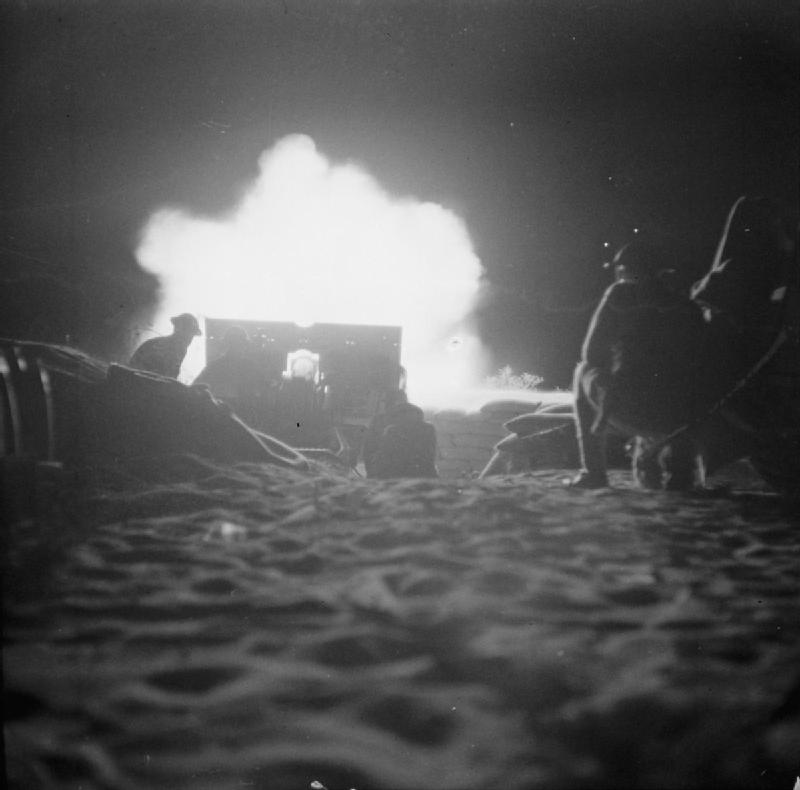 Map: Second Battle of El Alamein, Deployment of Forces on October 23rd, 1942 Map: Second Battle of El Alamein, Deployment of Forces on October 23rd, 1942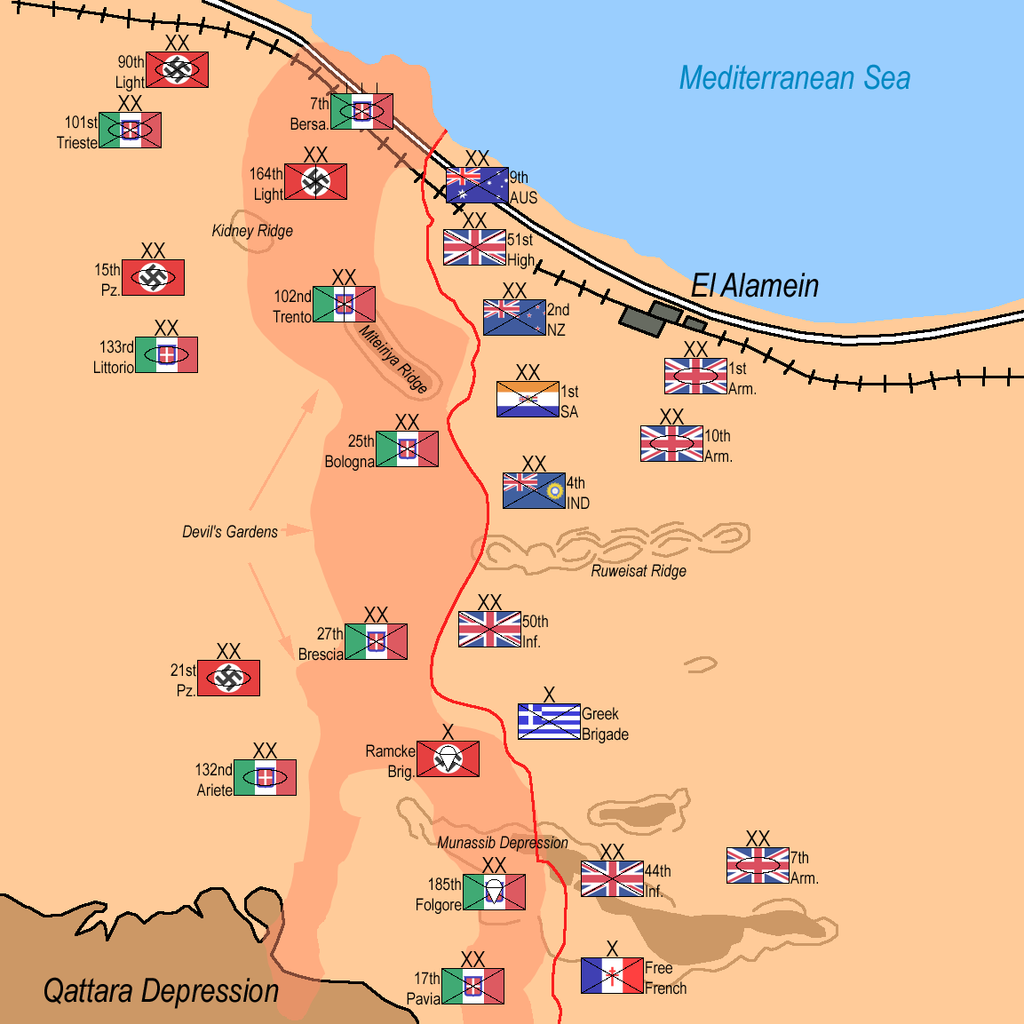 At 21.40 hours precisely the assault opened with an artillery barrage by 1,000+ guns aimed at Axis batteries; the desert silence was rent by the crash of 1,000 heavy guns, so powerful that the ground shook under the feet of the engineers who moved forward into the "Devil's Garden" - Rommel's 5 mile deep minefields - clearing lanes and marking them with white tape. The first barrage lasted for 15 minutes. At 2200 hours, the barrage switches to the forward positions as British troops move forward. For a few seconds before 22.00 hours, the skirl of bagpipes could be heard down the lines before an even more intensive bombardment opened up. This was the cue for the infantry to begin its advance with the 51st Highland, 1st South African and New Zealand Divisions, their bayonets fixed, going forward at a steady 75 strides a minute to clear the way for the waiting armoured divisions. The speed of the Highlander's advance brought them under fire from their own artillery as well as the German's. Casualties were high but they managed to storm their first objective, the heavily-defended Miteiriya Ridge. Everything depended on the tanks of XXX Corps, - new Grants and Shermans -breaking through. But so many tanks were trying to get through that a massive traffic snarl-up was blocking the lanes, a perfect target for German artillery. Monty intervened and soon the tanks were moving again. Map: Second Battle of El Alamein, The Allied Forces attack: 10pm- October 23rd, 1942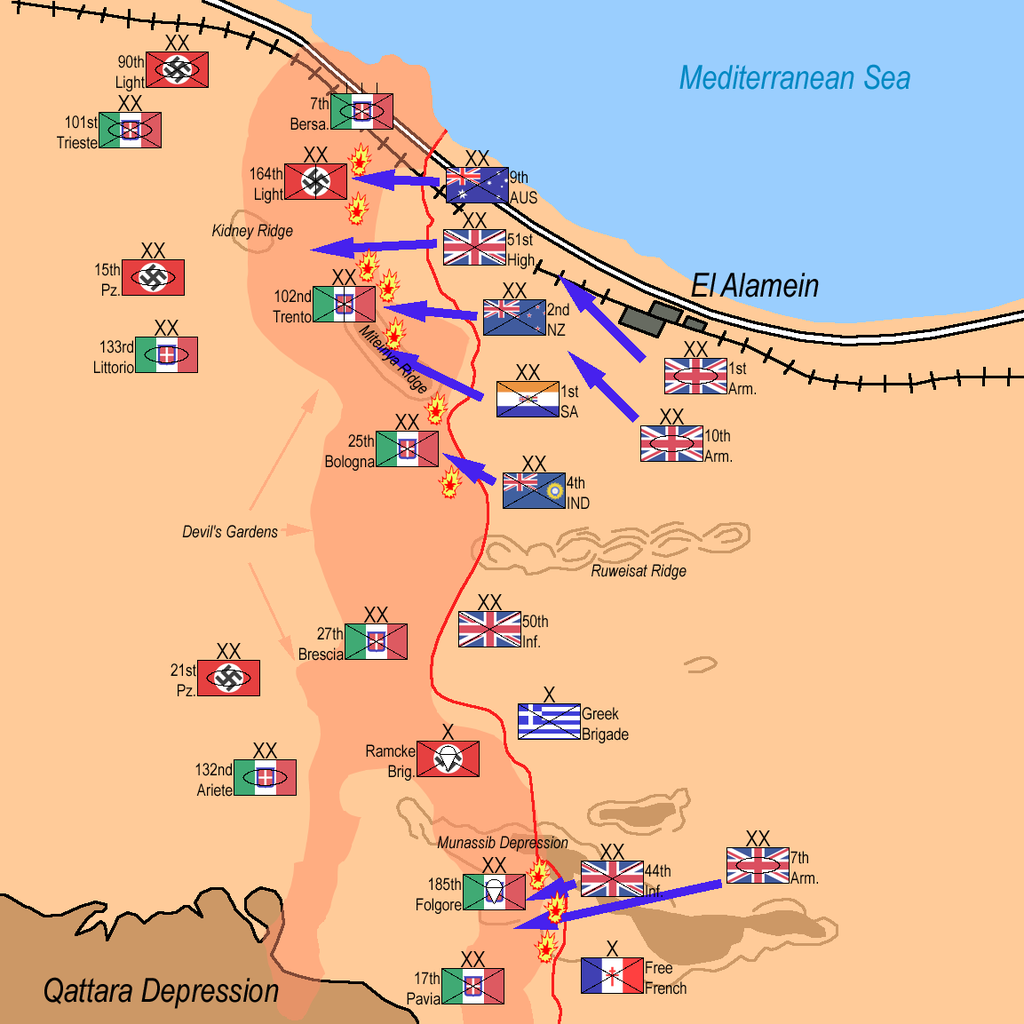 The 12 Italian and German divisions amounted to 80,000 men (53,000 of which are Italian). The Commonwealth forces amount to 230,000 men divided among ten divisions. As far as the tanks are concerned, only the German Panzer IV (35 total) are equal to the Commonwealth' s American M4 Sherman (252 total) and M3 Grant (170 total) tanks. The British attack the sector defended by the Italian Folgore Parachute Division. The Italian forces include 3,500 paratroopers, 1,000 Guastatori d'Africa, 80 artillery pieces and five tanks of German origin. The Folgore prepare their defenses among a 15 kilometer (9.3 mile) barrier and realize they are the last defense before the rear of the Italo-German Army. The British are thrown back after every attempt with a considerable loss of life and are ordered a stop any further initiatives on that front. Total dead, wounded or missing amount to 1,100 for the Folgore. Progress was slow at first and the battle became a straight slogging match. Australian troops played an important part with a thrust in the north near the sea. In the build-up to the battle, Royal Navy submarines and RAF aircraft, especially those based in Malta, were sinking more than a third of Axis supplies setting out for North Africa. As the offensive got underway, the Inshore Squadron continued to support and supply Eighth Army along its right, seaward flank. Heavy fighting continued during the night of 23/24 October with XXX Corps on the north making the main effort and XIII Corps conducting diversionary actions on the south. US Army, Middle East Air Force bombers sent to attack and Bengasi turn back short of the target due to bad weather. RAF and USAAF fighter aircraft maintain constant air patrols over Axis airfields after a four-day bombing campaign wipes out most of the opposing forces. Photo: Kittyhawk Mark III, FR241 LD-R, of No. 250 Squadron RAF, taxying at LG 91, Egypt, during Operation LIGHTFOOT, the first phase of the Alamein offensive. FR241 is an early short-tail Mark III with a dorsal fin, which also served later with No. 112 Squadron RAF Admiral Francois Darlan, Commander in Chief of the Armistice (Vichy) Army, arrives in Rabat to rally Vichy colonies. United States Forces from the U.S. begin a movement to North Africa in preparation for Operation TORCH, the invasion of northwest Africa. The first detachment of the Western Naval Task Force, under Rear Admiral Henry K. Hewitt, sails from Hampton Roads, Virginia. Pacific WarALEUTIAN ISLANDS CAMPAIGN Armed reconnaissance by seven USAAF Eleventh Air Force bombers, escorted by six P-38 Lightnings, is flown over Japanese-held Kiska Island installations, chiefly the submarine base and Main Camp; visibility is excellent and direct hits are scored, including one on the submarine base. A detachment of the 56th Fighter Squadron, 54th Fighter Group, based at Harding Field, Louisiana, begins operating from Elmendorf Field, Anchorage with P-39s. BISMARCK ARCHIPELAGO During the night of 23/24 October, USAAF Fifth Air Force B-17's attack shipping at Rabaul on New Britain Island. BURMA Advance units of British forces reach Buthidaung. A brief skirmish with the Japanese, who have advanced from Akyab, leaves the Japanese units in control of the town. NEW GUINEA CAMPAIGN In Papua New Guinea, Australian troops attack the Japanese at Eora Creek on the Kokoda Track but are unable to break through the Japanese lines. In the air, USAAF Fifth Air Force A-20's bomb and strafe Deniki and the Deniki-Kokoda Track. HQ 19th BG (Heavy), which has been fighting since 8 Dec 41, begins a movement from Mareeba to the US. NEW HEBRIDES ISLANDS Japanese submarine HIJMS I-7 shells Espiritu Santo Island. PACIFIC OCEAN USN submarine USS Kingfish sinks a gunboat off the coast of Japan about 89 nautical miles (165 kilometers) south of Osaka, Honshu, in position 33.12N, 135.14E. A PBY Catalina spots a Japanese fleet carrier heading for Guadalcanal Island, Solomon Islands. Three PBYs mount a night attack against the carrier and escorting ships but the attack is unsuccessful. This carrier will meet USN forces in the Battle of Santa Cruz Islands on 26 October. SOLOMON CAMPAIGN Henderson Field, Guadalcanal, is again made operational by the Seabees, and USMC and AAF fighters begin to inflict heavy losses on Japanese naval aircraft. A raid of 16 "Betty" bombers with 17 "Zeke" fighters " escorting is intercepted by 24 USMC and USN F4F Wildcats and four USAAF P-39 Airacobras at about 1130 hours. The American pilots claim 23 "Bettys" (of the 16 that attacked!) And two "Zekes." The Japanese soldiers south of Henderson Field drop their packs and move out for the starting points. Many scouts fail to return, others report jungle in every direction. By midafternoon, most advance units are still in thick jungle. Lieutenant General Kawaguchi Kiyotake, commander of the 35th Brigade, changes his part of the attack plan, moving east. Lieutenant General Maruyama Masao, commander of the 2nd Division, orders no changes are allowed. Kawaguchi argues and Maruyama dismisses him from his command. At 1800 hours, the Japanese artillery barrage begins with the heaviest fire to date. The attack, under Colonel Nakaguma Tadamasu, commander of the 4th Infantry Regiment, makes a determined but futile efforts to cross the Matanikau River mouth and overrun the 3d Battalion of the 1st Marine Regiment. The attack begins with nine tanks moving out. Marine anti-tank guns take on the tanks. Four batteries of Marine artillery respond. The Japanese sustain heavy losses: 600 are estimated killed and at least eight tanks are knocked out. The Marine casualties are 25 killed and 14 wounded. The attacks by Colonel Oka and General Maruyama which are supposed to start at the same time do not. They are still fighting the jungle.
|
|
lordroel
Administrator
Posts: 68,117 
Likes: 49,506
|
Post by lordroel on Oct 24, 2021 6:27:22 GMT
Day 1140 of World War II, October 24th 1942Air War over Europe Eight RAF Bomber Command Wellingtons lay mines off La Pallice. During the day, three RAF Bomber Command Mosquitos hit the Stork diesel engine factory at Hengelo with the loss of one aircraft. During the night of 23/24 October, six RAF Bomber Command Wellingtons lay mines off Stavanger; one aircraft is lost. Battle of the Atlantic German submarine U-599 is sunk about 500 nautical miles (927 kilometers) southwest of Cork, County Cork, Eire, by depth charges from an RAF Liberator Mk. II, aircraft of No. 224 Squadron based at RAF Bealieu, Hampshire, England; all 44 crewmen are lost. Battle of the MediterraneanThe first daylight attack on Italy was mounted by British-based RAF Lancaster Bombers (Whitley's first bombed Italy, staging through the Channel Islands in 1940), when bombers of RAF No. 5 Group were dispatched to attack Milan. During the previous night, 100 Lancasters attacked Genoa and today a total of 112 machines flew below barrage balloons to hit Milan in broad daylight. The aircraft proceed independently by a direct route across France, using partial cloud cover, to a rendezvous at Lake Annecy, France. The Alps are then crossed and Milan bombed in broad daylight. Defences are weak and accurate bombing takes place. The raid came as a complete surprise in Milan. One hundred thirty five tons (122 metric tonnes) of bombs fall in 18 minutes and 30 large fires are started; 441 houses are destroyed or damaged. R.A.F. reconnaissance photographs later discover that a number of commercial and industrial buildings are also hit, including the Caproni aircraft factory. At least 171 people are killed. Three Lancasters were lost enroute, 1 near the target and 2 over northern France. Another crashed in the UK. A Lancaster pilot said later; "We crossed the Channel at almost zero altitiude and over France in one enormous mass at 50 feet. The French waved to us." They flew over the Alps below the summit of Mont Blanc, found Italy under cloud and emerged through this at 4,000 feet over Milan railway station. Another crew flew over the football stadium at half-time, the ball clearly visible in the net. When they released their 4,000 lb "cookies", there was panic below them. One pilot described hitting a factory; "That's a factory, that was!" The sun was setting over the Alps as they began the 750 mile flight home. Fw. Gerhard Schmalenberg and Uffz. Walter Leber from 3./JG 2 claimed 2 of the Lancasters. This raid formed part of a series aimed at Italian targets, timed to coincide with the opening of Eighth Army's El Alamein offensive. During the night of 24/25 October, Milan is again hit; 71 aircraft, 25 Halifaxes, 23 Stirlings and 23 Wellingtons, are dispatched; 43 bomb the city. Four Wellingtons and two Stirlings are lost, 8.5 per cent of the force. Storms en route disperse the bomber force; some aircraft fly over Switzerland and are "warned" by anti-aircraft fire. Local reports say that little further damage is caused. North African campaignMap: Second Battle of El Alamein, The Axis Armoured Divisions counterattack: 6pm- October 24th, 1942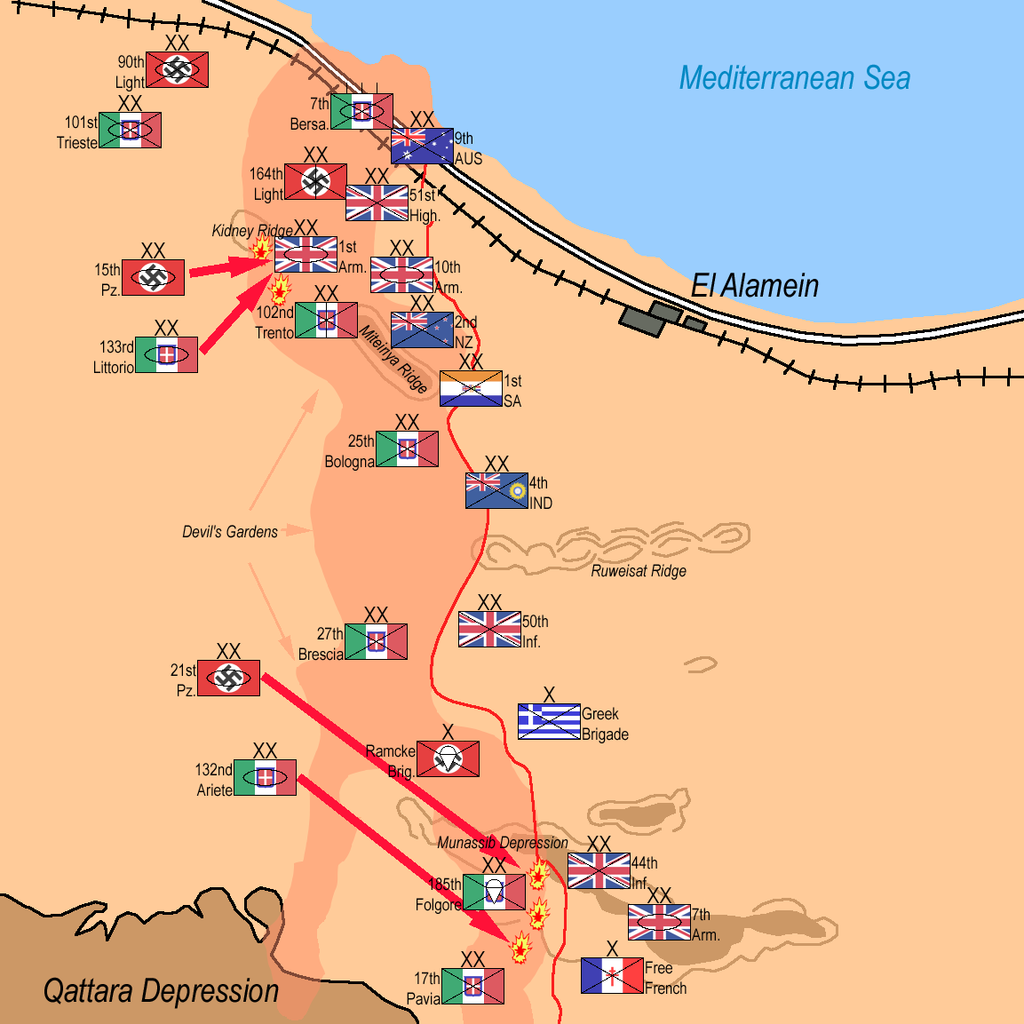 Around midnight last night, General Montgomery and 195,000 Allied troops of the British Eighth Army began their long awaited attack against German positions and Feldmarschall Rommel. The British hold a 2:1 advantage in tanks, men, guns and air support. The XXX Corps will push its infantry through the minefields; X Corps with the 2nd Armoured Divisions will follow and hold off counterattacks while the infantry widens the hole in the German line. British forces make progress but do not keep to the timetable. The intial British attack was by 4 infrantry divisions of XXX Corps (2 NZ, 51 Highland, (Aust., and 3 South African) abreast on a narrow front. But they encountered very thick minefields and well prepared Axis positions. The German 164 Division and Italian Trento Division with support from 15.Panzerdivision and Littorio Division recieved the main attack. The German armor is grouped in two areas due to lack of fuel. German and Italian units have been mixed on the line by Rommel to provide reliable German contingents everywhere. British forces did not achieve their objectives but were not far short. Rommel was in Germany and General Stumme was in command. During a visit to the front, Stumme died of a heart attack. The German reaction to the attack was delayed and inconsistant. XXX Corps secured the 2 corridors through the German minefields on the northern flank while XIII Corps on the southern flank broke through minefield north of Himeimat and established a small bridgehead. By 0700 hours, Freyburg (GOC 2 NZ Division) felt that the armoured breakout was still possible, but only if; "....a supreme and immediate effort were made."He recced the routes and made the plan himself - X Corps' 8th Armoured brigade would open the way. X Corps and its division commanders dithered, then decided that more support was needed for such an attack to be assured of success. The opportunity slipped away. B-25s supported the British offensive west of El Alamein between the Med Sea and the Qattara Depression. The B-25s hit troop concentrations, tent areas, gun emplacements and vehicles. P-40s, working with the RAF and SAAF, escorted medium and light bombers and hit motor transports and tanks. Photo: A Grant tank crew of the Staffordshire Yeomanry, 8th Armoured Brigade cleaning the guns of their vehicle, 24 October 1942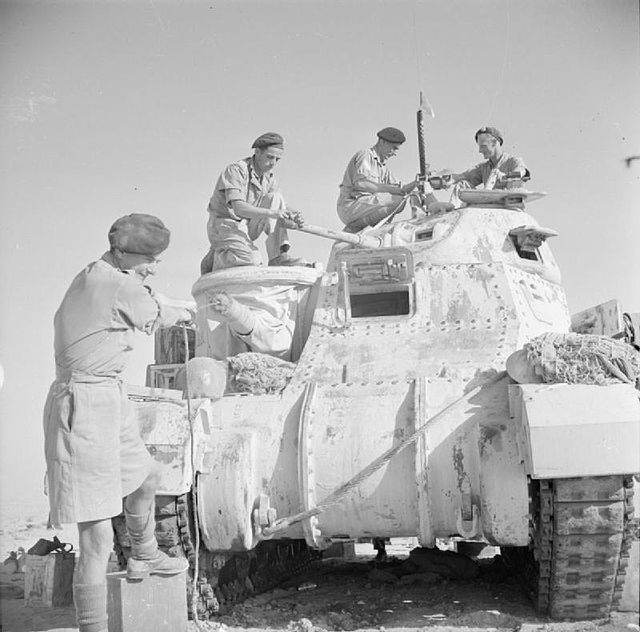 Photo: Sherman tanks of The Queen's Bays (2nd Dragoon Guards), 1st Armoured Division, at El Alamein, 24 October 1942 Photo: Sherman tanks of The Queen's Bays (2nd Dragoon Guards), 1st Armoured Division, at El Alamein, 24 October 1942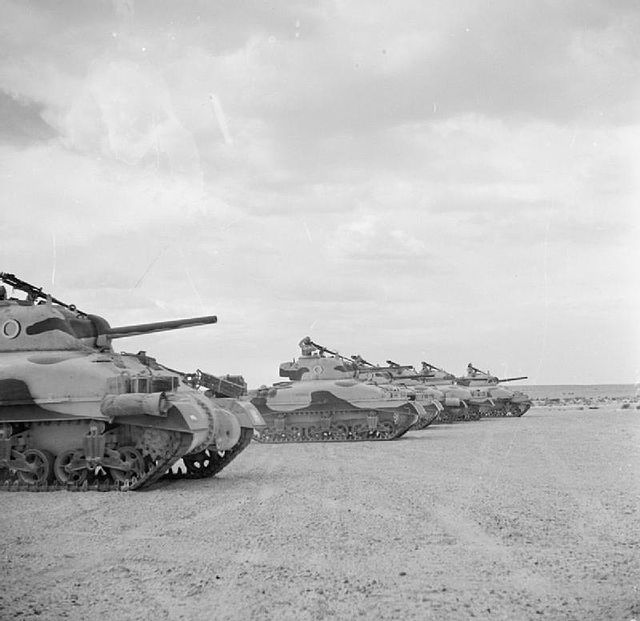 Photo: Crews climb aboard Sherman tanks of The Queen's Bays (2nd Dragoon Guards), 1st Armoured Division at El Alamein, 24 October 1942 Photo: Crews climb aboard Sherman tanks of The Queen's Bays (2nd Dragoon Guards), 1st Armoured Division at El Alamein, 24 October 1942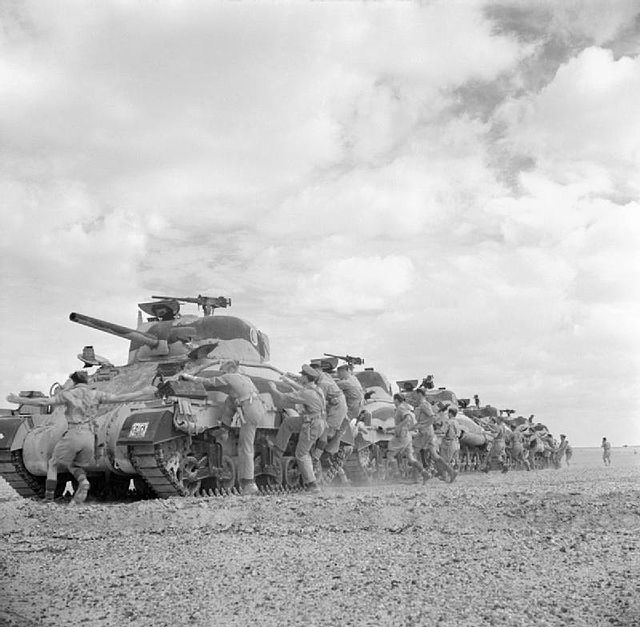 Photo: El Alamein 1942: British tanks move up to the battle to engage the German armour after the infantry had cleared gaps in the enemy minefield Photo: El Alamein 1942: British tanks move up to the battle to engage the German armour after the infantry had cleared gaps in the enemy minefield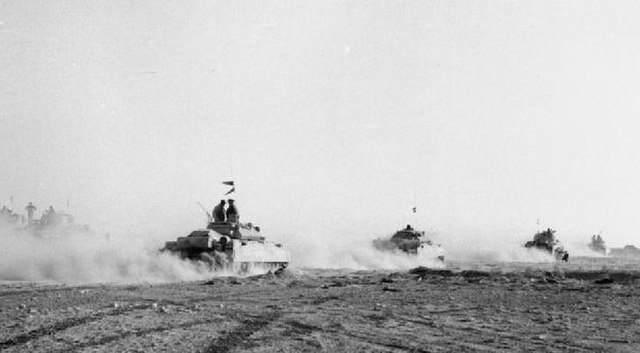 United States United States The final detachment of the Western Naval Task Force sails from Hampton Roads, Virginia for North Africa. The covering group of warships sails from Casco Bay, Maine. Photo: The U.S. Navy destroyer USS Chevalier (DD-451) in Boston harbor, Massachusetts (USA), on 24 October 1942 just prior to departing to escort a convoy during the invasion of North Africa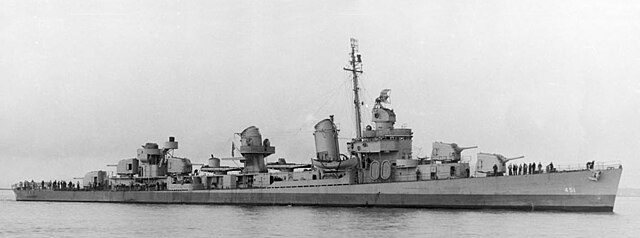 Pacific War Pacific WarALEUTIAN ISLANDS CAMPAIGN The Japanese decide to abandon Attu and move the troops to Kiska. The Americans are unaware of this, and never know they could have taken the island without a shot. Kiska, however, is being turned into a fortress, with underground bunkers, flak guns, and midget submarine pens. Three USAAF Eleventh Air Force B-17's hit the Japanese-held Kiska Island submarine base; results are not observed; and a weather reconnaissance flight is made over Attu Island. D'ENTRECASTEAUX ISLANDS Organized resistance against Australian troops on Goodenough Island ceases; 250 Japanese are withdrawn to Rabaul, New Britain Island, Bismarck Archipelago, by destroyers after nightfall. CHINA-BURMA-INDIA The 11th Bombardment Squadron, 341st BG (Medium), based at Kunming with B-25s, sends a detachment to operate from Nanning. NEW GUINEA CAMPAIGN In Papua New Guinea, the Australian 16th Brigade, 7th Division, continues to drive the Japanese back along the Kokoda Track but meets heavy resistance at Eora Creek. Meanwhile, after an exhausting overland journey, the head of the U.S. 2d Battalion, 126th Infantry Regiment, 32d Infantry Division, reaches Jaure. From there the force is to move to the Buna area via Natunga and Bofu, with the antitank and Cannon Companies protecting its rear and harassing the Japanese in the Wairopi area. In Northeast New Guinea, USAAF Fifth Air Force B-25's hit Lae Airfield. PACIFIC OCEAN At 1245 hours, two U.S. naval aircraft carrier forces, comprised of USS Enterprise and Hornet, rendezvous about 288 nautical miles NE of Vila, Efate Island, New Hebrides Islands, and come under command of Rear Admiral Thomas C. Kinkaid, commander of Task Force 16. USN submarine USS Nautilus sinks a Japanese cargo ship about 45 nautical miles ENE of Aomori, Honshu, Japan, in position 41.10N, 141.38E. SOLOMON CAMPAIGN On Guadalcanal, a Japanese column is observed east of the Matanikau River on the foothills of Mt Austen in the afternoon and bombarded by artillery and aircraft with unobserved results. Shortly after midnight 24/25 October, a regiment of the main Japanese assault force attacks the southern flank of the Lunga perimeter, where 1st Battalion of the 7th Marine Regiment is thinly spread along a 2,800-yard front, the 2d Battalion having been withdrawn to plug a gap between the Lunga perimeter and the forward positions along the Matanikau River. Marines, assisted by fire of adjacent troops, the 2d Battalion of the 164th Infantry Regiment, and reinforced during night by the 3d Battalion of the 164th Infantry Regiment, hold against repeated attacks, and the Japanese retire during the morning of 25 October. USMC and USAAF fighters at Henderson Field, Guadalcanal Island, continue to inflict damaging losses upon the Japanese naval air force; Japanese ground forces, attacking aggressively, are again repulsed by defenses around Henderson area.
|
|
lordroel
Administrator
Posts: 68,117 
Likes: 49,506
|
Post by lordroel on Oct 25, 2021 2:48:57 GMT
Day 1141 of World War II, October 25th 1942Eastern Front The German III.Panzerkorps begins their attack south of the Terek River in the Caucasus. Air War over Europe RAF Bomber Command forms No. 6 (Royal Canadian Air Force) Group, Bomber Command. All squadrons in the Group are manned by Canadian airmen. During the day, RAF Bomber Command dispatches 12 A-20 Bostons to Le Havre to attack the large merchant ship there but they have to turn back because of lack of cloud cover. North African campaignThe Battle of El Alamein continues as General Bernard L Montgomery, General Officer Commanding British Eighth Army, decides to make the main effort on the northern flank of XXX Corps; the Australian 9th Division drives north toward the coastal road to Rahman; It makes impressive gains which attract Field Marshal Erwin Rommel's attention when he returns from Germany. By the end of the day the British X Corps has lost about 250 tanks, but the German 15.Panzerdivision has only 40 tanks left. The British 1st Armoured Division, attempting to push west in the Kidney Ridge area, is unable to advance. A series of determined Axis counterattacks with strong tank support is repulsed. In the XIII Corps sector, the 50th Division attempts to improve their positions in the Munassib area with little success. Map: Second Battle of El Alamein: Allied 1st Armoured Division and 51st Highland Division attack German 164th Light Division: 12am- October 25th, 1942. Allied 7th Armoured Division attacks Italian Folgore Parachutist Division: 1pm- October 25th, 1942 Map: Second Battle of El Alamein: 1st Armoured Division is counterattacked by Littorio Armoured Division and 15th Panzer Division. 1st Armoured Division and 51st Highland Division break off their attack: 3:30pm- October 25th, 1942. 7th Armoured Division breaks off its attack on Folgore Parachutist Division. 9th Australian Division attacks 164th Light Division: 9:30pm- October 25th, 1942 Map: Second Battle of El Alamein: 1st Armoured Division is counterattacked by Littorio Armoured Division and 15th Panzer Division. 1st Armoured Division and 51st Highland Division break off their attack: 3:30pm- October 25th, 1942. 7th Armoured Division breaks off its attack on Folgore Parachutist Division. 9th Australian Division attacks 164th Light Division: 9:30pm- October 25th, 1942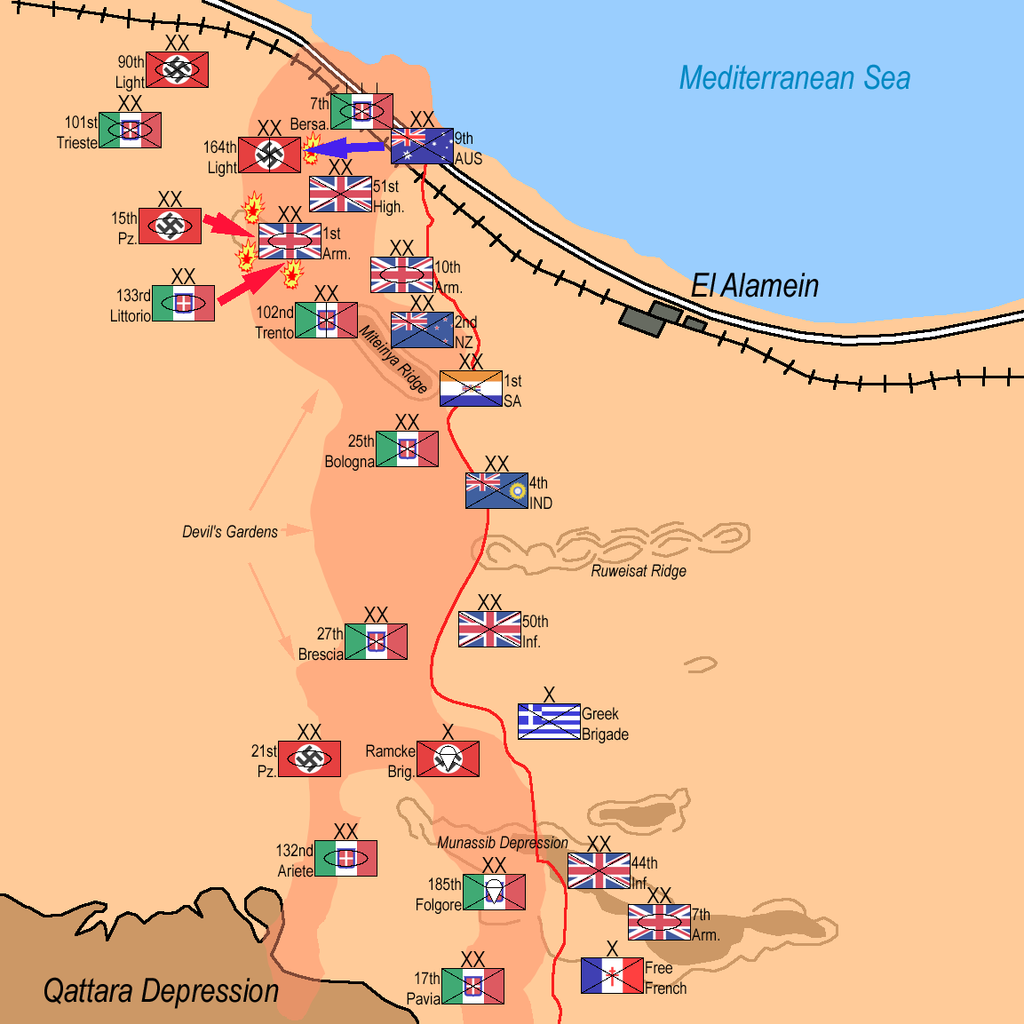 Map: Second Battle of El Alamein: 7th Armoured Division, 44th Infantry Division, 50th Infantry Division along with the Greek 1st Infantry Brigade and the Free French Brigade attack Folgore Parachutist Division from three directions: 10:30pm- October 25th, 1942 until 3am- October 26th, 194 Map: Second Battle of El Alamein: 7th Armoured Division, 44th Infantry Division, 50th Infantry Division along with the Greek 1st Infantry Brigade and the Free French Brigade attack Folgore Parachutist Division from three directions: 10:30pm- October 25th, 1942 until 3am- October 26th, 1942  Map: Second Battle of El Alamein: 7th Bersaglieri Regiment attacks 9th Australian Division: 8am- October 26th, 1942. 51st Highland Division takes Kidney Ridge, further advance stoped by counterattack north of Kidney Ridge by Littorio Armoured Division: 5pm- October 26th, 1942. 2nd New Zealand Division and 1st South African Division advance 1km against Trento Division: 5:30pm- October 26th, 1942 Map: Second Battle of El Alamein: 7th Bersaglieri Regiment attacks 9th Australian Division: 8am- October 26th, 1942. 51st Highland Division takes Kidney Ridge, further advance stoped by counterattack north of Kidney Ridge by Littorio Armoured Division: 5pm- October 26th, 1942. 2nd New Zealand Division and 1st South African Division advance 1km against Trento Division: 5:30pm- October 26th, 1942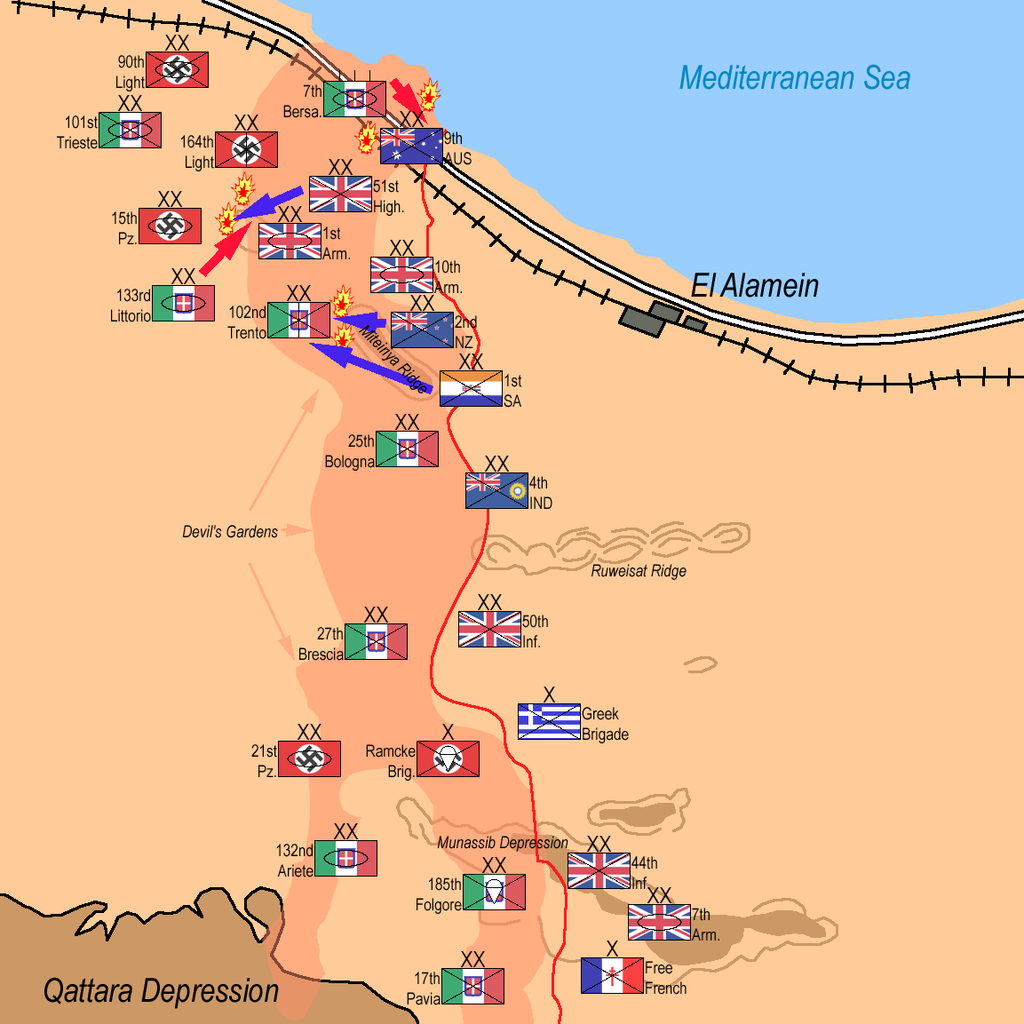 Photo: El Alamein: Distant view of a tank battle on Miteiriya Ridge showing a British tank on fire during the evening of 25 October 1942 Photo: El Alamein: Distant view of a tank battle on Miteiriya Ridge showing a British tank on fire during the evening of 25 October 1942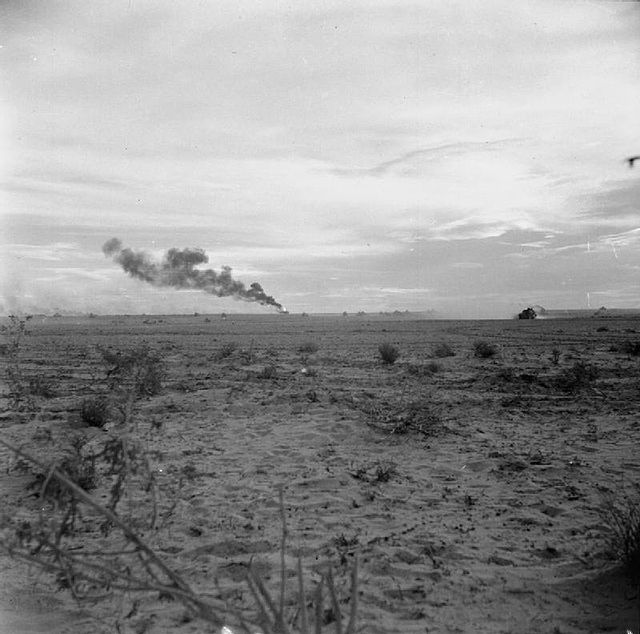 U.S. Army, Middle East Air Force B-25's disperse motor transport and other targets in support of ground forces; P-40s on escort attack vehicles and other targets; fighters claim several airplanes destroyed in combat. YouTube (British El Alamein Offensive - 1942)U.S. Army, Middle East Air Force B-25's disperse motor transport and other targets in support of ground forces; P-40s on escort attack vehicles and other targets; fighters claim several airplanes destroyed in combat. Pacific WarBISMARCK ARCHIPELAGO Thirteen USAAF Fifth Air Force B-17's bomb shipping at Rabaul, New Britain Island. CHINA Twelve B-25s and seven P-40s of the USAAF Tenth Air Force's China Air Task Force (CATF), hit Kowloon Docks at Hong Kong; 21 aircraft intercept and a B-25 and a P-40 are shot down; this marks the first loss of a CATF B-25 in combat; the Japanese interceptors are virtually annihilated; during the night of 25/26 October, six B-25s, on the first CATF night strike, continue bombing Hong Kong, hitting the North Point power plant which provides electricity for the shipyards; three other B-25s bomb the secondary target, the Canton warehouse area, causing several large explosions and fires. INDIA AIR TASK FORCE In India, Japanese aircraft attack airfields connected with the the India-China air transport route, heavily bombing Dinjan and Chabua fields and scoring hits also at Mohanbari and Sookerating;10 US aircraft are destroyed and 17 badly damaged; 9 Japanese aircraft are downed. The 492d Bombardment Squadron, 7th BG (Heavy),arrives at Karchi, India from the US with B-24s; and the 493d BombardmentSquadron is activated at Karachi and assigned to the 7th BG (the 492d and 493d will fly their first mission on 24 and 26 Jan 43 respectively). NEW GUINEA CAMPAIGN In Papua New Guinea, USAAF Fifth Air Force A-20 Havocs bomb and strafe the Isurava-Kokoda Track, the west bank of the Kumusi River, and the area north of Asisi as Australian ground forces push toward Kokoda in the Owen Stanley Range. HQ 38th BG (Medium) and the 405th Bombardment Squadron move from Townsville to Port Moresby with B-25s. The 93d Bombardment Squadron, 19th BG (Heavy), begins a movement from Mareeba to the US. PACIFIC OCEAN USN submarines are active off Japan: - At 1100 hours, USS Nautilus sinks a sampan about 201 nautical miles ESE of Sapporo, Hokkaido, Japan, in position 41.45N, 145.32E. - USS Whale lays mines off Honshu, Japan, at the entrance to Inland Sea and later sinks an armed tanker about 68 nautical miles SSE of Tokushima, Shikoku, Japan, in approximate position 33.00N, 135.00E. CORAL SEA In the Coral Sea during the afternoon, a USAAF B-17 on a sea-search mission sights a powerful Japanese Task Force northwest of Santa Cruz Island, Solomon Islands, heading for Guadalcanal. With the Japanese Army bogged down in the jungles of Guadalcanal for the past several days, the Japanese Navy must take action or return for fuel. Their aircraft carriers Shokaku, Zuikaku, Zhiho and Junyo, with supporting ships, are steaming northeast of Guadalcanal. The USN has the aircraft carriers USS Hornet and Enterprise with escorts. The Japanese have 199 operational aircraft with the U.S. carriers showing 133 operational aircraft. With both sides receiving assistance from land based aircraft, they have spotted both sides carriers. The Battle of the Santa Cruz Islands will occur tomorrow. SOLOMON CAMPAIGN The Japanese Army on Guadalcanal finally reach the Marine Defensive Line, south of Henderson Field in force, between 0000 and 0100 hours. The battle first involves the 1st Battalion 7th Marine Regiment and the machine guns of Sergeant John Basilone keep the Japanese off balance. Basilone is later awarded the Medal of Honor for action this night. As the battle progressed, Lieutenant Colonel Lewis (Chesty) Puller, Commanding Officer 1st Battalion, brings in his reserves, platoons of the Army's 3d Battalion, 164th Infantry Regiment. By 0200 hours, the entire 3d Battalion is ordered to the line. The soldiers are placed with Marines rather than as a unit. The attack continues until dawn with the center of the line pulling back and absorbing the attack. Isolated small groups of Japanese have gotten through the line. Marine patrols find 67 Japanese during the day; 300 more Japanese have fallen in front of the Marine Lines. Artillery and mortars have claimed uncounted soldiers in the jungle and woods beyond the perimeter. The daylight occupies the Americans with four air strikes, between 1420 and 1515 hours, from Rabaul, New Britain Island, Bismarck Archipelago, and naval bombardments. The first is from a cruiser, five destroyers and a minelayer. The Japanese move in and sink the tug USS Seminole and patrol craft YP-284 which are unloading aviation gasoline, howitzers, and marines about 3.5 miles E of Lunga Point. Three Japanese destroyers take the two ships under fire and sink both of them. Shortly after beginning the Japanese bombardment, a Marine battery hits a gun mount on the destroyer Akatsuki which retires under a smoke screen. During this retirement the Cactus Air Force has four F4F Wildcats of Marine Fighting Squadron VMF-121 strafe them. The second Japanese bombardment fleet is spotted by the Cactus Air Force and five SBDs of Scouting Squadron VS-71 attack at 1300 hours. Light cruiser Yura is struck with a 1,000 pound and a 500 pound bomb and destroyer Akizuki suffers a near miss. Two more attacks from the Cactus Air Force do no damage. Then an attack from five SBDs of VS-71, four USAAF P-39s with bombs and three F4Fs, followed immediately by an attack from six USAAF B-17's finishes off light cruiser Yura and damage another destroyer. The Japanese raid, at 1500 hours hits the Henderson Field graveyard of wrecked aircraft. Losses include ten "Zeke" fighters, two "Betty" bombers and two F4Fs. The Wildcat pilots are rescued. Today will become known as Dugout Sunday on Guadalcanal. At 1930 hours, Japanese artillery begins firing on Marine positions near the coast on the west side of the perimeter. Between 2000 and 2400 hours, the Japanese column fights the jungle to reach their attack positions. The Marines of the 1st Battalion, 7th Marine Regiment and soldiers of the 3d Battalion, 164th Infantry Regiment sort out their units and settle in their sector, south of Henderson Field. At 2000 hours, Japanese artillery fire hits this sector for about an hour and this is followed by three hours of small actions against the American line with groups of 30 to 200 Japanese attacking piecemeal.
|
|
lordroel
Administrator
Posts: 68,117 
Likes: 49,506
|
Post by lordroel on Oct 26, 2021 2:43:34 GMT
Day 1142 of World War II, October 26th 1942Eastern Front Nalchik in the Caucasus falls to the German Heeresgruppe A. Again, the Romanian 2nd Mountain Division plays a central role in these operations, taking 3,000 Soviet prisoners (and helping the Germans to trap an even larger Soviet force) while suffering 820 casualties. The 2nd Mountain Division also fought off a rather understrength Soviet offensive in the Nalchik area in January '43. Air War over Europe During the night of 26/27 October, 39 RAF Bomber Command aircraft lay mines off French ports: 12 in the Gironde Estuary, six each off Brest and Lorient and St. Nazaire, five off Bayonne, and four off St. Jean de Luz. During the night of 26/27 October, two RAF Bomber Command aircraft lay mines in the Frisian Islands. Battle of the MediterraneanOver 30 U.S. Army Middle East Air Force B-17's and B-24's attack shipping off the coast of Libya. North African campaignThe momentum of the British Eighth Army's drive decreases in the El Alamein battle; XXX Corps takes Kidney Ridge, and General Bernard L Montgomery, commander of the Eighth Army, decides to regroup for a breakout assault. British General Montgomery halts most of his forces to regroup, after making little headway during the second day of his offensive at El Alamein. Most of the action has revolved around Rommel's reactions and German counterattacks, as Rommel moves his forces north. Map: Second Battle of El Alamein: 7th Bersaglieri Regiment attacks 9th Australian Division: 8am- October 26th, 1942. 51st Highland Division takes Kidney Ridge, further advance stoped by counterattack north of Kidney Ridge by Littorio Armoured Division: 5pm- October 26th, 1942. 2nd New Zealand Division and 1st South African Division advance 1km against Trento Division: 5:30pm- October 26th, 1942 Map: Second Battle of El Alamein: Both sides reorganize the deployment of their Forces: Night of October 26th to October 27th, 1942 Map: Second Battle of El Alamein: Both sides reorganize the deployment of their Forces: Night of October 26th to October 27th, 1942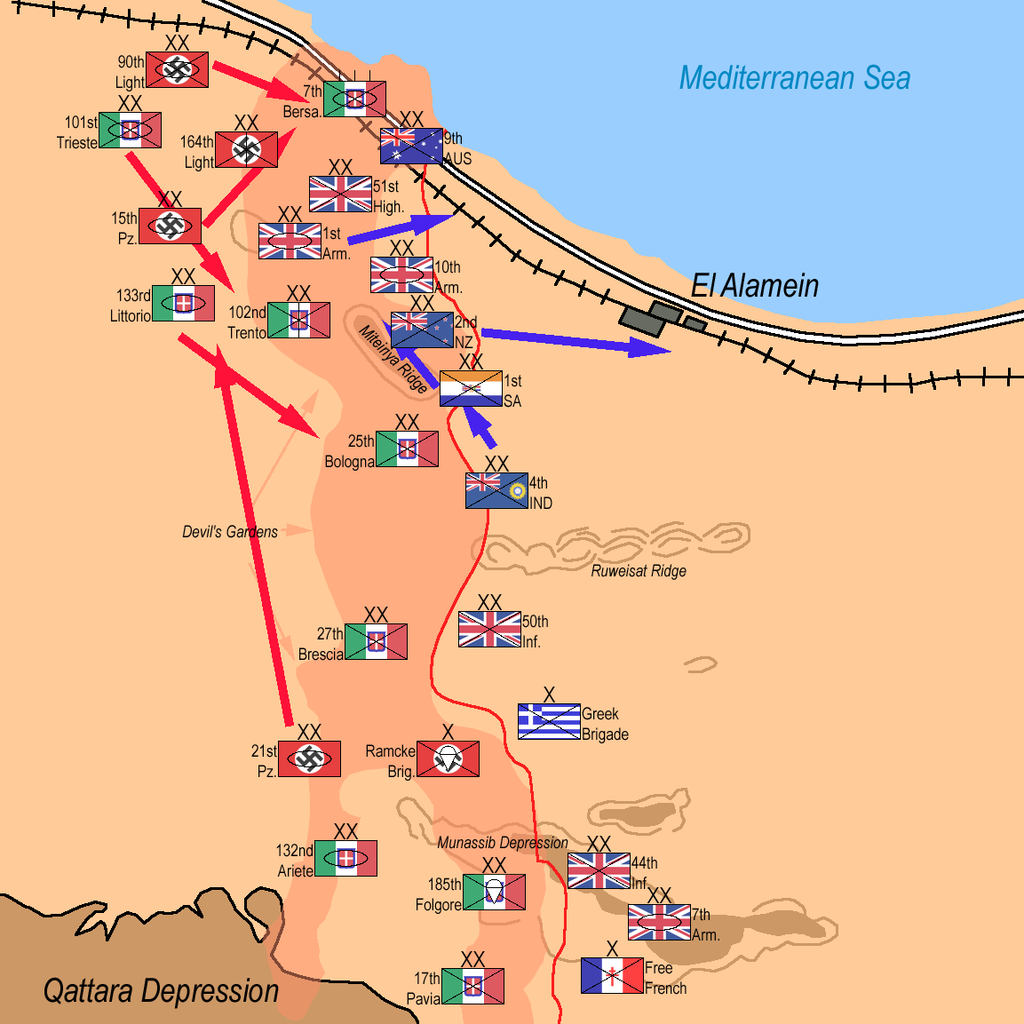 Allied aircraft continue strong support to ground forces and disperse enemy concentrations preparing for an attack. U.S. Army Middle East Air Force B-25's hit transport, troop concentrations, and tanks while P-40s fly sweeps over the El Daba area and attack motor transport and other targets. German air action increases and considerable aerial combat ensues and USAAF fighters claim four airplanes shot down. Captain Thomas W. Clark, a P-40 pilot with the 65th Fighter Squadron, 57th Fighter Group, USAAF, shoots down two Italian Macchi MC.202 Folgores (Lightnings) and becomes the first USAAF fighter pilot in the European Theater of Operations or North Africa to score a double victory. Photo: A Sherman tank of HQ 24th Armoured Brigade, with its 'sunshield' lorry camouflage erected, 26 October 1942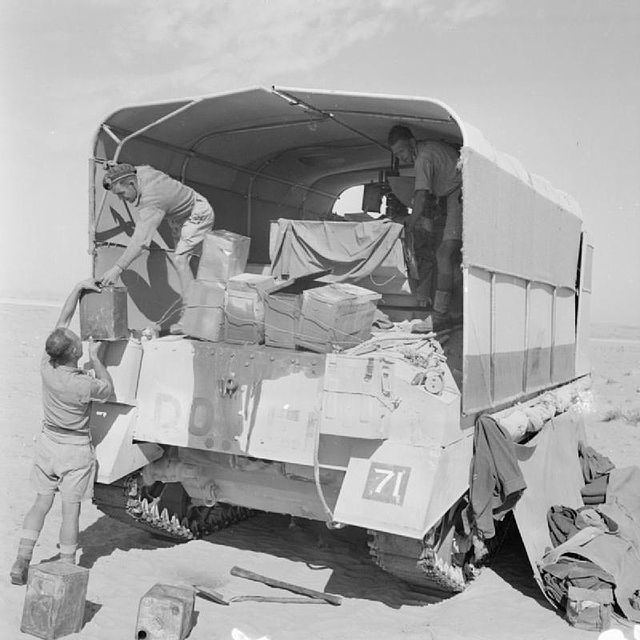 United States Photo: The U.S. Navy light cruiser USS Honolulu (CL-48) off the Mare Island Naval Shipyard, California (USA), on 26 October 1942 United States Photo: The U.S. Navy light cruiser USS Honolulu (CL-48) off the Mare Island Naval Shipyard, California (USA), on 26 October 1942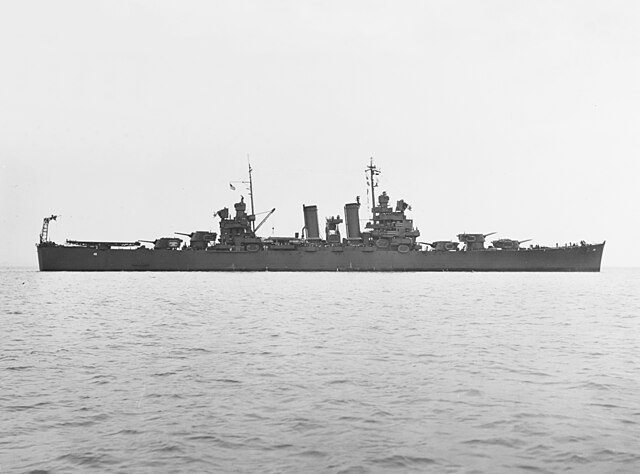 Pacific War Pacific War CHINA B-25's of the USAAF Tenth Air Force's China Air Task Force move to western China to carry out the neutralization of Lashio, Burma, where the Japanese have aircraft they are using against the Dinjan, India area; P-40s continue to hit the Hong Kong-Canton area, using dive-bombing tactics for first time in the area. INDIA The Japanese again bit airfields in Assam connected with the India-China air transport route, concentrating on Sookerating. A freight depot, containing food and medical supplies for China, is destroyed but no U.S. aircraft are lost. Due to a lack of warning, no fighters intercept the attacking force. NEW GUINEA CAMPAIGN In Northeast New Guinea, USAAF Fifth Air Force B-25's attack Salamaua and Lae Aerodromes. In Papua New Guinea, an A-20, escorted by P-40s, bomb and strafe trails in the Missima-Kaile-Deniki area. NEW HEBRIDES ISLANDS The 21,936 ton U.S. liner SS President Coolidge, chartered for use as a troop transport, blunders into a U.S. minefield off Espiritu Santo at 0930 hours and strikes two mines; the ship is beached to facilitate salvage, but slips into deep water and sinks. Four of the 5,050 Army troops are lost in the accident, as is one of the 290-man merchant complement. There are no casualties among the 51-man Armed Guard. Photo: The U.S. Navy fleet tug USS Navajo (AT-64) during rescue operations for the mined troop transport SS President Coolidge off Espiritu Santo, New Hebrides, on 26 October 1942. Note the Consolidated PBY in the background PACIFIC OCEAN - BATTLE OF SANTA CRUZ ISLANDS Battle of Santa Cruz Islands occurs as Task Force 16 (Rear Admiral Thomas C. Kinkaid) and TF 17 (Rear Admiral George D. Murray) engage a numerically superior Japanese force (Vice Admiral Nagumo Chuichi). Although the Japanese achieve a tactical victory, the failure of their simultaneous land offensive on Guadalcanal means that they cannot exploit it to its fullest. The dwindling number of Japanese carrier planes cannot eliminate Henderson Field, while fuel shortages compel the Combined Fleet to retire on Truk Island in the Caroline Islands. Photo: Mitsubishi Type 00 Shipboard Fighters (A6M2 Model 21. Allied codename: "Zeke") ready for takeoff from a Japanese aircraft carrier, 1942. This view was probably taken on board Shokaku as she prepared to launch aircraft in the morning of 26 October 1942, during the Battle of the Santa Cruz Islands. Japanese writing in lower right states that the image was reproduced by authorization of the Navy Ministry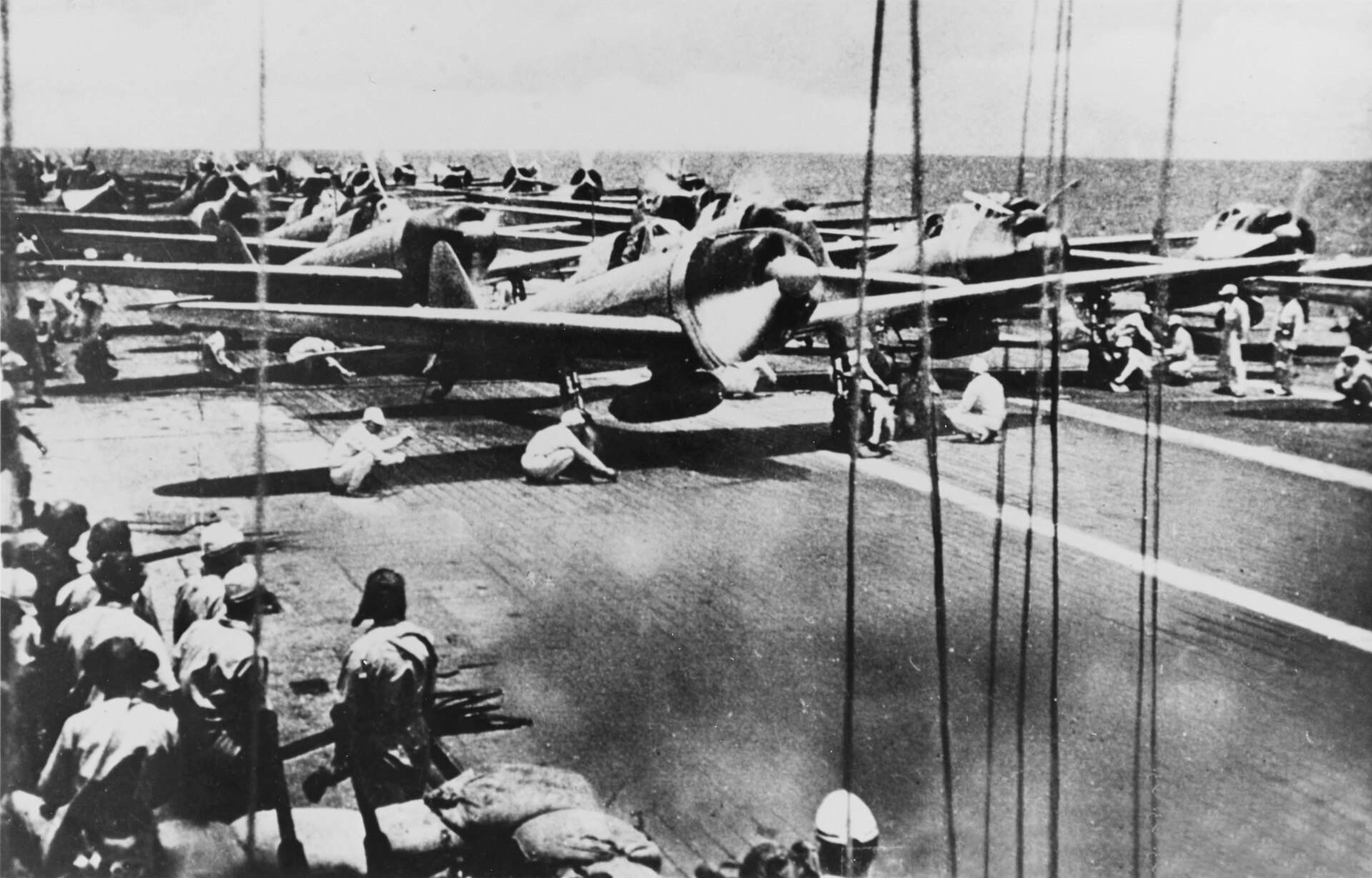
Photo: A TBF Avenger prepares for launch from USS Enterprise during the Battle of the Santa Cruz Islands, 26 October 1942. The sign visible beyond the plane's landing gear reads "PROCEED WITHOUT HORNET", indicating Enterprise's strike is not to wait to join up with a strike being launched by USS Hornet. The sign to the left reads "JAP 'CV' SPEED 25 AT 0830"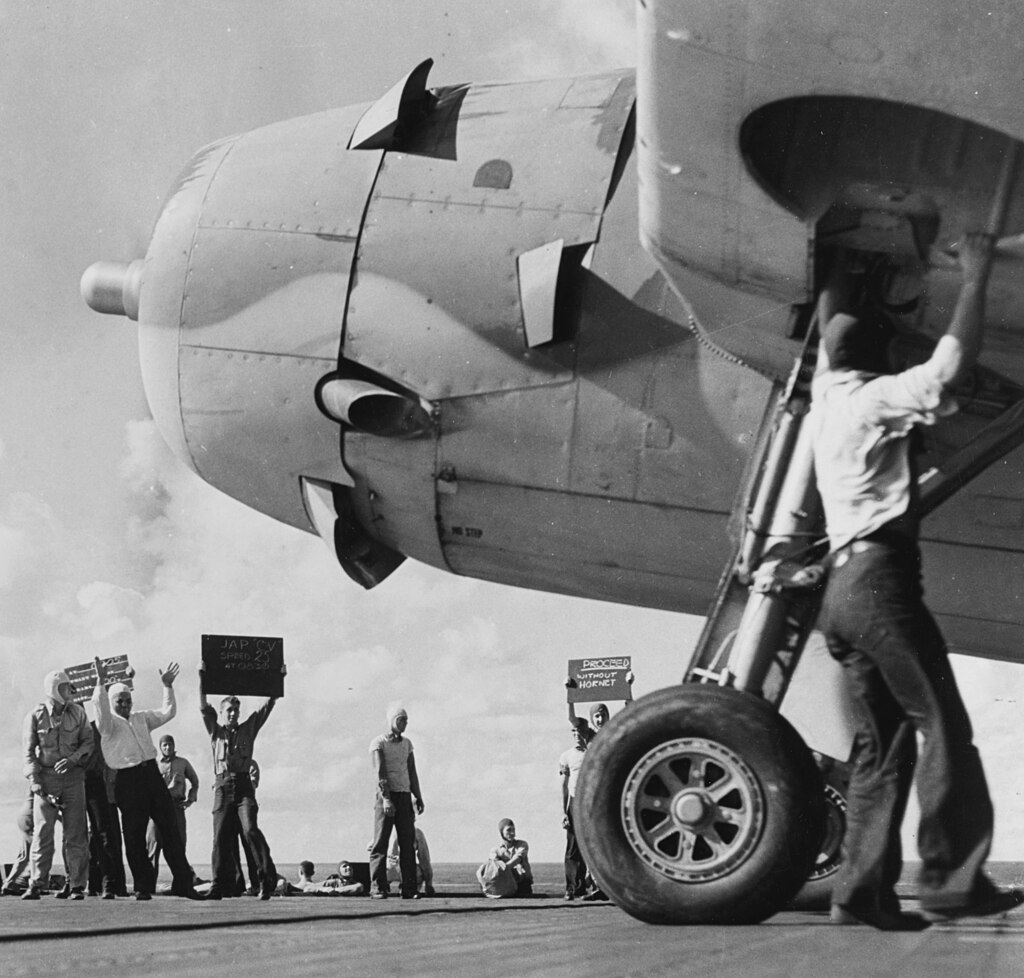 Photo: The U.S. Navy Task Force 17 maneuvering to avoid a Japanese air attack during the Battle of the Santa Cruz Islands on 26 October 1942. The aircraft carrier USS Hornet (CV-8) is at left with the light cruisers USS Juneau (CL-52) and USS San Diego (CL-53) close together at right. Several planes are visible in the center Photo: The U.S. Navy Task Force 17 maneuvering to avoid a Japanese air attack during the Battle of the Santa Cruz Islands on 26 October 1942. The aircraft carrier USS Hornet (CV-8) is at left with the light cruisers USS Juneau (CL-52) and USS San Diego (CL-53) close together at right. Several planes are visible in the center Photo: Plane-handling crews working hard aboard Enterprise as the ship heels sharply during the Battle of the Santa Cruz Islands, October 26, 1942. The plane in the center is an F4F Wildcat fighter. To its right is an SBD Dauntless. Other planes are overhead Photo: Plane-handling crews working hard aboard Enterprise as the ship heels sharply during the Battle of the Santa Cruz Islands, October 26, 1942. The plane in the center is an F4F Wildcat fighter. To its right is an SBD Dauntless. Other planes are overhead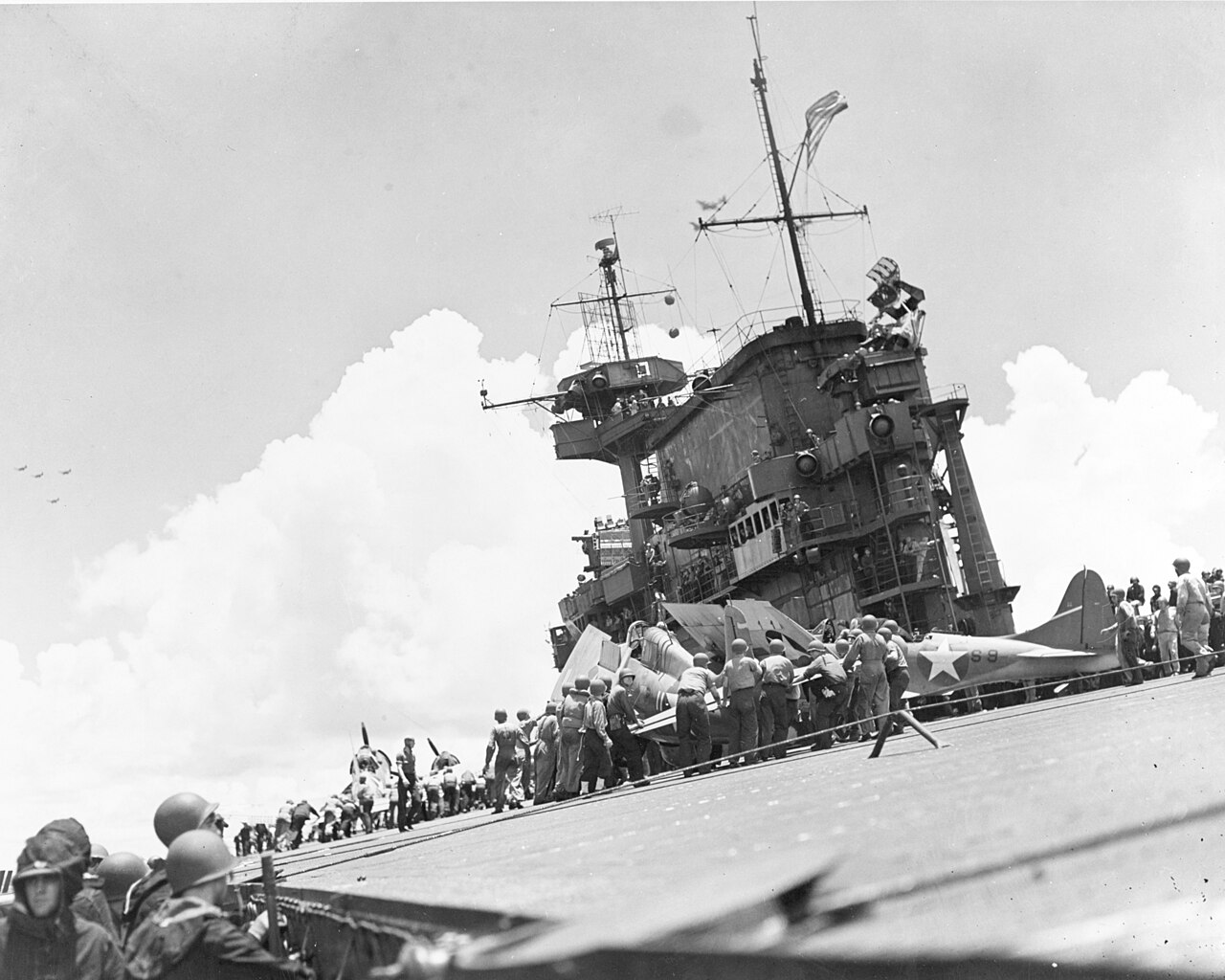 Americans control the skies above the sea routes to Guadalcanal. The victory, however, does not come cheaply in this, the fourth major carrier battle of 1942, for the USN aircraft carrier USS Enterprise is damaged by planes from Japanese aircraft carriers Junyo and Shokaku; aircraft carrier USS Hornet is damaged by planes from Junyo, Shokaku, and Zuikaku; battleship USS South Dakota and light cruiser USS San Juan are damaged by planes from Junyo; destroyer USS Smith is damaged by a crashing carrier attack plane; during the operation of fighting the fires on USS Hornet and taking off her survivors, destroyer USS Hughes is damaged in a collision with the doomed carrier (as well as by friendly fire earlier in the action). Photo: A Japanese Type 99 Aichi D3A1 dive bomber (Allied codename "Val") trails smoke as it dives toward the U.S. Navy aircraft carrier USS Hornet (CV-8), during the morning of 26 October 1942. This plane struck the ship's stack and then her flight deck. A Type 97 Nakajima B5N2 torpedo plane ("Kate") is flying over Hornet after dropping its torpedo, and another "Val" is off her bow. Note anti-aircraft shell burst between Hornet and the camera, with its fragments striking the water nearby
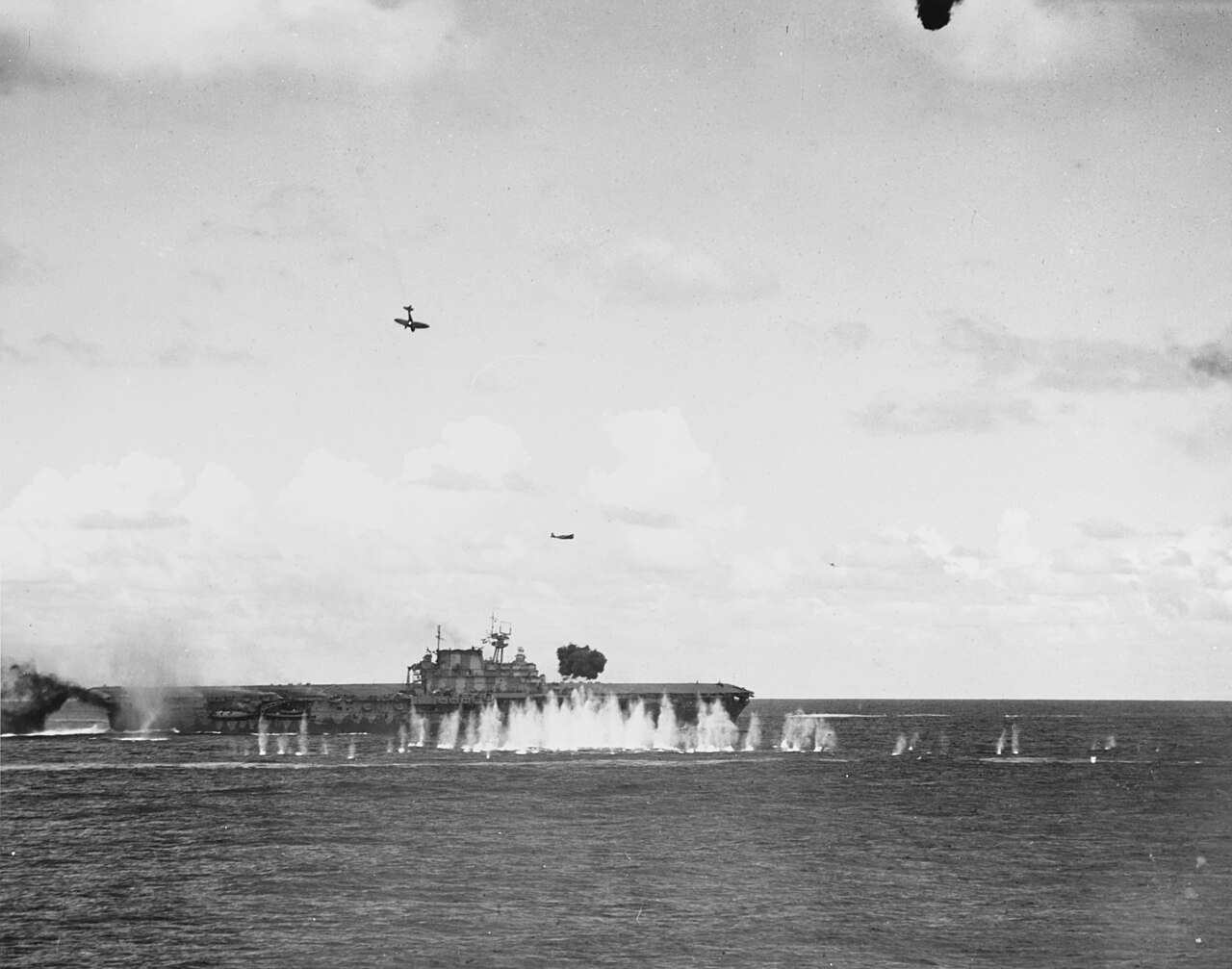 Photo: Damage to the smokestack and signal bridge of the U.S. Navy aircraft carrier USS Hornet (CV-8) after it was struck by a crashing Japanese Aichi D3A1 dive bomber, during the morning of 26 October 1942. The smoke at bottom is from fires started when the plane subsequently hit the flight deck. Note ship's tripod mast, with CXAM radar antenna in top left and the flag still flying above the damaged structure Photo: Damage to the smokestack and signal bridge of the U.S. Navy aircraft carrier USS Hornet (CV-8) after it was struck by a crashing Japanese Aichi D3A1 dive bomber, during the morning of 26 October 1942. The smoke at bottom is from fires started when the plane subsequently hit the flight deck. Note ship's tripod mast, with CXAM radar antenna in top left and the flag still flying above the damaged structure
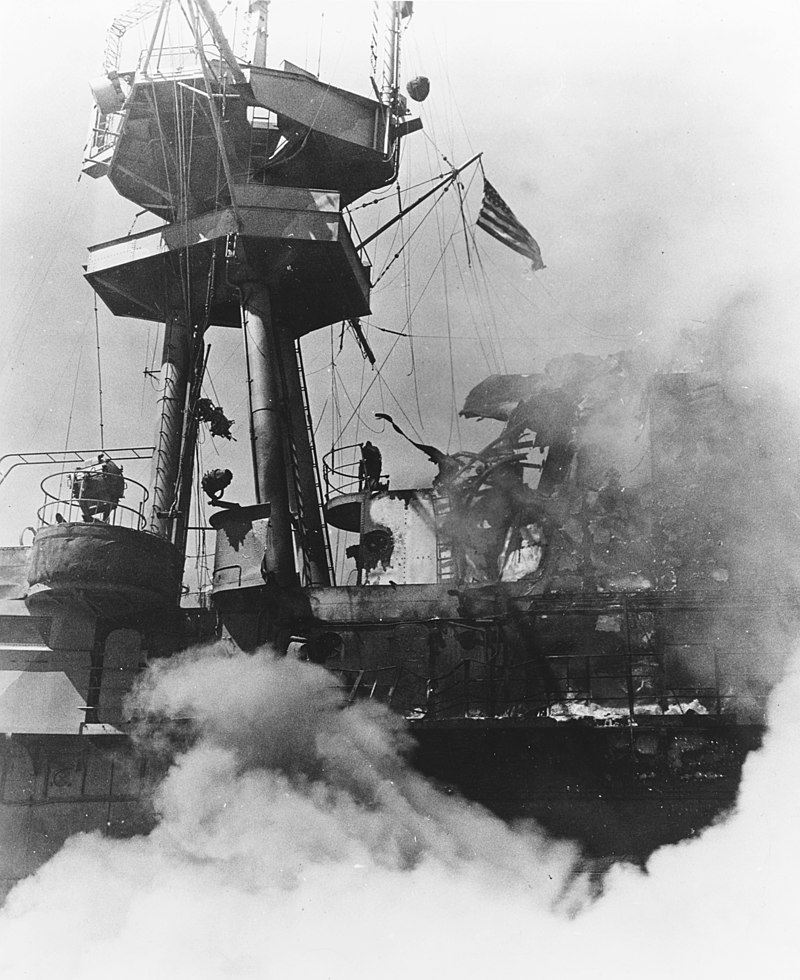 Photo: A Japanese bomb explodes off the port side of the U.S. Navy aircraft carrier USS Enterprise (CV-6) during the Battle of the Santa Cruz Islands, 26 October 1942 Photo: A Japanese bomb explodes off the port side of the U.S. Navy aircraft carrier USS Enterprise (CV-6) during the Battle of the Santa Cruz Islands, 26 October 1942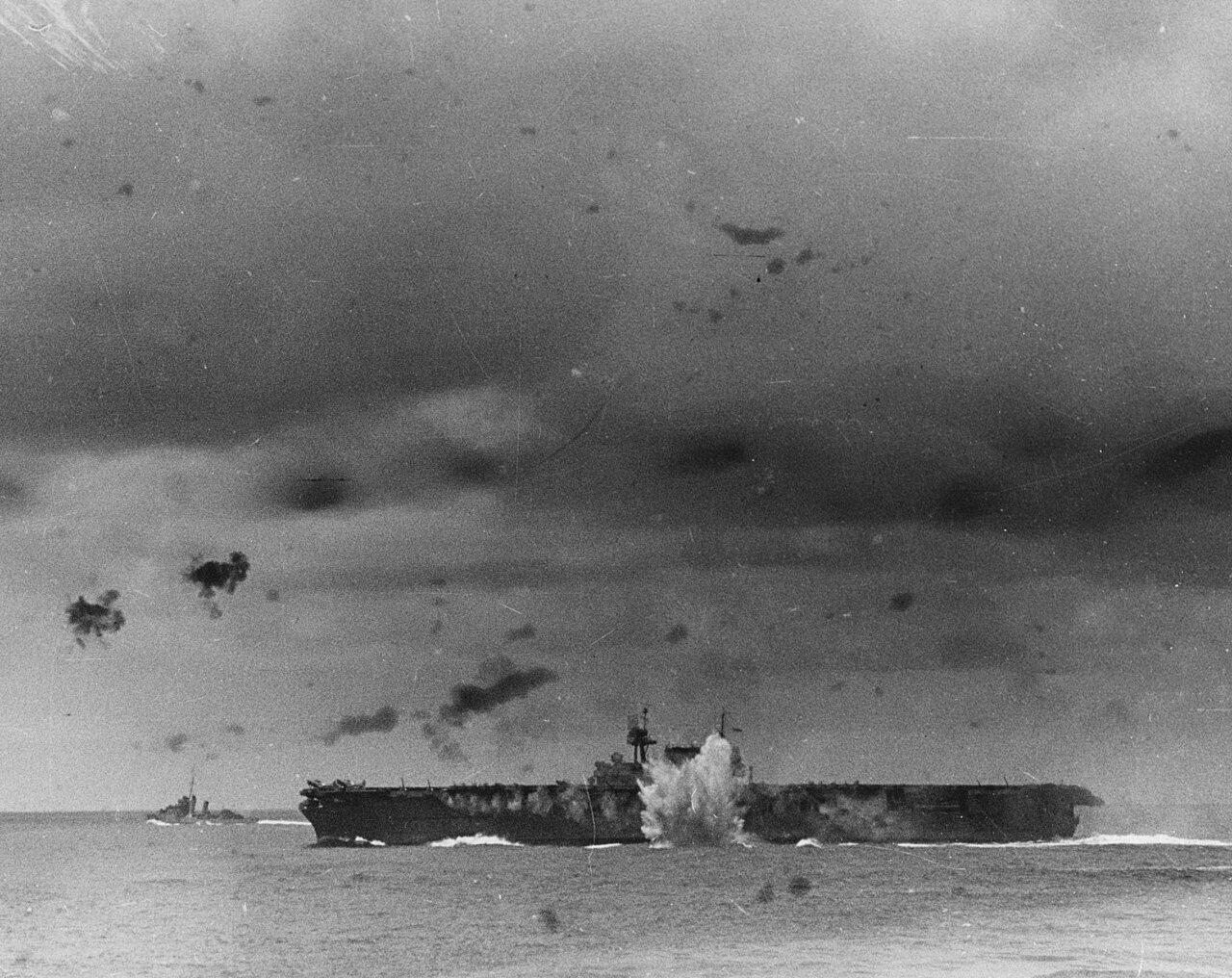 Photo: The U.S. Navy battleship USS South Dakota (BB-57) firing her anti-aircraft guns at attacking Japanese planes during the Battle of Santa Cruz, 26 October 1942. A Japanese Type 97 Nakajima B5N2 torpedo plane ("Kate") is visible at right, apparently leaving the area after having dropped its torpedo Photo: The U.S. Navy battleship USS South Dakota (BB-57) firing her anti-aircraft guns at attacking Japanese planes during the Battle of Santa Cruz, 26 October 1942. A Japanese Type 97 Nakajima B5N2 torpedo plane ("Kate") is visible at right, apparently leaving the area after having dropped its torpedo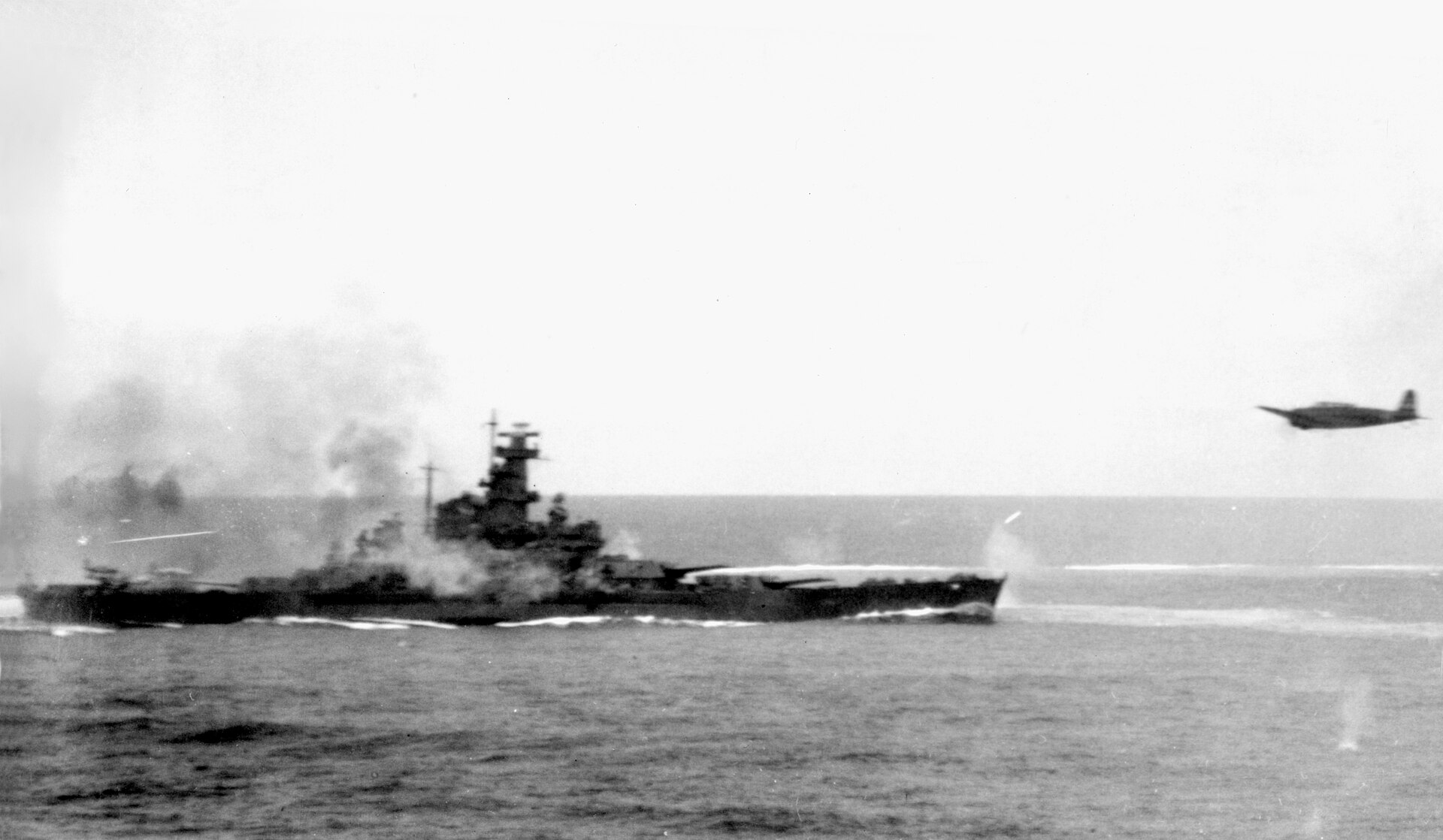 Photo: The U.S. Navy destroyer USS Smith (DD-378) is hit by a crashing Japanese torpedo plane, during an attack on USS Enterprise (CV-6), Battle of the Santa Cruz Islands, 26 October 1942 Photo: The U.S. Navy destroyer USS Smith (DD-378) is hit by a crashing Japanese torpedo plane, during an attack on USS Enterprise (CV-6), Battle of the Santa Cruz Islands, 26 October 1942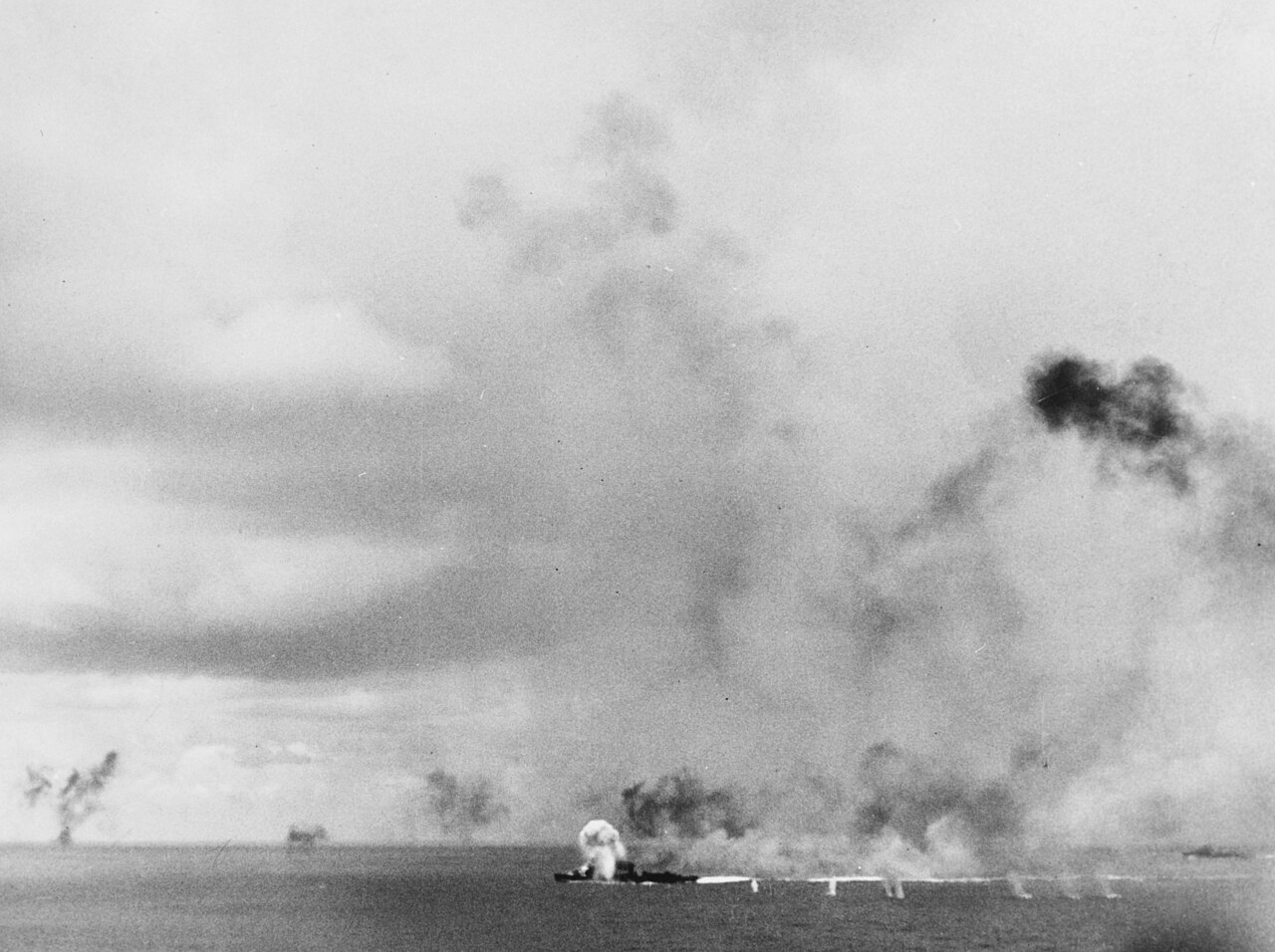 The attempt to scuttle the irreparably damaged USS Hornet, by gunfire and torpedoes from destroyers USS Mustin and Anderson fails; destroyer Porter is accidentally torpedoed by a battle damaged and a ditched TBF of Torpedo Squadron VT 10, and, deemed beyond salvage, is scuttled by destroyer USS Shaw. SBDs of Scouting Squadron VS 10 in USS Enterprise damage aircraft carrier Zuiho; SBDs of Bombing Squadron VB8 and VS8 in USS Hornet damage carrier Shokaku and destroyer Terutsuki; TBF Avengers of VT6 in USS Hornet damage heavy cruiser Chikuma. Photo: Chikuma (Japanese Heavy Cruiser) under air attack during the Battle of the Santa Cruz Islands, 26 October 1942. Photographed from a USS Enterprise plane. Note the smoke coming from her bridge area, which had been hit by a bomb, and what appears to be a recognition marking painted atop her number two eight-inch gun turret. The ship's catapults and aircraft crane appear to be swung out over her sides, aft of amidships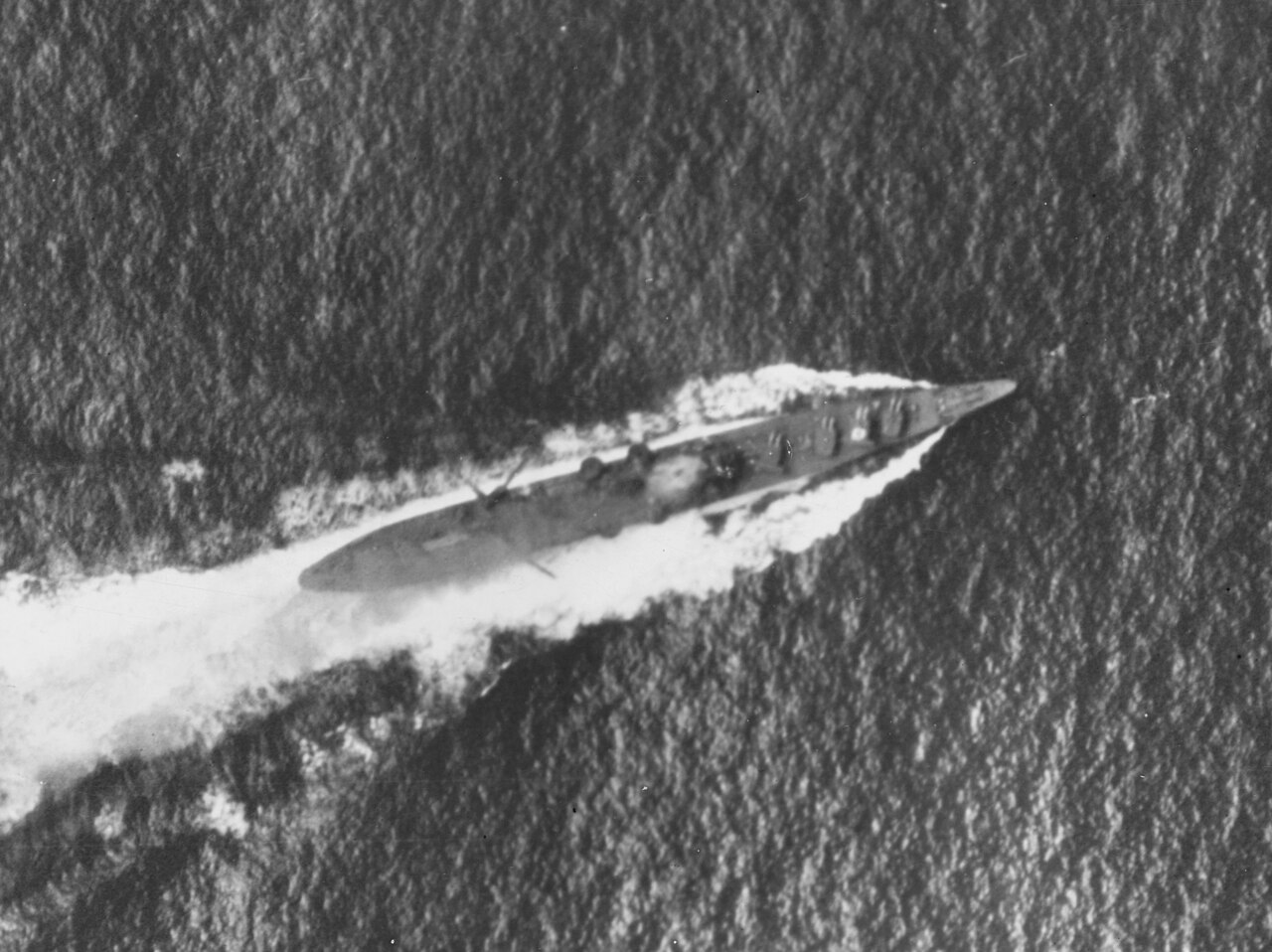 Photo: The U.S. Navy aircraft carrier USS Hornet (CV-8) dead in the water as the heavy cruiser USS Northampton (CA-26) attempts to take her in tow during the Battle of the Santa Cruz Islands on 26 October 1942. The cruisers USS Pensacola (CA-24), USS San Diego (CL-53), and USS Juneau (CL-52) maneuver around the carrier. Note that the after guns of the nearest light cruiser, USS Juneau (CL-52), are trained on the camera plane Photo: The U.S. Navy aircraft carrier USS Hornet (CV-8) dead in the water as the heavy cruiser USS Northampton (CA-26) attempts to take her in tow during the Battle of the Santa Cruz Islands on 26 October 1942. The cruisers USS Pensacola (CA-24), USS San Diego (CL-53), and USS Juneau (CL-52) maneuver around the carrier. Note that the after guns of the nearest light cruiser, USS Juneau (CL-52), are trained on the camera plane Photo: The U.S. heavy cruiser USS Northampton (CA-26) maneuvers to try to take the crippled aircraft carrier USS Hornet (CV-8) under tow during the Battle of the Santa Cruz Islands on 26 October 1942. A destroyer is standing by Photo: The U.S. heavy cruiser USS Northampton (CA-26) maneuvers to try to take the crippled aircraft carrier USS Hornet (CV-8) under tow during the Battle of the Santa Cruz Islands on 26 October 1942. A destroyer is standing by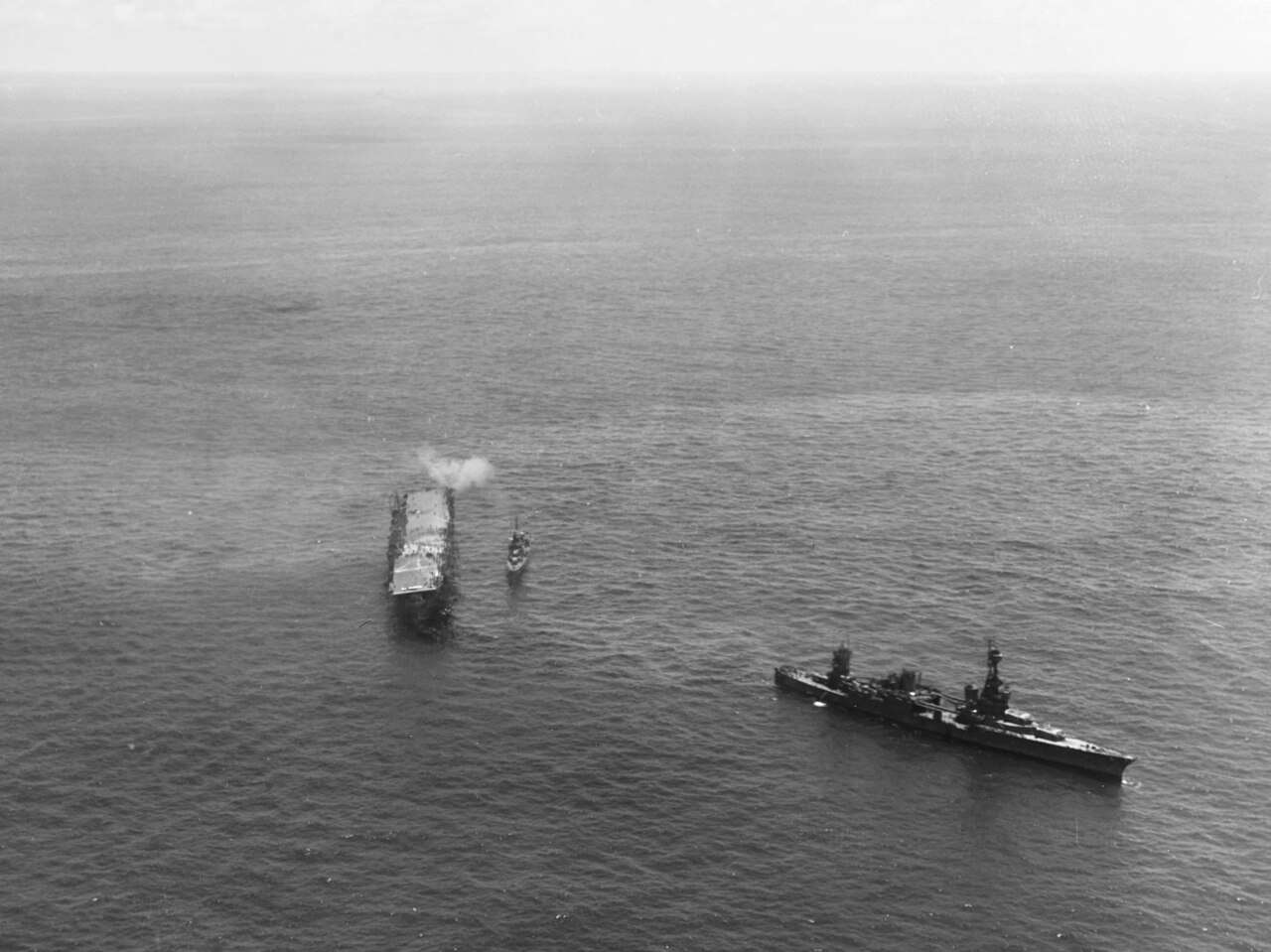 Photo: The damaged U.S. Navy aircraft carrier USS Hornet (CV-8) during the Battle of Santa Cruz Islands with the destroyer USS Russell (DD-414) alongside ready to take off her crew Photo: The damaged U.S. Navy aircraft carrier USS Hornet (CV-8) during the Battle of Santa Cruz Islands with the destroyer USS Russell (DD-414) alongside ready to take off her crew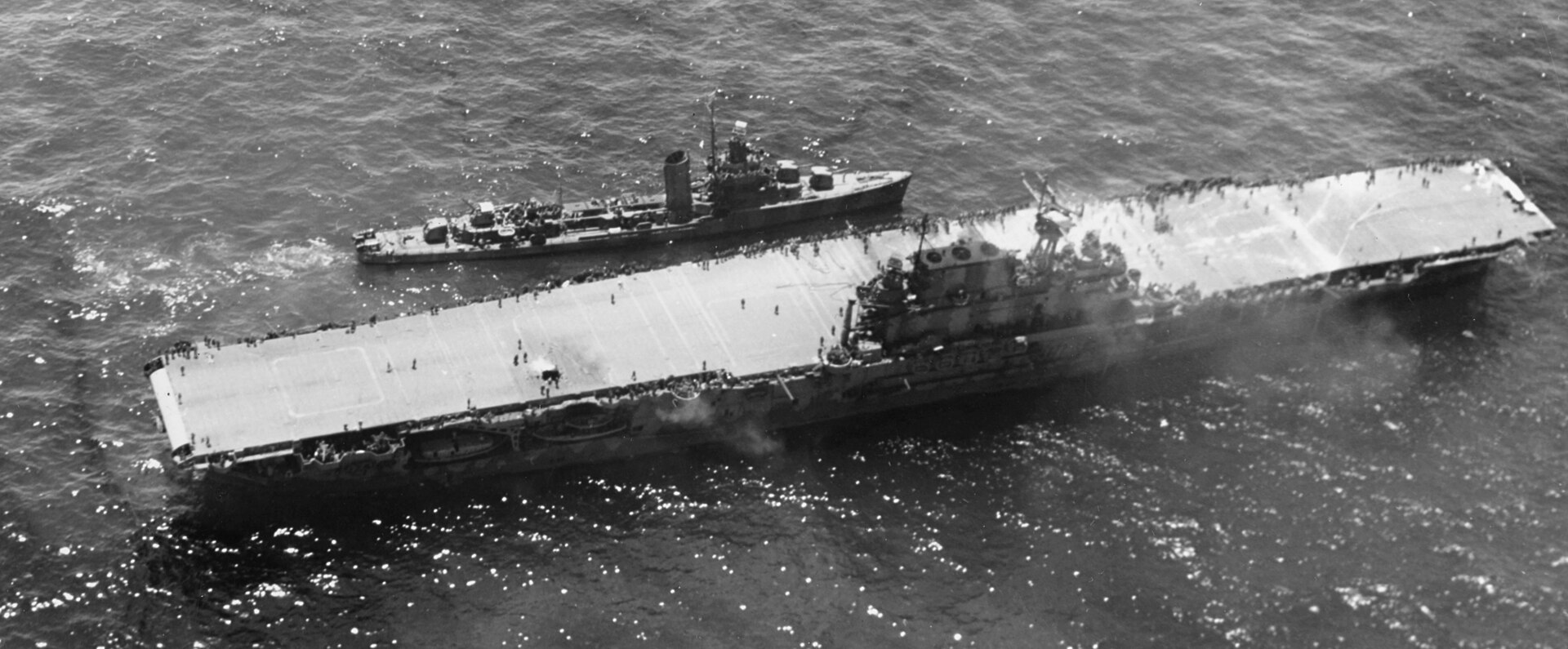 Photo: Battle of the Santa Cruz Islands, October 1942: Crew members of the U.S. Navy aircraft carrier USS Hornet (CV-8) prepare to abandon ship on 26 October 1942, after she was disabled by Japanese air attacks. Photographed from the destroyer USS Russell (DD-414). Note radar antennas on the carrier's masts and gun directors, and other details of the ship's island and port side. Radar antennas include FD mounted atop the two Mark 37 gun directors at the island ends, a CXAM atop the foremast and a SC radar partially visible atop the after mast Photo: Battle of the Santa Cruz Islands, October 1942: Crew members of the U.S. Navy aircraft carrier USS Hornet (CV-8) prepare to abandon ship on 26 October 1942, after she was disabled by Japanese air attacks. Photographed from the destroyer USS Russell (DD-414). Note radar antennas on the carrier's masts and gun directors, and other details of the ship's island and port side. Radar antennas include FD mounted atop the two Mark 37 gun directors at the island ends, a CXAM atop the foremast and a SC radar partially visible atop the after mast YouTube (The Battle of Santa Cruz: How the US Navy Beat the Odds | Battle 360 | History) YouTube (The Battle of Santa Cruz: How the US Navy Beat the Odds | Battle 360 | History)JAPAN At 0900 hours, USN submarine USS S-31 sinks an armed transport off the east coast off Paramushiru Island, Kurile Islands. SOLOMON CAMPAIGN Shortly after midnight, the main attack against the Lunga Perimeter begins again on Guadalcanal. The front manned by the 3rd Battalion, 164th Infantry Regiment is under heavy attack by the Japanese 16th Infantry Regiment. 37mm canister fire from two guns of Weapons Company 7th Marine Regiment stops the attack cold. Some survivors succeed in infiltrating the defense lines and are hunted down. This attack, like last night, is short the right wing which is still lost in the jungle. It has turned to the east (right) due to reports of US forces and is not in position. The reports are false. Near the coast, just east of the mouth of the Matinakau River, Colonel Oka finally reaches a position to attack. This attack falls on the 2nd Battalion, 7th Marine Regiment. The Japanese are heard approaching late last night. At 0300 hours the attack begins. The mortar fire of the battalion and machine gun fire from Sergeant Mitchell Paige (MOH) of the 2-7 hold off the Japanese regimental sized attack until 0500 hours. The Japanese 3rd Battalion, 4th Infantry Regiment, finally scales the steep slope and replaces Company F from the crest of the ridge. Seventeen men under Major Conoley attack at 0540 hours. They eject the Japanese from the hill. This unit is drawn from communication specialists, cooks, bandsmen, and several riflemen. They receive assistance from Sergeant Paige, Company G, 7th Marine Regiment and Company C, 5th Marine Regiment. At 0800 hours, Lieutenant General Hyakutake Seikichi, Commanding General of the 17th Army, stops the attack. During the last five day, U.S. casualties are 86 killed in action and 192 wounded in action; the Japanese lose 1,553 troops south of Henderson Field and 800 near the Matinakau River. The number of U.S. operational aircraft on Guadalcanal is now 29.
|
|
lordroel
Administrator
Posts: 68,117 
Likes: 49,506
|
Post by lordroel on Oct 27, 2021 2:46:25 GMT
Day 1143 of World War II, October 27th 1942Battle of the Atlantic The 11,330 ton passenger/cargo liner MS 'Abasso' is sunk while on its way from Cape Town, South Africa, to Liverpool, England, by the German submarine U-575 about 589 nautical miles (1 091 kilometers) north of Lagens Field, Azores Islands. There are only 31 survivors; a total of 168 crew and 83 passengers are lost. Among the passengers are 44 newly trained pilots from a training school in Southern Rhodesia; only one, a Canadian, survives. Survivors are picked up from the freezing Atlantic on 1 November by the sloop HMS 'Bideford'. Late in the evening, the 5,620 ton U.S. freighter SS 'West Kehar' is torpedoed and sunk by German submarine U-129 about 367 nautical miles (680 kilometers) east-northeast of Bridgetown, Barbados, while en route from Freetown, Sierra Leone, to St. Thomas, Virgin Islands. Three merchant seamen are killed; the survivors take to two lifeboats and one raft. Air War over Europe During the day, two RAF Bomber Command aircraft bomb the city and airfield on Wangerooge Island. During the day, one each RAF Bomber Command Mosquitos attack the Den Helder port area and Langeoog Airfield. Battle of the MediterraneanUS Army, Middle East Air Force B-17 Flying Fortresses and B-24 Liberators strike Maleme Airfield, Crete. North African campaign
The Australians withstand a determined Axis attacks against their wedge in the northern sector of XXX Corps and the British Eighth Army front. In view of the strong German reinforcements on his northern flank near the coast, General Bernard L Montgomery, General Officer Commanding Eighth Army, alters the breakout plan; instead of pushing west along coast, he decides to shift the point of advance south in order to attack against Italian troops. US Army, Middle East Air Force B-25 Mitchells bomb landing grounds, motor transports, and tanks; P-40s fly escort, then bomb and strafe road east of El Daba, and attack troop concentration and vehicles. Map: Second Battle of El Alamein: 21st Panzer Division, 15th Panzer Division and Littorio Armoured Division attack 51st Highland Division, but fail to retake Kidney Ridge: 8am October 27th, 1942. 7th Bersaglieri Regiment tries unsuccessfully to dislodge Australian 9th Division from Hill 28: 10am October 27th, 1942. 44th Infantry Division probes Folgore Parachutist Divisions defences: October 27th, 1942. 7th Armoured Division moves north: October 27th, 1942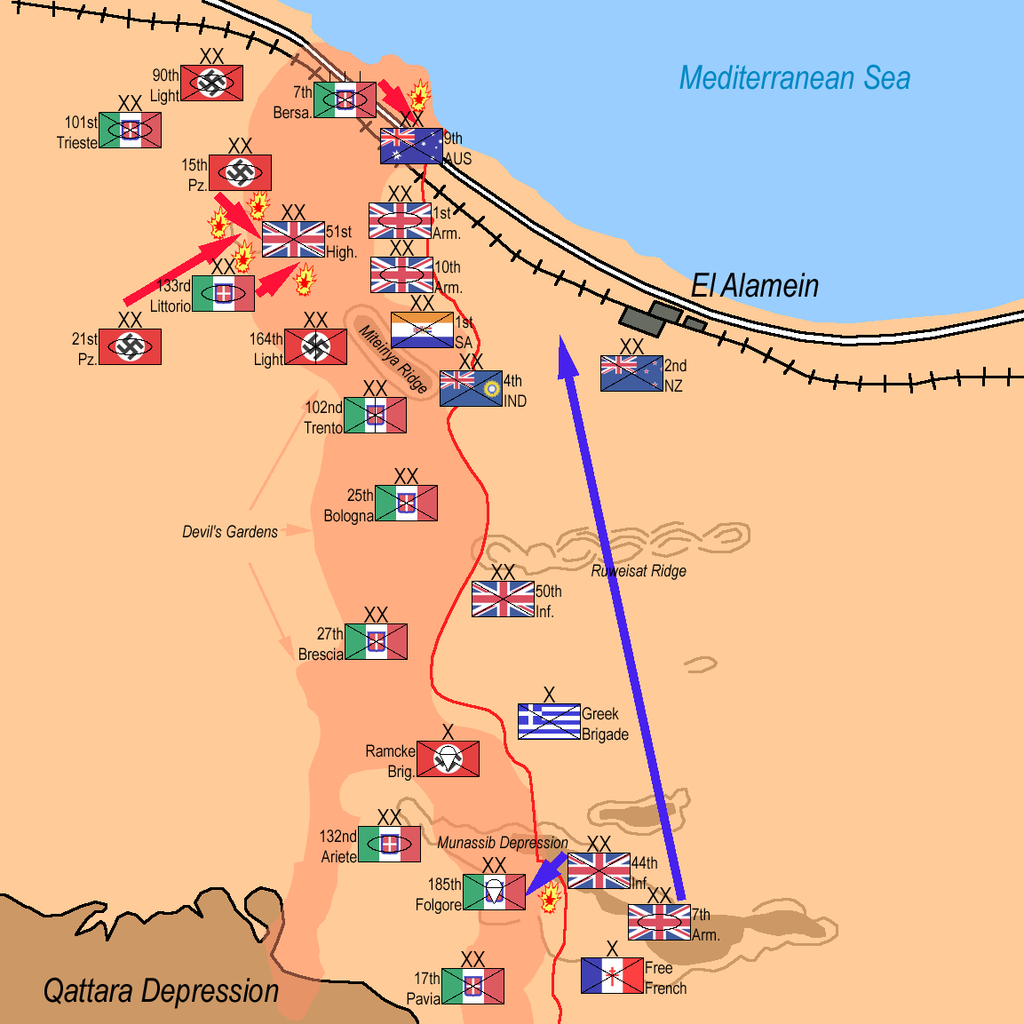 Photo: Four men of the 51st (Highland) Division dug in near El Alamein, 27 October 1942 Photo: Four men of the 51st (Highland) Division dug in near El Alamein, 27 October 1942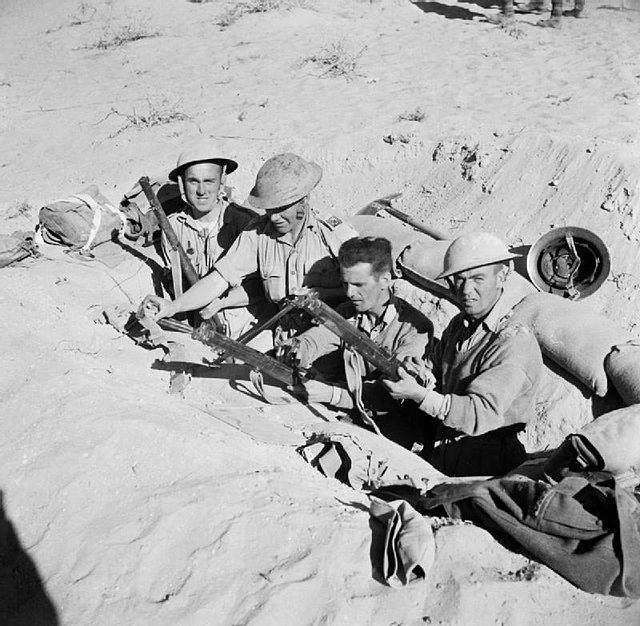 Photo: A 6-pdr anti-tank gun semi-armoured portee, camouflaged to look like an ordinary lorry, 27 October 1942. (AEC Mk I Deacon) Photo: A 6-pdr anti-tank gun semi-armoured portee, camouflaged to look like an ordinary lorry, 27 October 1942. (AEC Mk I Deacon)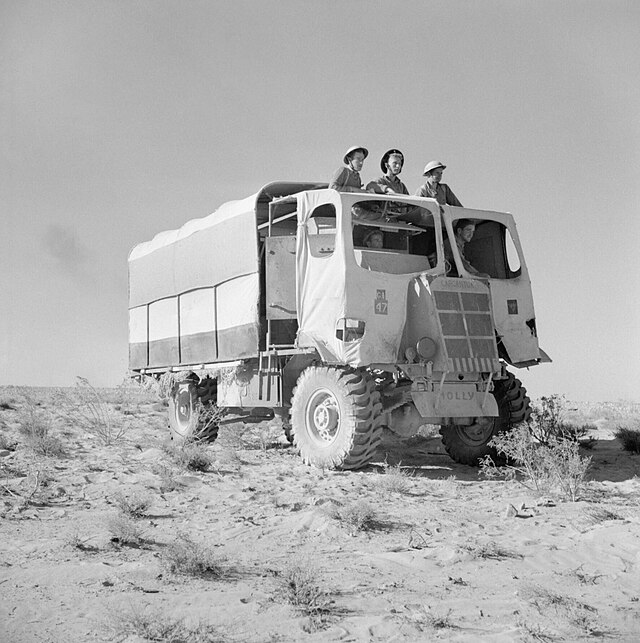 Photo: Sherman tanks of 8th Armoured Brigade waiting just behind the forward positions near El Alamein before being called to join the battle, 27 October 1942 Photo: Sherman tanks of 8th Armoured Brigade waiting just behind the forward positions near El Alamein before being called to join the battle, 27 October 1942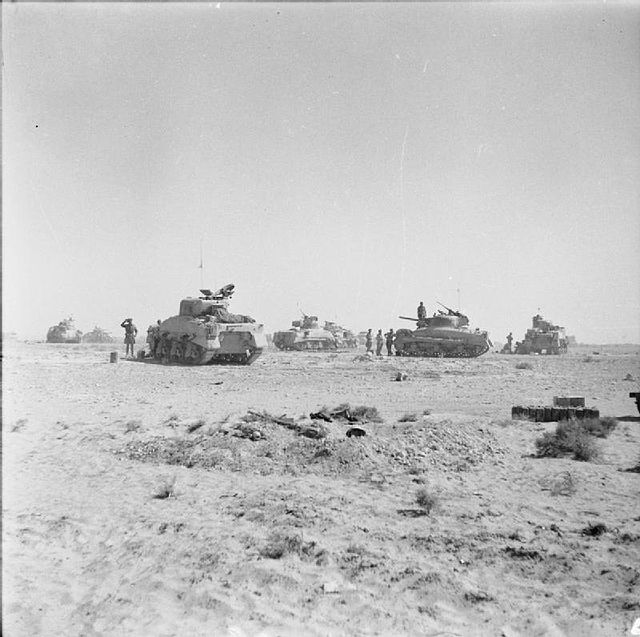 United States United States President Franklin D. Roosevelt offers to send an American division from the Territory of Hawaii to the Southwest Pacific Area. Roosevelt claims that the "common cause" would best be served by the retention of the Australian 9th Division in the Mid East. A 1943 production objective of 107,000 aircraft is given top priority by President Roosevelt in his instructions to Donald M Nelson, Chairman of the War Production Board. Photo: The U.S. Navy escort carrier USS Bogue (ACV-9) underway in Puget Sound, Washington (USA), on 27 October 1942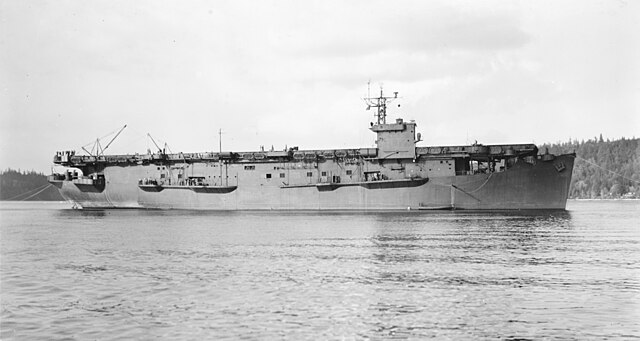 Photo: USS Balao (SS-285) launching, at the Portsmouth Navy Yard, Kittery, Maine, 27 October 1942 Photo: USS Balao (SS-285) launching, at the Portsmouth Navy Yard, Kittery, Maine, 27 October 1942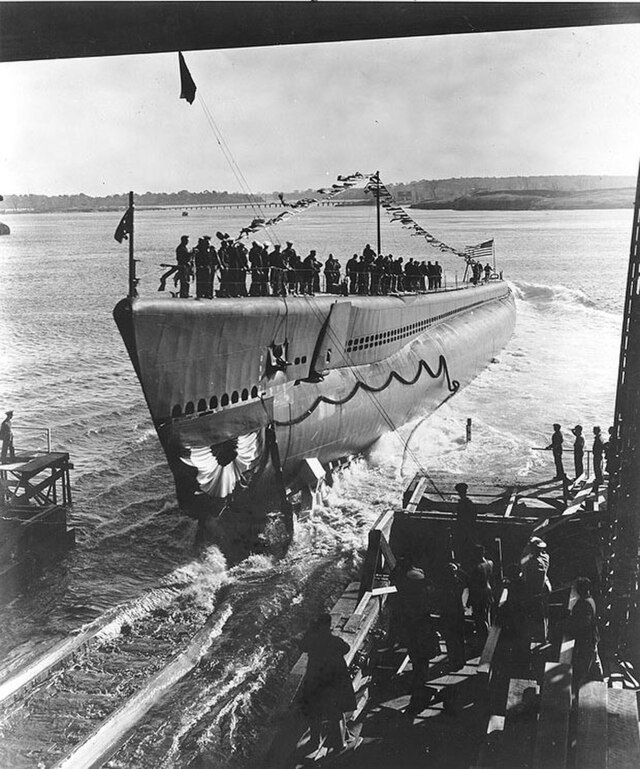 Pacific War Pacific WarALEUTIAN ISLANDS CAMPAIGN Six USAAF Eleventh Air Force B-24's flying an attack on the Japanese-held Kiska Island submarine base turn back due to weather; a weather aircraft flies reconnaissance over Gareloi, Segula, Kiska, and Attu Islands. D'ENTRECASTEAUX ISLANDS USAAF Fifth Air Force P-39's escort Australian Hudsons in a strike against small craft at Ferguson Island. INDIA British General Archibald Wavell, Commander in Chief India, and U.S. Lieutenant General Joseph Stilwell, Commander in Chief US China-Burma- India Theater of Operations, Chief of Staff to Chinese Generalissimo Chiang Kai-Shek and Commander in Chief Northern Area Combat Command (NCAC), agree that Stilwell shall conduct an offensive in the Hukawng Valley of northern Burma and occupy the area Myitkyina-Bhamo and make contact with Chinese forces from Yunnan. The Americans are to be responsible for construction of the Ledo Road to Myitkyina; the road is eventually to link with Burma Road. NEW GUINEA Australian troops are held up on the Kokoda Track. Engineers work to repair the bridges over Eora Creek which are washed away by heavy rains overnight. USAAF Fifth Air Force A-20s hit trails in southeast Papua New Guinea, around Alola, Isurava, and Abuari. PACIFIC OCEAN The abandoned aircraft carrier USS Hornet, damaged by bombs and torpedoes and attempted scuttling yesterday, is sunk by Japanese destroyers Akigumo and Makigumo at 0135 hours, about 398 nautical miles east of Henderson Field, Guadalcanal Island, Solomon Islands, in position 08.38S, 166.43E. The USN now has only four aircraft carriers in commission. Photo: The crew of the U.S. Navy aircraft carrier USS Enterprise (CV-6) conducts burial-at-sea on 27 October 1942, for 44 crewmen killed during the Battle of the Santa Cruz Islands the day before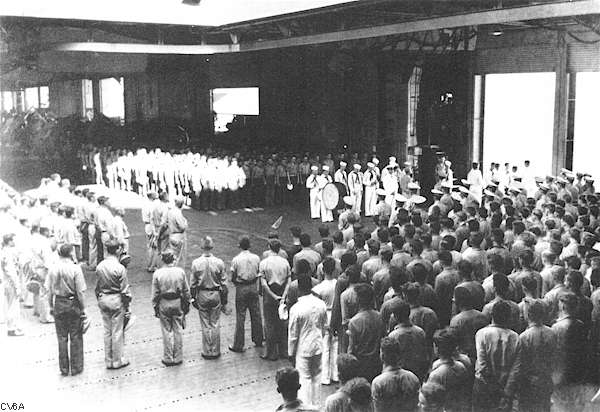 At 2200 hours in the South China Sea, the USN submarine USS Tautog sinks a Japanese transport/cargo ship about 124 nautical miles ESE of Saigon, French Indochina, in position 10.20N, 108.43E.
|
|
lordroel
Administrator
Posts: 68,117 
Likes: 49,506
|
Post by lordroel on Oct 28, 2021 2:46:54 GMT
Day 1144 of World War II, October 28th 1942Air War over Europe During the night of 28/29 October, three RAF Bomber Command Wellingtons lay mines off St. Nazaire; one aircraft is lost. During the night of 28/29 October, two RAF Bomber Command Wellingtons lay mines off Stavanger without loss. North African campaignAfter probing British positions in the Kidney Ridge area, Axis forces begin forming for an attack but are forced by Allied aircraft to abandon it. During the night of 28/29 October, the Australian 9th Division of XXX Corps, British Eighth Army, begins a northward attack toward the sea in an effort to eliminate German's coastal salient and secure the coastal road and railroad. A narrow wedge is driven almost to the road despite stubborn opposition from Thompson's Post, a key point in the German's coastal positions. US Army, Middle East Air Force B-25 Mitchells attack tanks, motor transports, and landing grounds; P-40's fly medium and light bomber escort, bomb and strafe landing grounds and other targets, and engage aircraft in combat, mostly in the area between El Alamein and El Daba, claiming three Bf 109s destroyed. Map: Second Battle of El Alamein: Trento Division under heavy attack by 1st South African Division and 4th Indian Division falls back. 21st Panzer Division and Littorio Armoured Division counterattack and stabilze Axis front: October 28th, 1942. 2nd New Zealand Division moves behind 9th Australian Division. October 28th, 1942. Australian 9th Division attempts to break through Axis lines west of Hill 28: 10am October 28th, 1942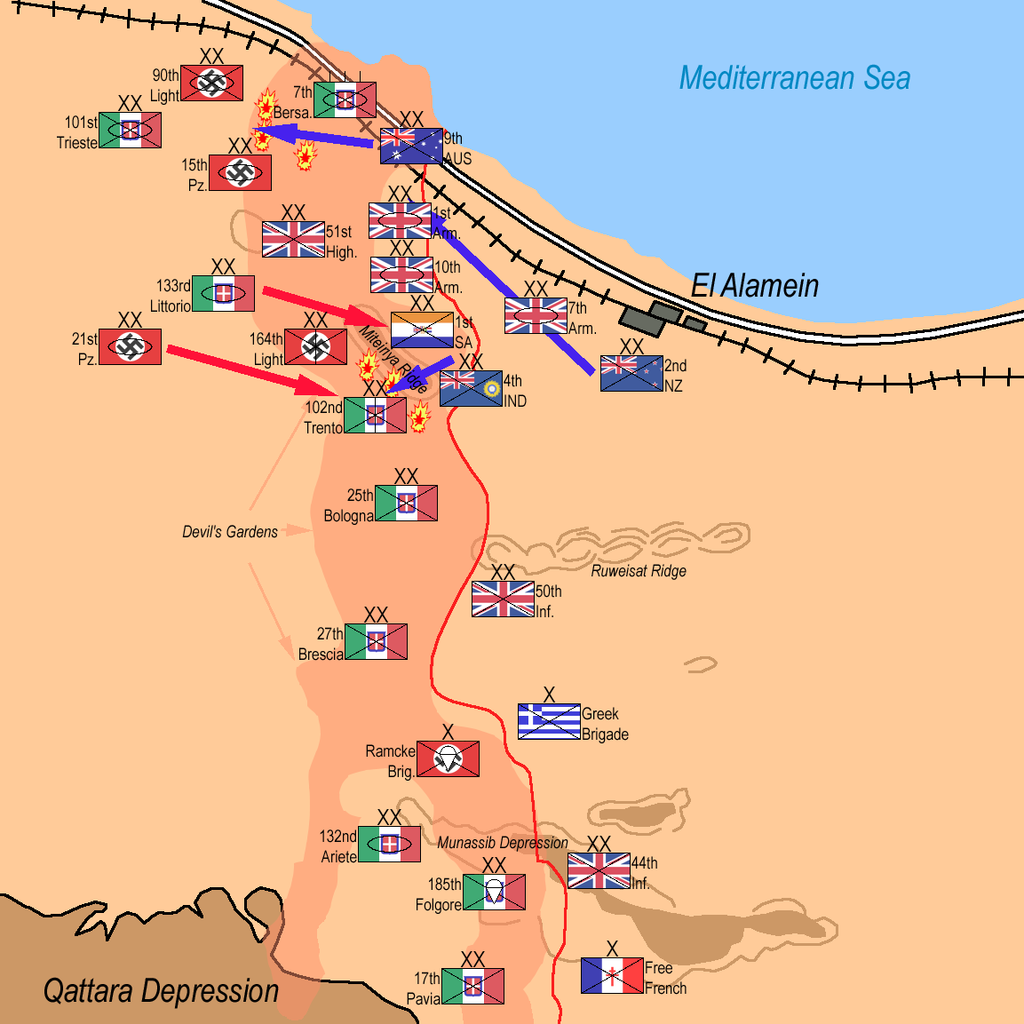 US Army, Middle East Air Force B-17's, dispatched to attack a convoy at sea, fail to locate the target but attack cruisers in Pylos Bay. Robert Murphy, US Consul in Northwest Africa, tells French Major General Charles Mast, Deputy Commander of the French XIX Corps stationed in Algiers, that the invasion will occur in November. Mast insists that he does not have enough time to organize the Allied sympathizers and to arrange for General Henri Giraud to be accepted as commander of French forces in Algeria, Morocco and Tunisia after the invasion of North Africa. United States After completing Officer Candidate School, former Hollywood actor Clark Gable is commissioned a second lieutenant in the U.S. Army Air Forces. Procurement of the expendable radio sonobuoy for use in antisubmarine warfare is initiated as the Commander-in- Chief, U.S. Fleet, Admiral Ernest J. King, directs the Bureau of Ships to procure 1,000 sonobuoys and 100 associated receivers. Canada At Kluane Lake, Yukon Territory, Canadian Health Minister, Ian Mackenzie, and the U.S. Secretary of Alaska, Edward L. Bartlett, cut a ribbon to open the Alcan Military Highway, today known as the Alaska Highway. The 1,600 mile road, from Dawson Creek, British Columbia, to Fairbanks Alaska, is built to move supplies and munitions rapidly north in case of Japanese invasion. Pacific WarALEUTIAN ISLANDS CAMPAIGN Six USAAF Eleventh Air Force B-24's turn back from an attempted attack on the Japanese-held Kiska Island submarine base because of adverse weather; a B-17's bombs Attu Island with unobserved results and flies weather reconnaissance over Kiska, Amchitka, and Tanaga Islands. BISMARCK ARCHIPELAGO On New Britain Island, B-17's bomb shipping in the harbor at Rabaul while B-25's hit the airfield at Gasmata. SOUTH PACIFIC AREA (Joint Chiefs of Staff): The 68th Fighter Squadron, 347th FG, begins moving from Tongatabu to New Caledonia. NEW GUINEA In Papua New Guinea, the 2d Battalion, 126th Infantry Regiment, U.S. 32d Infantry Division, and a portable hospital begin the difficult march from Jaure toward Natunga and Bofu, preceded by two companies, which are to secure dropping grounds. PACIFIC OCEAN Photo: The U.S. Navy destroyer USS Smith (DD-378) refueling from the battleship USS South Dakota (BB-57) on 28 October 1942. Her two forward 5"/38 guns and much of her forward superstructure are burned out and otherwise damaged, the result of a Japanese Nakajima B5N torpedo plane that crashed into her two days earlier, during the Battle of the Santa Cruz Islands Photo: The U.S. Navy destroyer USS Shaw (DD-373) transferring survivors of USS Porter (DD-356) between Shaw and the battleship USS South Dakota (BB-57) on 28 October 1942. Porter had been torpedoed and sunk two days earlier, during the Battle of the Santa Cruz Islands. Photographed from on board the South Dakota, one of whose 40 mm quad gun mounts, covered with canvas, is in the foreground Photo: The U.S. Navy destroyer USS Shaw (DD-373) transferring survivors of USS Porter (DD-356) between Shaw and the battleship USS South Dakota (BB-57) on 28 October 1942. Porter had been torpedoed and sunk two days earlier, during the Battle of the Santa Cruz Islands. Photographed from on board the South Dakota, one of whose 40 mm quad gun mounts, covered with canvas, is in the foreground
|
|
lordroel
Administrator
Posts: 68,117 
Likes: 49,506
|
Post by lordroel on Oct 29, 2021 6:24:43 GMT
Day 1145 of World War II, October 29th 1942Eastern Front German forces continue to gain ground between the Red October and Barrikady Factories in Stalingrad. Those parts of Stalingrad still held by Soviet forces are strongly held and fortified. The Soviet policy at Stalingrad has been to feed new divisions in slowly, gaining experience. In the Moscow area new divisions are committed as a unit. Faulty intelligence allows the Germans to assume the northern policy is followed in Stalingrad. They therefore overestimate losses and underestimate remaining strength. Air War over Europe During the day, two RAF Bomber Command Mosquitos bomb the U-boat yards at Flensburg. Two RAF Bomber Command bombers lay mines in the Frisian Islands. In the North Sea during the night of 27/28 October, five RAF Bomber Command lay mines in the Kattegat, the broad arm of the North Sea between Sweden and Denmark. Battle of the Atlantic German submarine U-627 is sunk about 296 nautical miles (549 kilometers) south of Reykjavik, Iceland, by depth charges from an RAF Fortress Mk. II, aircraft of No. 206 Squadron based at Benbecula, Outer Hebrides Islands, U.K.: all 44 crewmen are lost. German submarine U-117 lays some mines off Iceland, but no sinkings result from this field. North African campaignGeneralfeldmarschal Erwin Rommel, Commander of German-Italian Panzer Forces in Africa, mounts an intended major counterattack by the 21.Panzerdivision to push the attacking British forces back into the German minefields. They are held off by a small British force at Kidney Ridge and lose 50 Panzers. This leaves the axis forces with just 81 operational tanks. Map: Second Battle of El Alamein: Australian 9th Division gives up attempt to break through Axis lines west of Hill 28: October 29th, 1942. Axis Commander General Rommel reorganizes his troops: October 29th, 1942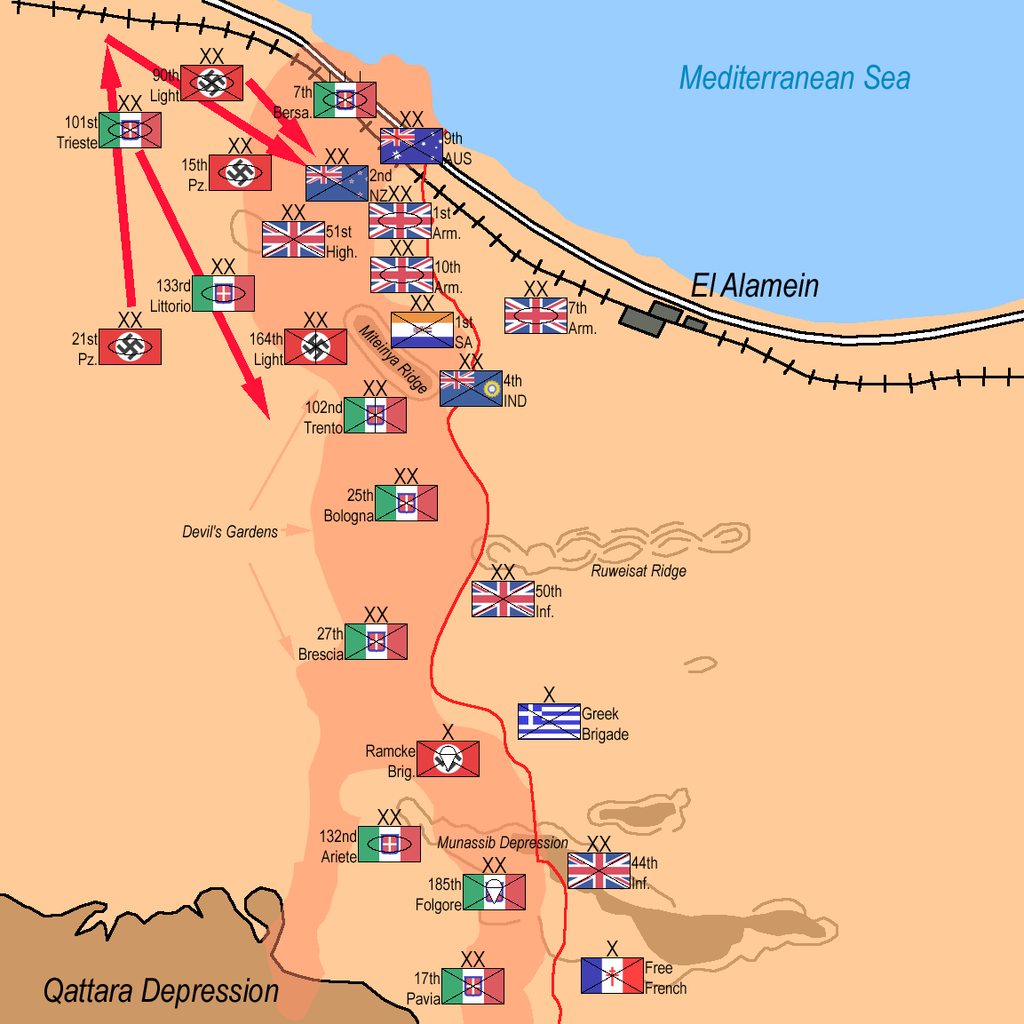 Photo: A 40mm Bofors anti-aircraft gun being dug in near a squadron of Crusader tanks, 29 October 1942 Photo: A 40mm Bofors anti-aircraft gun being dug in near a squadron of Crusader tanks, 29 October 1942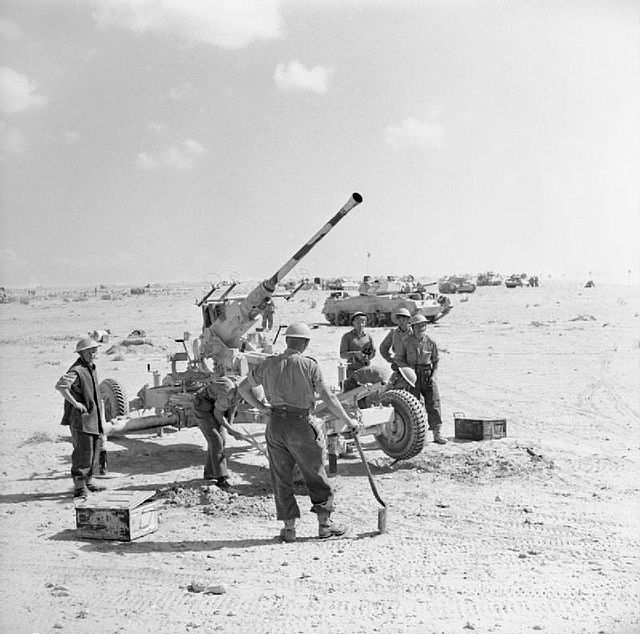 Photo: A 6-pdr anti-tank gun in action in the Western Desert, 29 October 1942 Photo: A 6-pdr anti-tank gun in action in the Western Desert, 29 October 1942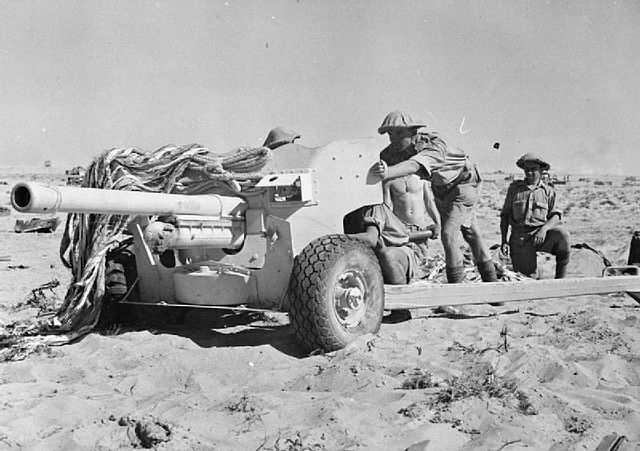 Photo: A Grant tank moving up to the front in the Western Desert, 29 October 1942 Photo: A Grant tank moving up to the front in the Western Desert, 29 October 1942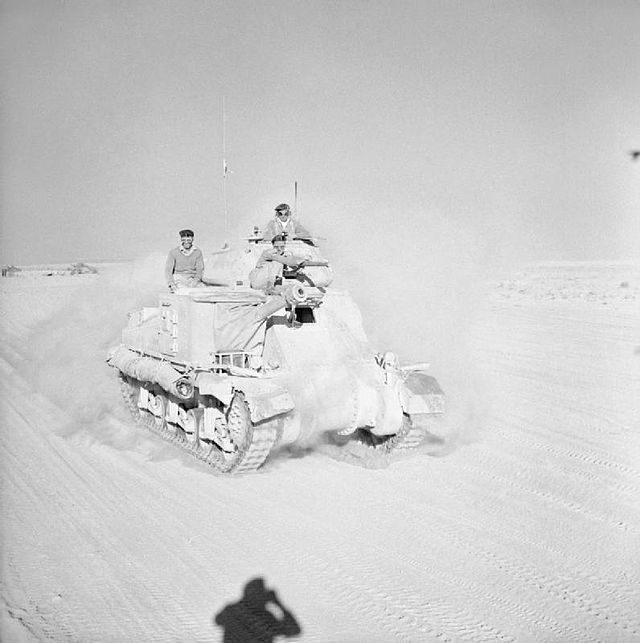 U.S. Army, Middle East Air Force B-25 Mitchells, with fighter escorts, bomb Matruh and attack motor transports, tanks, and other ground targets. Axis reinforcements brought up from the south, counterattack Kidney Ridge and are repulsed; the British Eighth Army continues regrouping for an assault. USAAF First Lieutenant Lyman Middleditch Jr., 64th Fighter Squadron, 57th Fighter Group, becomes the first USAAF fighter pilot in the U.K. or North Africa to score a triple victory when he downs three Bf 109s. Middleditch will end the war as an ace with five victories. United States The Army Air Forces School of Applied Tactics (AAFSAT) is established at Orlando, Florida, tasked with testing and demonstrating tactical unit organization, equipment and techniques; training of select USAAF, Army and Navy personnel in air tactics and doctrine; and training of air intelligence officers and air inspectors. United Kingdom Prime Minister Winston Churchill sends a message to Australian Prime Minister John Curtin commenting on the opening of the "great battle in Egypt" noting that; "...you will have observed with pride and pleasure the distinguished part which the 9th Australian Division are playing in what may be an event of the first magnitude."Canada First traffic rolls over the 1,600 mile Alcan Military Highway from Dawson Creek, British Columbia, to Fairbanks, Territory of Alaska. Pacific WarALEUTIAN ISLANDS CAMPAIGN A force of Japanese infantry, engineers, antiaircraft guns, and support units lands at Holtz Bay on Attu Island. Simultaneously, 1,100 troops from the 303rd Independent Infantry Battalion sail for Shemya Island. As they sail, USAAF Eleventh Air Force B-24 flies overhead. A USAAF Eleventh Air Force aircraft flies a special reconnaissance mission with Lieutenant General Simon B Buckner, Commanding General Alaska Defense Force, aboard. The flight covers Tanaga, Amchitka, and Japanese held Kiska Islands. NEW GUINEA CAMPAIGN Australian patrols find that the Japanese have abandoned their positions at Eora Creek from which they have held up the Australians for a week. The Australian troops pursue the Japanese along the Kokoda Track. In Papua New Guinea, USAAF Fifth Air Force A-20's hit the Isurava-Deniki and Abuari-Kaile trails. PACIFIC OCEAN In the South China Sea, USN submarine USS Grenadier lays mines in the Tonkin Gulf off Haiphong, French Indochina. In the Coral Sea, a USN PBY-5 Catalina of Patrol Squadron VP 11 sinks Japanese submarine I-172 about 268 nautical miles SE of Henderson Field, Guadalcanal, Solomon Islands, in position 13.01S, 162.45E. The sub is spotted on the surface and crash-dives and is underwater when two 650-pound depth charges are dropped. A large quantity of oil appeared and remained on the surface the following day. All 91 hands aboard, including Rear Admiral Okamoto Yoshisuke, Commander of the 12th Squadron of the Kure Submarine Flotilla. SOLOMON CAMPAIGN In the aftermath of recent action on Guadalcanal, the Japanese are consolidating their units west of the Lunga Perimeter. Part of this action occurs as various units struggle in over the next several days. Much of their equipment has been left behind as the Japanese again fight the jungle and hunt for food during their trek. The 1st Marine Division prepares for an offensive to drive the Japanese westward beyond the Poha River. The 2d Marine Regiment (less 3d Battalion) is ordered to Guadalcanal from Tulagi to assist in the offensive; the 3d Battalion, which has been operating as mobile reserve in the Lunga area, is to return to Tulagi for garrison duty. The attack is to begin on 1 November after outposts have been established west of the Matanikau River and bridges have been constructed across the river. USAAF Fifth Air Force B-17's attack shipping in the Bougainville Strait between Buin and Faisi Islands.
|
|
lordroel
Administrator
Posts: 68,117 
Likes: 49,506
|
Post by lordroel on Oct 30, 2021 13:28:57 GMT
Day 1146 of World War II, October 30th 1942YouTube (Nazi General Dies of Heart Attack)Eastern FrontPhoto: October 1942: A German soldier with a Soviet PPSh-41 submachine gun in Barrikady factory rubble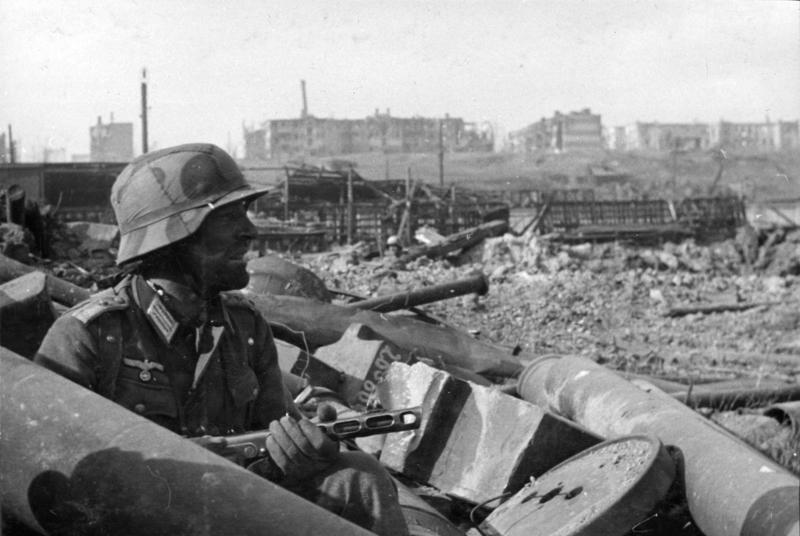 Air War over Europe Air War over Europe During the day, one RAF Bomber Command Mosquito bombs Lingen. During the day, three RAF Bomber Command Mosquitos bomb two targets with the loss of one aircraft: two bomb Leeuwarden Airfield, 2.2 miles (3,5 kilometers) south of the town, and one bombs the port area at Den Helder. During the night of 30/31 October, three RAF Bomber Command Wellingtons lay mines in the Frisian Islands without loss. Battle of the Atlantic German submarine U-604 torpedoes and sinks the 11,898 ton troopship, SS 'President Doumer', an ex-French passenger liner now a Ministry of War Transport, about 151 nautical miles (280 kilometers) north of Portugal's Madeira Islands; 260 people aboard are lost. The ship is sailing in Convoy SL-125 from Freetown, Sierra Leone, to the U.K. Two German submarines are sunk east of Newfoundland by Canadian aircraft: - U-520 is sunk about 116 nautical miles (214 kilometers) east of Saint John's by four 250-pound (113 kilogram) depth charges from a Douglas B-18 Digby, aircraft of No. 10 (Bomber Reconnaissance) Squadron based at Gander, Newfoundland. The aircraft is returning from a patrol of convoy ON 140 (U.K. to North America). All 53 crewmen are lost. - U-658 is sunk about 301 nautical miles (557 kilometers) northeast of Saint John's by depth charges from a Hudson Mk. III, aircraft "784" of No. 145 (Bomber Reconnaissance) Squadron based at Torbay, Newfoundland; all 48 crewmen are lost. Battle of the MediterraneanThirteen US Army, Middle East Air Force B-24 Liberators bomb Maleme Airfield and a B-24 bombs the main jetty in Suda Bay. German submarine U-559 is sunk about 83 nautical miles (153 kilometers) NNE of Port Said, Egypt, by depth charges from the British destroyers HMS 'Pakenham', 'Petard', 'Hero', the escort destroyers HMS 'Dulverton' and 'Hurworth', and an RAF Wellesley Mk. I of No. 47 Squadron based at Shandur, Egypt; 38 of the 45 crewmen survive. The U-boat is boarded by three RN men who have swum over to the sinking wreck. They went into the boat and captured several vital secret documents which greatly helped (some say, enabled) breaking the German coded messages. Two of the three man boarding party drowned inside the boat while still handling out files. The two men are Lieutenant Francis Anthony Blair Fasson (b.1913) and Able Seaman Colin Grazier (b.1920), both of HMS 'Petard', who are posthumously awarded the George Cross. North African campaignThe British Eighth Army renews the assault on the north flank of XXX Corps during the night of 30/31 October. The Australian 9th Division drives north to the sea, then pushes east, trapping a large Axis force. Allied planes provide excellent tactical support, attacking accurately in small area to neutralize Thompson's Post. Most of the pocketed Axis force subsequently succeeds in escaping when tanks from the west break through to assist. US Army, Middle East Air Force B-25 Mitchells attack landing grounds at Fuka-Bagush and El Daba while P-40s fly escort. United KingdomPhoto: Paratroops on parade outside a hangar at No 1 Parachute Training School, Ringway, Manchester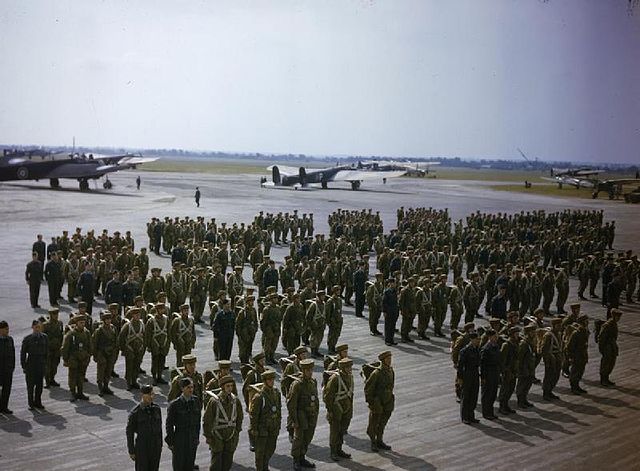 Pacific War Pacific WarALEUTIAN ISLANDS CAMPAIGN A USAAF Eleventh Air Force B-24 twice flies reconnaissance over Agattu and Japanese-held Kiska Islands; there are no bombing mission as all bombers are on alert for possible naval targets. NEW CALEDONIA A "Glen" seaplane is launched from Japanese submarine HIJMS I-9 and reconnoiters Noumea, New Caledonia Island. NEW GUINEA CAMPAIGN The Australian advance up the Kokoda Trail reaches Alola. This is 10 miles from Kokoda. One Brigade will proceed directly up the track, the other will advance more easterly to Oivi. SOLOMON CAMPAIGN USMC F4F Wildcats from Guadalcanal make a dawn attack on the Rekata Bay Seaplane Base on Santa Isabella Island. The Marine pilots shoot down three "Rufe" seaplane fighters (Nakajima A6M2-N, Navy Type 2 Fighter Seaplanes) and two "Pete" biplanes (Mitsubishi F1M2, NavyType 0 Observation Seaplane) at 0515 hours. - USAAF Fifth Air Force B-17s bomb the harbor and shipping at Buin on southern Bougainville Island. - USN Task Group 64.2 (Rear Admiral Norman Scott), comprising light cruiser USS Atlanta and four destroyers, bombards Japanese positions at Point Cruz, Guadalcanal. AUSTRALIA Photo: The U.S. Navy tanker USS Victoria (AO-46) underway in October 1942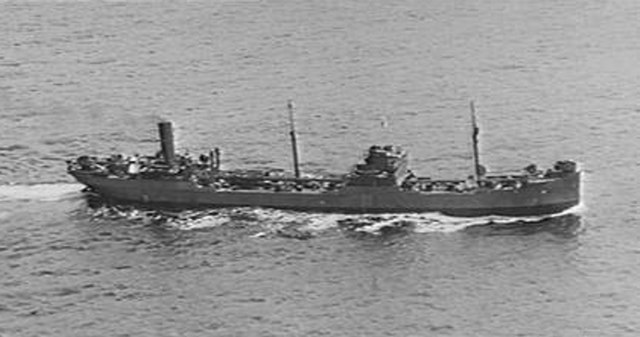
|
|
lordroel
Administrator
Posts: 68,117 
Likes: 49,506
|
Post by lordroel on Oct 31, 2021 8:29:42 GMT
Day 1147 of World War II, October 31st 1942Eastern Front After 35,000 persons have been executed in Riga, SS General Eirch Bach-Zelewski wrote: "Today, there are no more Jews in Estonia." The Luftwaffe launches 45 separate attacks on Moscow. In Leningrad, the air evacuation of 17,614 factory specialists and 8,590 wounded Sovet Army soldiers is completed. Air War over Europe During the day, RAF Bomber Command dispatches eight Wellingtons to Emden, seven bomb, and six to Essen, two bomb. Two aircraft are lost over Essen. Waves of German bombers blast the cathedral city of Canterbury in the biggest daylight raid since the Battle of Britain. USAAF Eighth Air Force: Major General Spaatz, Commanding General Eighth Air Force, informs Lieutenant General Henry H "Hap" Arnold, Commanding General USAAF, that operations against submarine pens may prove too costly for results obtained; believing the pens impervious to normal high-altitude bombing, Spaatz plans to operate as low as 4,000 feet (1219 meters) and accept higher casualty rates. During the day, RAF Bomber Command sends 17 (A-20) Bostons in low-level cloud-cover raids on power stations. Cover is sparse and four aircraft attack mostly minor targets with three aircraft bombing the power station at Pont a Vendin and one hitting a power station at Mazingarbe. During the night of 31 October/1 November, RAF Bomber Command dispatches 22 Wellingtons and Stirlings to mine the waters off Biscay Bay ports; one Wellington is lost. Nine aircraft mine the waters off La Pallice, four off St. Nazaire, three off Lorient and one in the Gironde Estuary. Photo: The seven man crew of an Avro Lancaster bomber wait near the crew room at Waddington, Lincolnshire for transport out to their aircraft. The pigeons seen in boxes in the foreground are homing pigeons carried for communication purposes in case of ditching or radio failure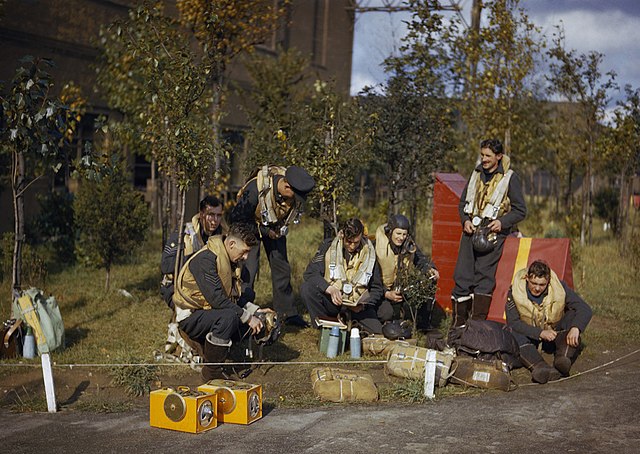 Photo: Canadian PO (A) S Jess, wireless operator of an Avro Lancaster bomber operating from Waddington, Lincolnshire carrying two pigeon boxes. Homing pigeons served as a means of communications in the event of a crash, ditching or radio failure Photo: Canadian PO (A) S Jess, wireless operator of an Avro Lancaster bomber operating from Waddington, Lincolnshire carrying two pigeon boxes. Homing pigeons served as a means of communications in the event of a crash, ditching or radio failure Battle of the Mediterranean Battle of the MediterraneanUS Army, Middle East Air Force B-24 Liberators sent to bomb the Maleme dispersal area fail to locate the target because of overcast. Photo: The British Submarine Thrasher, in harbour at Beirut, Syria, as seen from the workshops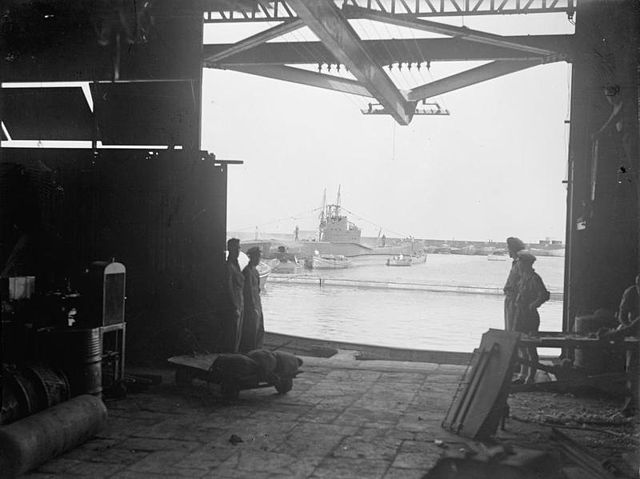 North African campaign North African campaignThe German 90th Light Division continues to slog it out with the Australians north and east of Tell el Eisa in the Battle of El Alamein. US Army, Middle East Air Force B-25 Mitchells hit a landing ground and claim one fighter shot down while P-40s flying escort claim three. Map: Second Battle of El Alamein: Operation Supercharge begins. Australian 9th Division attacks to open breach in Axis line for 2nd New Zealand Division: 11pm October 31st, 1942. Australian 9th Division fails and returns to starting position. Supercharge pushed back 24h: November 1st, 1942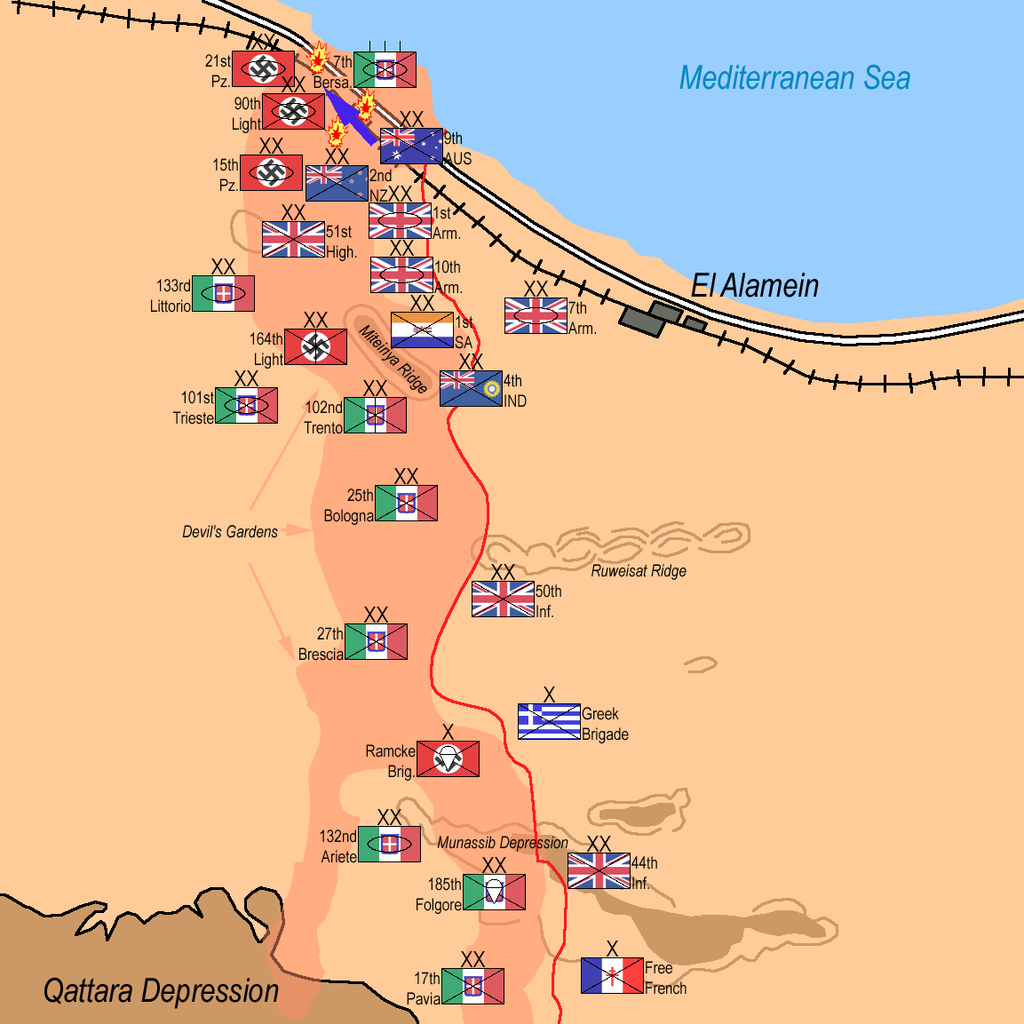 Photo: General Bernard L. Montgomery watches his tanks move up. North Africa Photo: General Bernard L. Montgomery watches his tanks move up. North Africa Photo: Sherman tanks of the Eighth Army move across the desert at speed as the Axis forces begin to retreat from El Alamein Photo: Sherman tanks of the Eighth Army move across the desert at speed as the Axis forces begin to retreat from El Alamein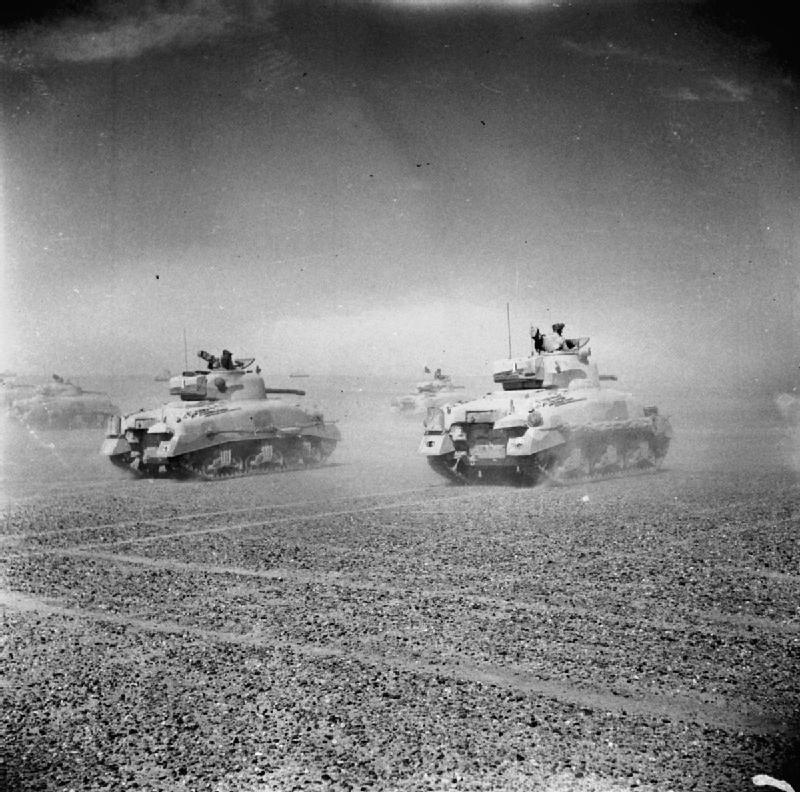 Photo: A Martin Baltimore Mark III overflys the target as bombs explode on the German-held landing ground at El Daba, Egypt, during a raid by No. 223 Squadron RAF in support of the Alamein offensive Photo: A Martin Baltimore Mark III overflys the target as bombs explode on the German-held landing ground at El Daba, Egypt, during a raid by No. 223 Squadron RAF in support of the Alamein offensive United States United StatesThe auxiliary aircraft carrier, ex-'Altamaha' (ACV-6, ex-Maritime Commission Hull 160) is completed and purchased by the USN and immediately transferred to the British Royal Navy under Lend-Lease. She is renamed HMS 'Battler' (D 18). United KingdomPhoto: HMS Fowey, Liverpool, 31 October 1942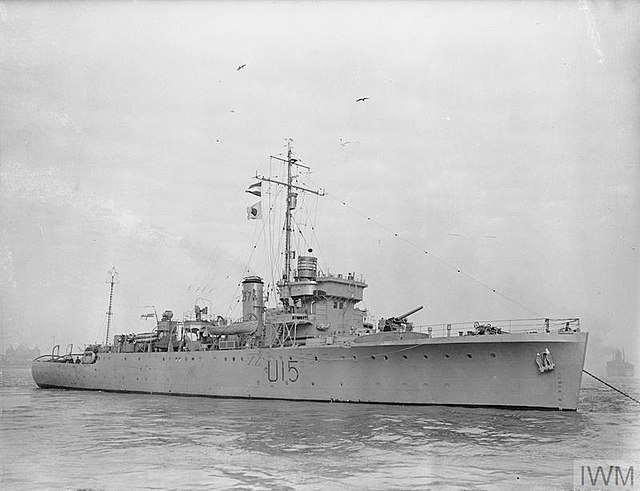 Pacific War Pacific WarALEUTIAN ISLANDS CAMPAIGN Eleventh Air Force weather and reconnaissance flight is flown over Japanese held Attu and Kiska Islands; over Kiska, the weather aircraft draws antiaircraft fire from Little Kiska Island; no other missions as all combat aircraft are alerted for a possible naval target. BISMARCK ARCHIPELAGO USAAF Fifth Air Force B-17's bomb shipping at Rabaul on New Britain Island. JAPAN The Central Agreement between the Japanese Army and Navy, concerning the strengthening of defenses in the Aleutian Islands, Territory of Alaska, U.S., is published as Navy Directive No. 155. The objective of the operations is to increase the land forces necessary for occupying and securing the western Aleutian Islands, thereby strengthening its defenses. NEW GUINEA CAMPAIGN In Papua New Guinea, the Australian 2/31st Battalion on the Kododa Track arrives in Isurava early in the afternoon. Meanwhile, USAAF Fifth Air Force A-20 Havocs bomb and strafe Nauro and the area to the north while B-25 Mitchells strafe supply trucks southeast of Gona. SOLOMON CAMPAIGN On Guadalcanal Colonel Tsuji Masanobu arrives at the Japanese 17th Army headquarters at Kokombona. He has retraced the route of the Japanese 2nd Division in 2.5 days wracked with malaria. Fresh men took a week to make this hike. He describes the failed attack and current situation. They abort plans to land the 38th Division east of the Lunga perimeter. The 1st Marine Division completes preparations for their offensive on Guadalcanal. The 5th Marine Regiment and 2d Marine Regiment (less 3d Battalion) move into attack positions along the Matanikau River. During the night of 31 October/1 November, Company E of the 5th Marine Regiment crosses the Matanikau River and outposts the west bank, and the 1st Engineer Battalion constructs three footbridges. USAAF Fifth Air Force B-17's bomb shipping in Buin, Bougainville- Faisi Island-Tonolai, Bougainville Island area.
|
|
lordroel
Administrator
Posts: 68,117 
Likes: 49,506
|
Post by lordroel on Nov 1, 2021 3:48:41 GMT
Day 1148 of World War II, November 1st 1942Eastern FrontAt Stalingrad, in November, after 3 months of carnage and slow and costly advance, the Germans finally reached the river banks, capturing 90% of the ruined city and splitting the remaning Soviet forces into 2 narrow pockets. Close combat between the Soviet garrison of Stalingrad (62d and 64th Armies) and the German 6. and 4. Panzerarmee of Heeresgruppe B continues, but the garrison has proved itself capable of weathering maximum effort of the Germans. In addition, ice floes on the Volga now prevented boats and tugs from supplying the Soviet defenders scross the river. Nevertheless, the fighting - especially on the slopes of Mamayev Kurgan and inside the factory area in the northern part of the city - continued as fiercely as ever. The battles for the Red October steel factory, the Dzerzhinsky tractor factory and the Barrikady gun factory became world famous. While Soviet soldiers defended their positions and took the Germans under fire, factory workers repaired damaged Soviet tanks and other weapons close to the battlefield, sometimes on the battlefield itself. Photo: Soviet soldiers making their way through the ruins of Stalingrad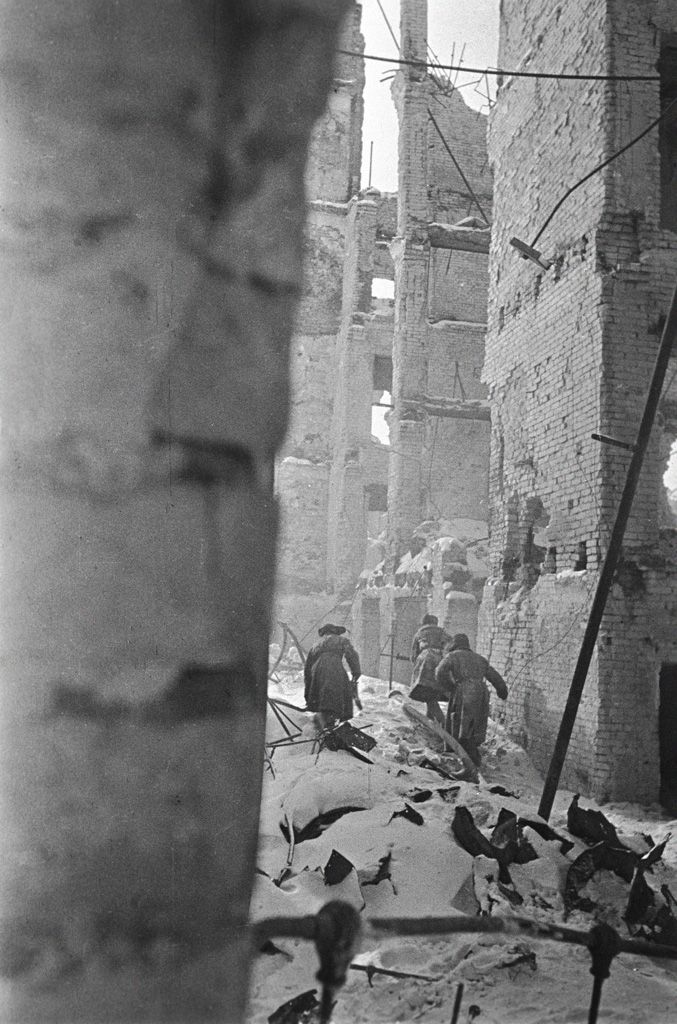 In their advance toward Ordshonikidse in the Caucasus, units of 3.Panzerkorps (von Mackensen) captured Alagir on the upper Terek river. The Red Army has frustrated every German effort to reach Grozny and is containing attacks toward Tuapse, but German Heeresgruppe A captures Alagir, blocking the Ossetian Highway, which extends from Alagir to Kutais. Air War over Europe Six RAF Bomber Command (A-20) Bostons bomb Ft. Rouge Airfield at St. Omer; three others bomb the docks at Calais as an alternative target. One Boston is lost. Battle of the MediterraneanEight US Army, Middle East Air Force B-24 Liberators strike the airfield and dispersal areas at Maleme. (Syscom) North African campaign US Army, Middle East Air Force P-40s escort RAF bombers and hit ground targets in the battle area around El Alamein. III./KGzbV 1 reported 27 Ju 52s on strength. Following the British Eighth Army counterattack at El Alamein, the Gruppe departed Tobruk and moved back to Maleme, Crete. Photo: A German 88 mm FlaK 36 gun which had been used as a tank attack weapon near El Aqqaqir, Egypt. The whole crew were killed and were found buried alongside the gun. Allied Sherman and Crusader tanks can be seen on the skyline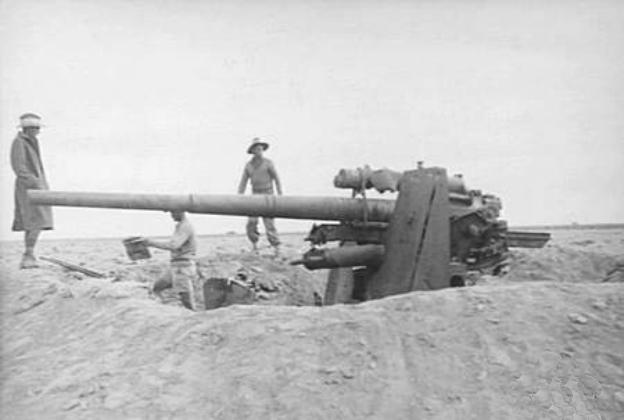 Pacific War Pacific WarINDIA AIR TASK FORCE (IATF) During Nov 42, the 9th Photographic Reconnaissance Squadron, Tenth Air Force, based at Karachi, India, with F-4s, sends a flight to operate from Kunming, China until July 1943 (first mission is 1 Dec). HAWAII HQ 307th Bombardment Group arrives at Hickam Field, Hawaii from the US. SOUTH PACIFIC AREA (Joint Chiefs of Staff): The 431st Bombardment Squadron, 11th BG (Heavy), moves from Viti Levu, Fiji , to Espiritu Santo with B-17s. During Nov, the 98th Bombardment Squadron, 11th BG (Heavy), based on Espiritu Santo, begins operating from Guadalcanal , Solomon with B-17s. SOUTHWEST PACIFIC AREA (Fifth Air Force): B-25's bomb the airfield and dump area at Lae. B-17's strike shipping in the Buin-Faisi, Shortland-Tonolai. Kahili Airfield is also attacked. Lost is B-17E 41-2635. Force landed at 7-Mile Drome is A-20A "Little Hellion" 40-166. A detachment of the 33d Troop Carrier Squadron, 315th Troop Carrier Group, begins operating from Cairns, Queensland, Australia with C-47s (squadron is enroute to Australia from the US). SOLOMON CAMPAIGN On Guadalcanal, the 1st Marine Division, with artillery, naval gunfire, and air support, launches an attack toward the Poha River. The 5th Marine Regiment, followed by the 2d Marine Regiment (less the 3d Battalion) in reserve, crosses footbridges over the Matanikau River at 0630 hours and drives west about 1,000 yards (914 meters) in two columns to positions short of Point Cruz, the 1st Battalion , the right flank column, meeting considerable delaying opposition along the coast. The Whaling Group (3d Battalion of the 7th Marine Regiment and scout-sniper detachment) crosses the river upstream and advances west on the inland route to protect the left flank of the 5th Marine Regiment. Photo: U.S. 5th Marines evacuate injured personnel during actions on Guadalcanal on November 1, 1942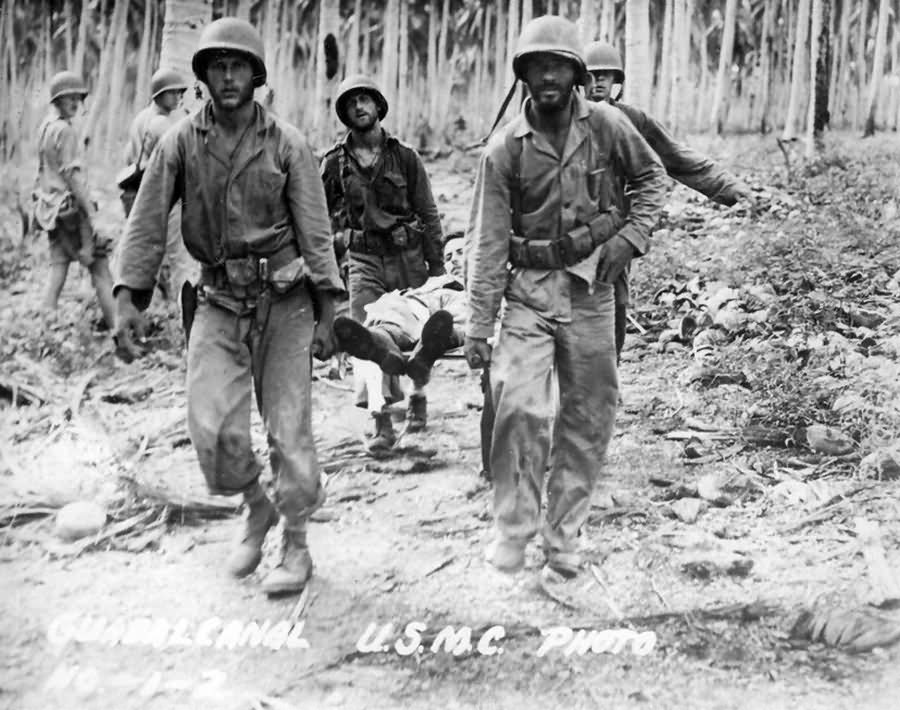 To forestall expected Japanese landings in the Koli Point area, east of the Lunga perimeter, the 2d Battalion of the 7th Marine Regiment starts east toward the Metapona River. The only authenticated US bayonet charge of the campaign is conducted by Company I. By nightfall they are west of Point Cruz. The first squadron of Marine MAG-11, Marine VMSB-132 begins arriving at Henderson Field, Guadalcanal. The squadron is equipped with SBD Dauntlesses. BOUGAINVILLE B-17's strike shipping in the Buin area of southern Bougainville Island. Kahili Airfield on southern Bougainville is also attacked. INDIAN OCEAN SS 'Mendoza', an 8,234 ton British Ministry of War Transport which sailed from Mombasa, East Africa, is torpedoed and sunk by the German submarine U-178 about 70 nautical miles ENE of its destination, Durban, South Africa. This ex-Vichy French ship is carrying 153 crew and some 250 passengers when it blew up taking the lives of 28 of her crew and 122 service personnel.
|
|
lordroel
Administrator
Posts: 68,117 
Likes: 49,506
|
Post by lordroel on Nov 2, 2021 3:49:22 GMT
Day 1149 of World War II, November 2nd 1942Eastern FrontOne of the most carefully organized and intensive Jewish roundups takes place in the Bialystok region when 110,000 Jews, who had been strictly confined to their villages, are now seized and eventually transported to Treblinka and Auschwitz concentration camps. In the Caucasus, the German 13.Panzerdivision of 3.Panzerkorps approaches the outskirts of Ordshonikidse, the southeastern- most point ever reached by the Wehrmacht on the entire Eastern front. Bitter street fighting continued in Stalingrad with neither side making much progress. Photo: Red Army soldiers with their PPSh-41 during street fighting in Stalingrad. November 1942 Battle of the Atlantic Battle of the Atlantic Pre-war, the 10,909 ton Dutch cargo-passer liner MV 'Zaandam' had sailed from Java, Netherlands East Indies, to New York; the vessel escaped from the Southwest Pacific in March 1942. Today, she is sailing from Capetown, South Africa, to New York when she is torpedoed and sunk by German submarine U-174 about 334 nautical miles (618 kilometers) NNE of Fortaleza, Ceara, Brazil. Her cargo includes 8,600 tons (7 802 metric tonnes) of chrome and copper ore. Also on board are 299 persons including 112 crew members and 18 U.S. Naval Armed Guards plus 169 passengers, most of them survivors from five Allied ships previously sunk off Capetown. Ten minutes after the first torpedo hit, another slams into the port side sinking the 'Zaandam' in less than two minutes. A total of 134 men lose their lives, leaving 165 survivors. A U.S. tanker picks up 106 survivors from two lifeboats on 7 November. A third lifeboat, containing around 60 persons, makes landfall near the town of Barreirinhas, Brazil, some days later. Two men from this lifeboat died. German submarine U-518 attacks targets off Bell Island in Conception Bay, Newfoundland. The sub's first torpedo is fired at a coal boat tied up at the Scotia Pier. It misses its original target, but strikes the pier causing heavy damage. The sub then fires three torpedoes at the 7,803 ton Canadian freighter SS 'Rose Castle' which is fully loaded with iron ore and waiting for a convoy; the ship sinks with the loss of 28-crewmen. The next target is the 5,633 ton Free French freighter P.L.M. 27 which is struck by one torpedo and sinks with the loss of 12 crewmen. North African campaign Map: Second Battle of El Alamein: 2nd New Zealand Division and 1st Armoured Division attack south and push back Trieste Division: 1am November 2nd, 1942. 15th Panzer Division and 21st Panzer Division counterattack- Tank Battle of Tell el Aqqaqir: 9am November 2nd, 1942. Ariete Armoured Division moves north: November 2nd, 1942. Trento, Bologna, Pavia, Brescia, Folgore Divisions and Ramcke Brigade begin retreat: 10pm November 2nd, 1942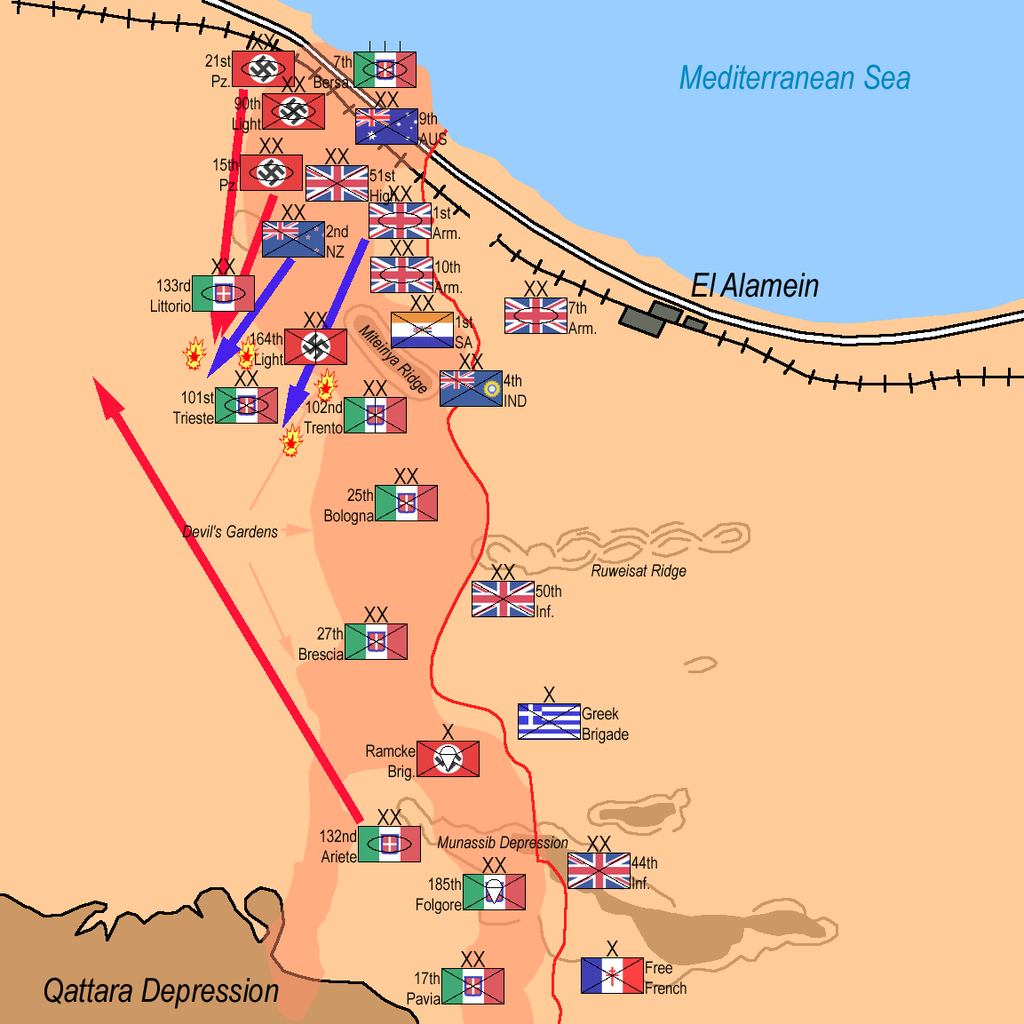 The British Eighth Army's XXX Corps opens a breakout assault, called Operation SUPERCHARGE, at 0100 hours. During the opening moves for Operation Surcharge, the movement by Montgomery's forces drew the last of the German armour into a counterattack, which was then countered by attacks by 1st Armoured Division. The New Zealand 2nd Division, in the lead, advances west under cover of an artillery barrage and secures a new corridor through the Axis mine fields. The 9th Armoured Brigade passes through the corridor in the mine field and establishes a bridgehead across the track extending south from Rahrnan. At daybreak, the armoured brigade meets furious opposition from an Axis antitank screen and sustains over 75% casualties, but maintains the bridgehead. X Corps armor begins debouching through the bridgehead, and the 1st Armoured Division becomes strongly engaged near Tel el Aqqaqir. By evening Rommel was down to 35 tanks and signalled Hitler that he could no longer prevent a breakthrough. Rommel decided to begin his retreat from El Alamein. More than 200 British tanks were put out of action. But at the end of the day, the Allies still had over 600 servicable tanks against the barely 30 available for the Germans. With fuel for even these tanks desperately short, Rommel ordered a retreat, leaving the way open for the British Eighth Army. Photo: A Priest 105 mm self-propelled gun of the 1st Armoured Division preparing for action, 2 November 1942 At 06.30 hours, on a coastal road between El Alamein and Mersa Matruh, a RAF No. 260 sqdn Kittyhawk II collided with a Bf 109G-2/trop, cutting the fuselage in half. The Kittyhawk lost a left wing and the pilot was badly hurt in the thigh from the antenna while bailing out. Fw. Horst Schlick of 1./JG 77 in the Bf 109, survived after a parachute landing. The Kittyhawk was claimed as his 9th victory. Another pilot from JG 77, Uffz. Heinrich Stockmann of 9./JG 77, was captured and made a prisoner after combat with a Spitfire near El Alamein. Photo: A knocked-out Churchill III among abandoned Italian M13/40 tanks at El Alamein, 2 November 1942. The Churchill was one of six rushed to the front line and placed under control of 7th Motor Brigade, 1st Armoured Division, in time for Montgomery's offensive at El Alamein. The group was named Kingforce after its commander, Major Norris King MC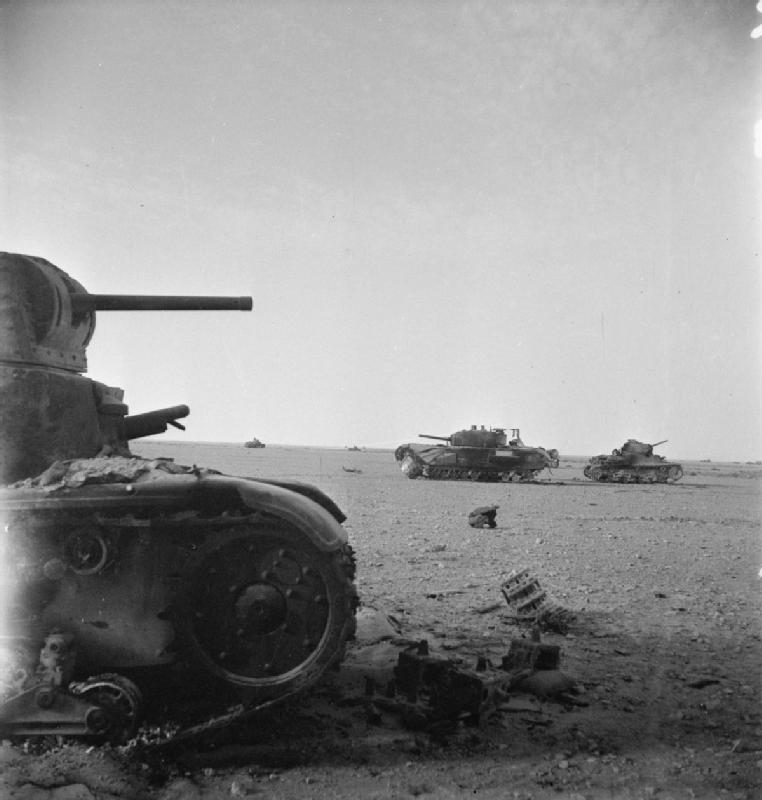 U.S. Army, Middle East Air Force B-25's bomb a track extending south from Rahman as the British 9 Armoured Brigade establishes bridgeheads across the track; other B-25 Mitchells attack tanks and other targets in support of the assault; P-40s fly escort and strafing missions in the battle area. U.S. Army, Middle East Air Force B-17's bomb shipping and jetties in Tobruk harbor. United StatesPhoto: The U.S. Navy light cruiser USS Memphis (CL-13) off New York City on 2 November 1942, with a barge and harbor tug alongside. Note the barely visible CXAM radar aft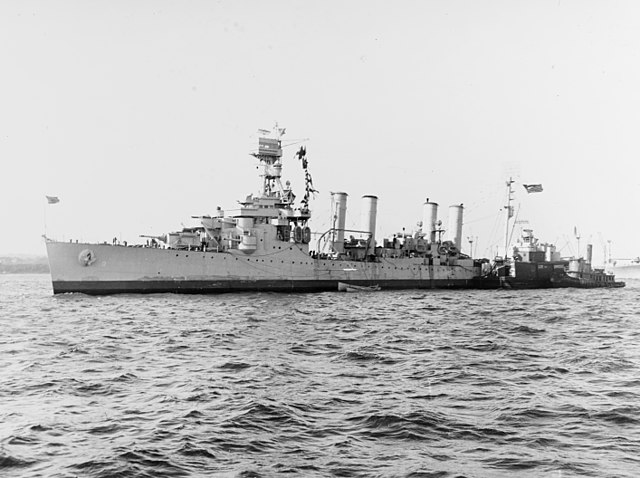 Pacific War Pacific War JAPANESE OCCUPIED NETHERLANDS EAST INDIES USAAF Fifth Air Force B-26 Marauders bomb Dili on East Timor Island, Netherlands East Indies. HAWAII (Seventh Air Force): The 370th, 371st, 372d and 424th Bombardment Squadrons, 307th BG (Heavy), arrive at Kipapa Field, Wheeler Field, Kahuku and Dillingham Field, Hawaii respectively from the US with B-24s (sea-search missions are flown in Nov-Dec). SOUTH PACIFIC AREA (Joint Chiefs of Staff): The 68th Fighter Squadron, 347th Fighter Group, arrives on New Caledonia from Tongatabu, Tonga with P-40s (first mission is 12 Nov). NEW GUINEA CAMPAIGN In Papua New Guinea, the Australian 25th Brigade, which has reentered the battle for the Kokoda Track, seizes Kokoda and its airfield, greatly facilitating supply and reinforcement of Australians in this area. Piecemeal movement by night of the 128th Infantry Regiment, U.S. 32d Infantry Division, less elements still at Port Moresby, by lugger from Warngela to Pongani and Mendaropu is completed by this time and supplies are being accumulated. General Douglas MacArthur, Commander in Chief, Southwest Pacific Area, sets 15 November as the tentative date for an attack to reduce the Buna-Gona beachhead and agrees to a proposal by General Thomas Blamey, Commander in Chief Allied Land Forces Southwest Pacific and Commander in Chief Australian Military Force, that troops be transferred by air to Pongani. - USAAF Fifth Air Force B-17s sink a Japanese army cargo ship off Buna. NEW HEBRIDES ISLANDS A "Glen" small seaplane is launched by a Japanese submarine and flies a reconnaissance mission over Efate Island. PACIFIC OCEAN In the Tonkin Gulf of the South China Sea, USN submarine USS Tambor lays mines in Hainan Strait between Hainan Island and the Chinese mainland. BISMARK SEA In the Bismarck Sea, USAAF Fifth Air Force B-17's attack shipping northeast of Buna, Papua New Guinea while. SOLOMON CAMPAIGN In the Solomon Sea, USAAF Fifth Air Force B-25's strike at a convoy south of New Britain Island, Bismarck Archipelago. On Guadalcanal, the 3d Marine Regiment envelops the Japanese on the coast at Point Cruz. The 3d Battalion joins the 1st Battalion in the coastal battle east of Point Cruz while the 2d Battalion, on the left, drives north to the coast west of Point Cruz and turns east, trapping the Japanese. The 2d Marine Regiment (less 3d Battalion) moves forward on the left of the 5th Marine Regiment to continue a westward attack. Stores, ammunition, and one Army and one Marine Corps 155 mm gun battery arrive at Lunga Point. The two batteries are the heaviest U.S. artillery to reach the island and the first capable of countering enemy fire effectively. East of the Lunga perimeter, the 2d Battalion of the 7th Marine Regiment crosses the Metapona River mouth and establishes itself near Tetere village. During the night 2/3 November, the Japanese 17th Army lands supplies and about 1,500 men east of Koli Point to supply and reinforce the Japanese already there; they are ordered to construct an airfield.
|
|
lordroel
Administrator
Posts: 68,117 
Likes: 49,506
|
Post by lordroel on Nov 3, 2021 3:49:20 GMT
Day 1150 of World War II, November 3rd 1942Eastern Front Premier Joseph Stalin describes U.S. military aid as of little effect. Photo: Assault unit of the 305. Infanterie-Division in action in Stalingrad
 Air War over Europe Air War over Europe During the night of 3/4 November, RAF Bomber Command sends 29 Wellingtons to mine Biscay ports; one aircraft is lost. Nine aircraft lay mines off La Pallice and five each off Brest, Lorient and St. Nazaire. The Lockheed (PV-1) Ventura Mk. I flies its first mission with RAF Bomber Command. Three aircraft are unable to find their primary target, a factory at Hengelo, and bomb railways instead. No aircraft lost on this day. During the day, RAF Bomber Command dispatches three Stirlings to Lingen to bomb a factory. North African campaign The 1st Armoured Division of X Corps, British Eighth Army, is unable to penetrate the Axis' antitank screen. Since the Axis is obviously withdrawing, General Bernard Montgomery, General Officer Commanding Eighth Army, orders an attack to outflank the screen. During the night of 3/4 November, the 51st Infantry Division and a brigade of the Indian 4th Division drive quickly to the Rahman track south of Tel ci Aqqaqir, breaking through the screen in the southern sector and forcing the Axis to turn it. Allied aircraft fly over 400 sorties against enemy retreating along coastal road. Rejecting out of hand Field Marshal Rommel's proposal to withdraw the Afrika korps, now down to about 40 tanks, to the Fuka line, Adolf Hitler orders him to stand and fight. Map: Second Battle of El Alamein: Axis units begin their retreat: November 3rd, 1942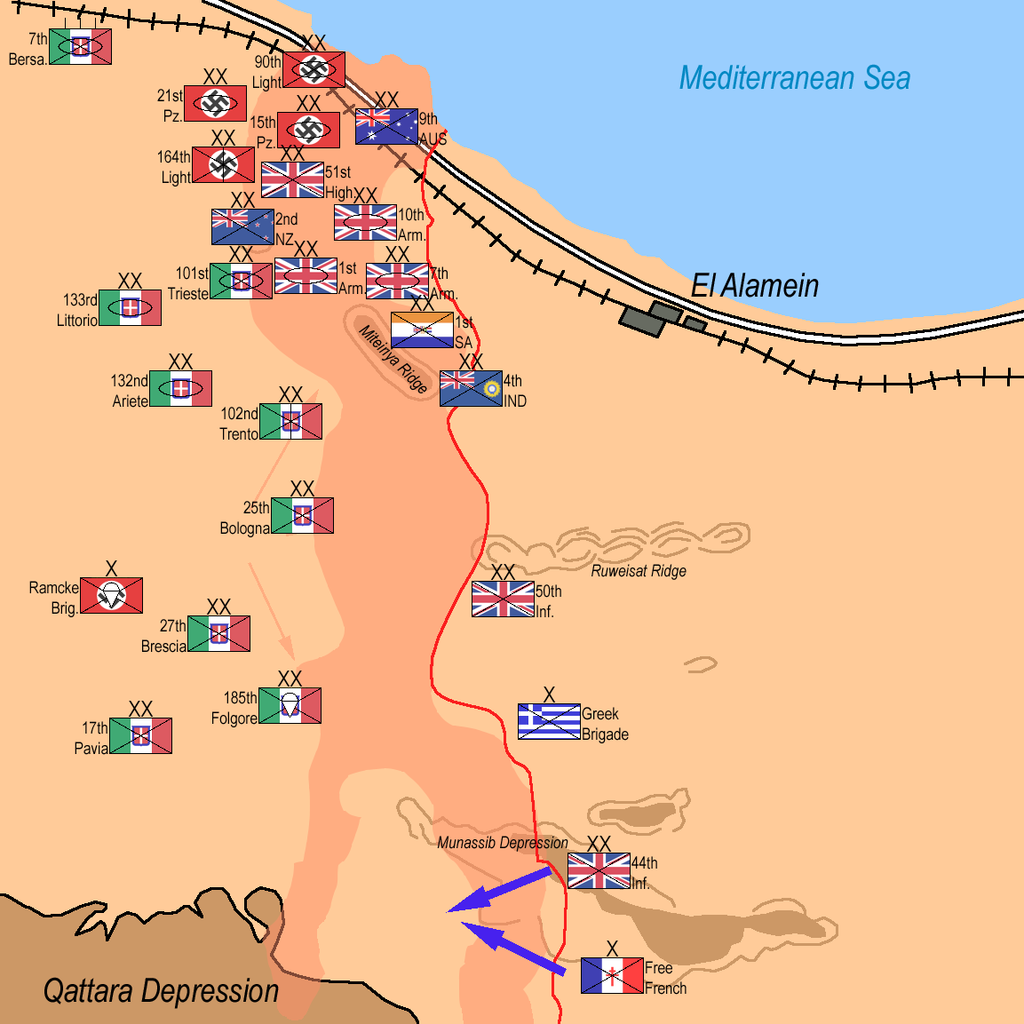 Map: Second Battle of El Alamein: Axis units halt their retreat on order from Adolf Hitler: November 3rd, 1942 Map: Second Battle of El Alamein: Axis units halt their retreat on order from Adolf Hitler: November 3rd, 1942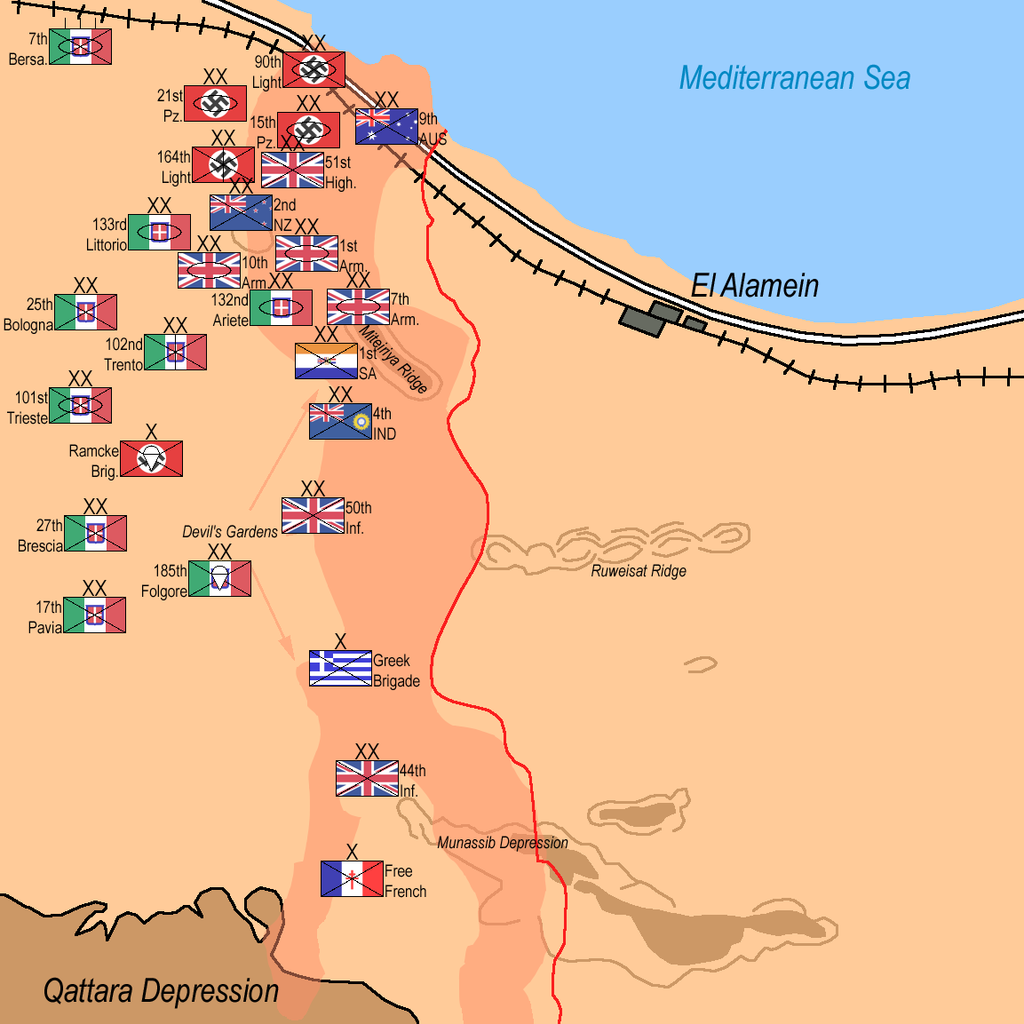 Photo: A column of Stuart tanks moving up to the front, 3 November 1942 Photo: A column of Stuart tanks moving up to the front, 3 November 1942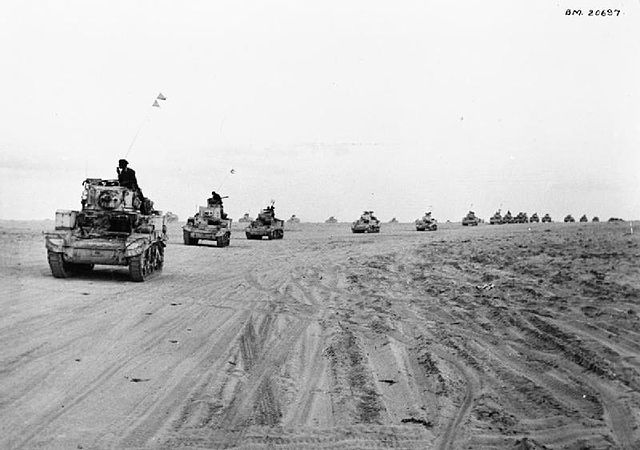 Five US Army, Middle East Air Force B-24 Liberators bomb the port area at Tobruk. US Army, Middle East Air Force B-25's bomb tanks, motor transport, landing ground, ammunition dumps, mainly in the Rahman Track area and on the road between Fuka and El Daba, and also hit town of Fuka and Ghazal station; P-40s fly several escort and fighter-bomber missions, attacking ground targets in support of the British Eighth Army. Allied aircraft fly 400+ sorties against Axis troops retreating along the coastal road. Photo: A German 88mm anti-tank gun that was captured and restored to working condition by Australian troops, 3 November 1942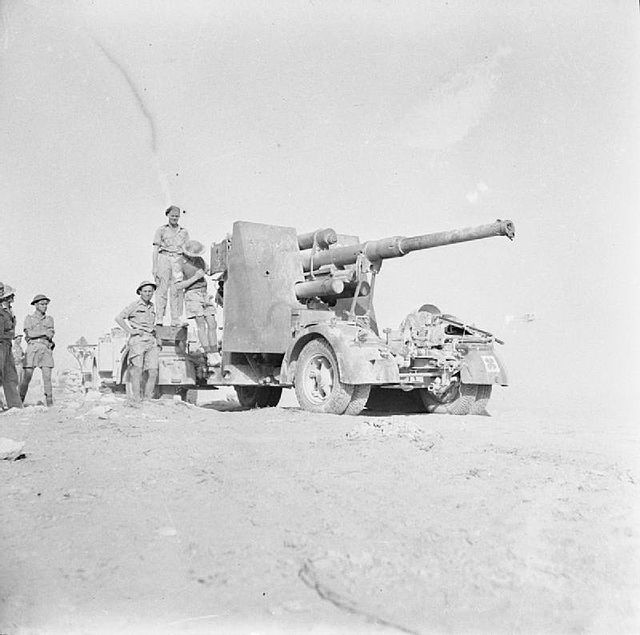 Because of the Allied advances at El Alamein, I./JG 27 was rushed back from Sicily, but even this most experienced of the desert Jagdgruppen could do nothing to influence events on the ground. It had claimed its final 13 victories over Egypt this day, 2 of which were credited to Gruppenkommandeur Hptm. Gerhard Homuth, raising his total to 61. Pacific War BISMARCK ARCHIPELAGO USAAF Fifth Air Fore B-17's attack a ship south of Gasmata, New Britain Island. CHINA Chinese Generalissimo Chiang Kai-shek agrees conditionally to plans formulated during a recent conference in India, promising 15 divisions from Yunnan, provided the Allies furnish strong sea and air forces. Lt. General Joseph Stilwell, Commander in Chief US China-Burma-India Theater of Operations, Chief of Staff to Chiang Kai-Shek and Commander in Chief Northern Area Combat Command (NCAC) in Burma, is to command the Chinese Army in India (CAl) during Burma operations. Chiang’s promise of the Yunnan divisions leads to accelerated planning for the reorganization of Yunnan force, called Y-Force. JAPANESE OCCUPIED NETHERLANDS EAST INDIES USAAF Fifth Air Force B-26 Marauders bomb Dili on Portugese Timor Island. NEW GUINEA CAMPAIGN In Northeast New Guinea, USAAF Fifth Air Force B-17's bomb the airfield and wharf at Lae. SOLOMON CAMPAIGN On Guadalcanal, the 2d Battalion 7th Marine Regiment, begins a firefight with Japanese units east of the Metapona River. Without radio contact or air or naval support, Colonel Herman Hanneken, commander of the 7th Marine Regiment, conservatively pulls back. When he is finally able to contact Major General Alexander Vandegrift, Commanding General 1st Marine Division, in the afternoon, the 1st Battalion 7th Marine Regiment, by boat, with the 2nd and 3rd Battalions 164th Infantry Regiment, are sent to reinforce. With initial assistance of the Cactus Air Force, and the artillery of the 3rd Battalion 10th Marine Regiment, they turn the tide east of the Lunga Perimeter. In the closing moments the 2d Battalion receive friendly fire from the Cactus Air Force. General Hattori has arrived on Guadalcanal to observe and report the situation of the 17th Army to Tokyo. His initial accounts are of battalions crushed by shelling; the "actual situation is beyond imagination. " He reports that no future contribution from the 2nd Division should be counted on.
|
|
lordroel
Administrator
Posts: 68,117 
Likes: 49,506
|
Post by lordroel on Nov 4, 2021 3:47:58 GMT
Day 1151 of World War II, November 4th 1942North African campaign 4 November was the day British and Commonwealth forces broke through the Axis front at El Alamein. Rommel's great retreat had begun. British X Corps reached open ground. The fighting caused heavy loses of the Axis Ariete, 90th Light and HQ units before they broke off the action and retreated. The Axis forces retreated toward Fuka.The Afrika Korps was forced from the Fuka Line in the face of massive attacks by the British Eighth Army. Despite Eighth Army commander General Bernard Montgomery's orders, the British fail to advance. The Italian 20th Motorized Corps was destroyed. Rommel re-issued his orders for retreat with only 12 tanks left. 10,724 Axis prisoners were taken by the British, including 9 generals. German General Von Thoma, acting commander of Panzerkorps Africa, is captured. As Panzerarmee Afrika was being ground into dust and bones, General von Thoma rode a tank of his headquarters unit directly into the fire of the British lines and after having it shot out from under him, he climbed out of the burning hilk and waited for capture. He dined with Montgomery that same night. British Commonwealth Forces lose 13,500 troops, but win in a decisive victory over the Axis Forces. Map: Second Battle of El Alamein: 9th Australian, 2nd New Zealand, 1st Armoured, 7th Armoured and 10th Armoured attack: 7am November 4th, 1942. 1st Armoured and 10th Armoured break through and drive towards the coast. 2nd New Zealand Division moves toward Fuka destroying the remnants of Bologna and Trento Divisions on its way. 7th Armoured Divisions encircles Ariete Division, which is destroyed. Axis forces flee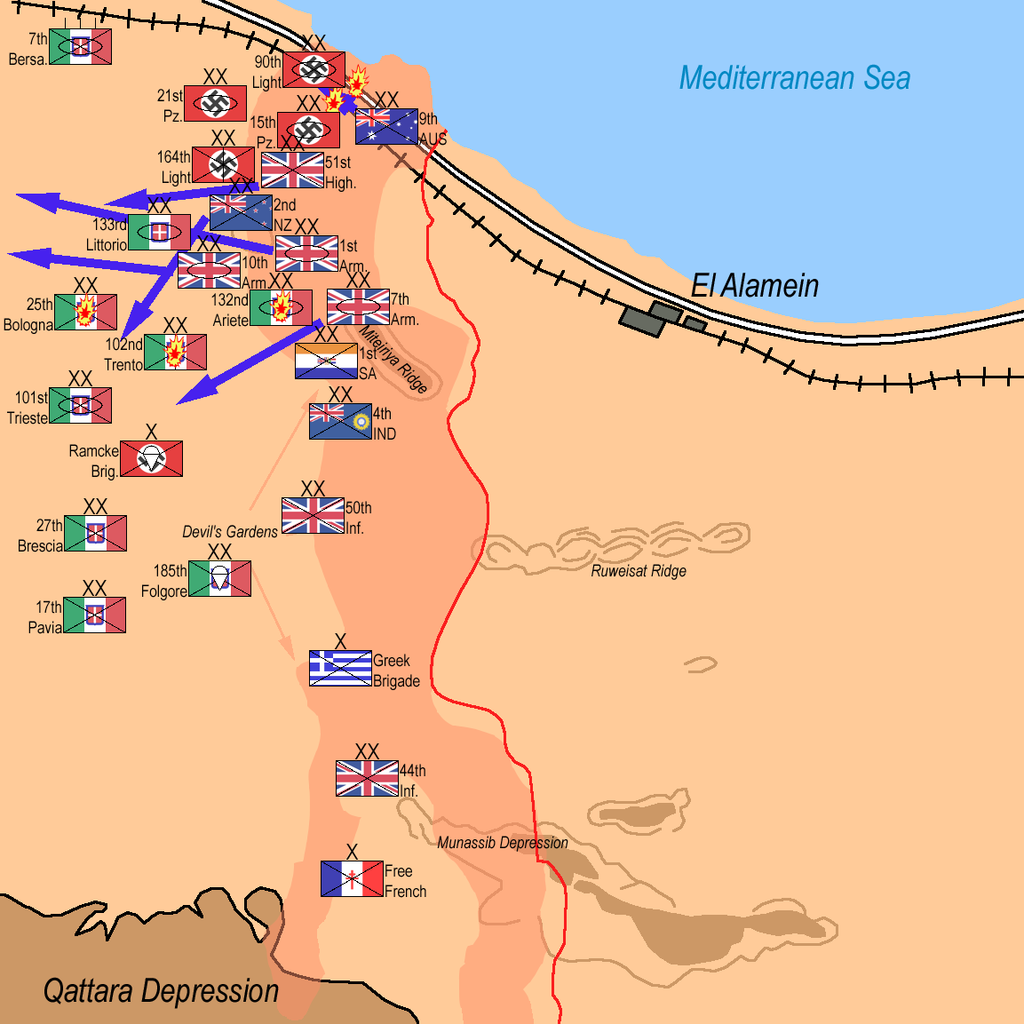 B-25s and P-40s attacked motor transports and troops retreating west from the El Alamein battleline with the British in pursuit. Further to the west of the battle, one of a pair of B-24s claimed by III./JG 27 provided the now Oberleutnant Werner Schroer with his 60th score. 9 B-24s bombed Benghazi harbour, hitting 3 ships and claiming one German fighter shot down. 12 Kittyhawks from RAF No. 260 Sqdn, while escorting bombers, met 4 Bf 109s, one of which F/O Gilboe collided with. Both fighters crashed. Lieutenant General Frank M Andrews replaces Brigadier General Russell L Maxwell as Commanding General USAFIME. Twenty five US Army, Middle East Air Force B-24's bomb Bengasi harbor, hitting three ships and claiming one Axis fighter shot down. French Admiral Jean Darlan, Head of the French Armed Forces and High Commissioner in North Africa, is told that his son has been hospitalized with polio in Algiers. The situation is so serious that a coffin has been ordered and the admiral rushes from Vichy France to Algiers to be with him. Battle of the MediterraneanII./JG 51 was ordered from the middle sector of the Eastern Front to Sicily. 3./JG 1 was ordered to Sicily and later to Africa. USN submarines USS 'Shad', 'Gunnel', 'Herring', 'Barb', and 'Blackfish' are deployed to reconnoiter French North African waters off Rabat, Fedala, Casablanca and Safi, French Morocco, and Dakar, French West Africa, in advance of Operation TORCH (the invasion of Northwest Africa). Following up on shipping concentrations at Gibraltar, there are ten German and 21 Italian submarines on patrol in the western Mediterranean. They will have some success during the next two weeks. Italian torpedo boat 'Centauro' is sunk off Benghazi, Libya, by British bombers. United Kingdom Prime Minister Winston Churchill takes the chair of the Cabinet Anti-U-Boat Warfare Committee. Including the service chiefs, some government ministers and scientists in radar and operational research, this type of committee is unmatched by the Axis powers. Pacific WarALEUTIAN ISLANDS CAMPAIGN Japanese submarine RO-65 is sunk in the harbor of Kiska Island, when she accidentally dives into a reef while seeking to avoid an attack. Bad weather at Umnak Island and Dutch Harbor on Unalaska Island and a flooded field at Adak Island preclude missions by the USAAF Eleventh Air Force; a new Adak Island runway permits an air alert. JAPANESE OCCUPIED NETHERLANDS EAST INDIES USAAF Fifth Air Force B-26 Marauders bomb Japanese strongpoints at Aileu on Portugese (East) Timor Island. INDIAN OCEAN THEATRE - BATTLE OF MADAGASCAR (OPERATION STREAM LINE JANE) On Madagascar, the Vichy French Governor General again seeks peace terms from the British and accepts those rejected on 17 September. FIJI ISLANDS Japanese submarine I-31 launches a "Glen" seaplane to reconnoiter Suva. NEW CALEDONIA Japanese submarine I-9 launches a "Glen" seaplane to reconnoiter Nouméa, New Caledonia Island. NEW GUINEA CAMPAIGN In Papua New Guinea, the Australian 16th Brigade begins an attack on Oivi and finds the Japanese prepared fora firm stand. Colonel Leif Sverdrup, the deputy to the Southwest Pacific Area Engineer Officer, by this time has cleared sites for three more airfields in the general vicinity of Dyke Ackland Bay, the most important of these at Pongani. In Northeast New Guinea, USAAF Fifth Air Force B-17's and B-25's bomb the town and harbor of Salamaua. In Papua New Guinea, A-20's hit troop concentrations at Oivi, where an Australian attack meets firm resistance; transports fly most of the remainder of the U.S. 128th Infantry Regiment, 32d Infantry Division, to Wanigela. AUSTRALIA HQ 90th BG and the 319th, 320th, 321st and 400th Bombardment Squadrons arrive at Iron Range, Queensland, Australia from Hawaii with B-24s (first mission is 13 Nov). Photo: A gun crew from the Australian Army's 14th Heavy Anti-Aircraft Battery loading a shell into their 3.7 Inch anti-aircraft gun at Darwin SOLOMON CAMPAIGN Lunga perimeter command is reorganized and garrison is reinforced, two sectors are established, the commander of each being responsible to 1st Marine Division headquarters. Brigadier General William H. Rupertus, Assistant Commanding General of the division, is assigned the sector east of Lunga River and Brigadier General Edmund B. Sebree, Assistant Commanding General of the Americal Division, the western sector. The 8th Marine Regiment, reinforced, of the 2d Marine Division debarks from a naval task force in the Lunga-Kukum area and is attached to 1st Marine Division. The 1st Marine Division halts their westward offensive short of Kokumbona because of a Japanese threat east of perimeter. The 2d Marine Regiment (less 3d Battalion), reinforced by the 1st Battalion of the 164th Infantry Regiment, after driving 2,000 yards (1829 meters) west of Point Cruz, breaks off their attack and digs in at Point Cruz; the 5th Marine Regiment and the Whaling Group return to positions east of the Matanikau River. East of the perimeter, Brigadier General Rupertus and Headquarters and 1st Battalion, 7th Marine Regiment, arrive in the Koli Point area to assist the 2d Battalion, 7th Marine Regiment. The 164 Infantry Regiment (less 1st Battalion) and Company B of the 8th Marine Regiment march to the west bank of the Nalimbiu River in the region south of the 7th Marine Regiment and elements start north along the river. Meanwhile, the naval task force transporting the 8th Marine Regiment lands forces at Aola Bay to establish an airfield. The Aola Force (1st Battalion of 147th Infantry Regiment; companies C and E of the 2d Marine Raider Battalion; the 5th Defense Battalion detachment; Battery K of the 246th Field Artillery Battalion, Americal Division; and 500 naval construction troops) establishes a beachhead a little east of the Aola River without opposition. This landing is the result of the cancellation of the landings on Ndeni Island in the Santa Cruz Islands; Rear Admiral Richmond K. Turner, commander of Amphibious Force, South Pacific Force, wants to build another airfield there. Coastwatcher Martin Clemens and Major General Alexander Vandegrift, Commanding General 1st Marine Division, oppose this plan. Work is begun at once on an airfield, but the site is later found unsuitable. The 2d Raider Battalion is ordered to Koli Point. USN cruisers and destroyers of Task Group 65.4 bombard Japanese positions near Koli Point, Guadalcanal.
|
|
lordroel
Administrator
Posts: 68,117 
Likes: 49,506
|
Post by lordroel on Nov 5, 2021 8:50:28 GMT
Day 1152 of World War II, November 5th 1942Eastern FrontThe German attacks begin to lose steam south of Terek in the Causasus, but nevertheless continue already nearing Ordzhonikidze. Battle of the AtlanticGerman submarine U-408 is sunk about 121 nautical miles (223 kilometers) north of Akureyri, Iceland. The sub is caught on the surface by a USN PBY-5A Catalina of Patrol Squadron VP-84 based at Fleet Air Base Reykjavik, Iceland; the aircraft dropped four depth charges which land aft of the conning tower while the sub is submerging. All 45 hands were lost. Battle of the MediterraneanLieutenant General Dwight Eisenhower, Commander-in-Chief Allied Expeditionary Force (AEF), arrives at Gibraltar. His headquarters includes Admiral Sir Andrew Cunningham, Naval Commander-in- Chief, AEF; Major General James H. Doolittle, Commanding General USAAF Twelfth Air Force; Air Marshal Sir William Welsh, Air Officer Commanding British Eastern Air Command; and Lieutenant General Sir Kenneth General Officer Commanding, British First Army, the main ground formation. British submarine HMS 'Seraph', under the temporary command of U.S. Navy Captain Jerauld Wright, embarks General Henri Giraud and a party of French officers in the Gulf of Lyons. The general will transfer to a (PBY) Catalina on the 7 November for further transportation to Gibraltar. North African campaign General Bernard L Montgomery, General Officer Commanding British Eighth Army, announces that the British have won a complete and absolute victory in Egypt and General Erwin Rommel's armies are in full retreat. The Eighth Army regroups and continues pursuit of the Axis forces. X Corps, now consisting of the 1st and 7th Armoured Divisions and the New Zealand 2d Division, pushes rapidly west, overcoming rear guard resistance near Fuka. XXX Corps takes up positions between El Alamein and Matruh while XIII Corps is given the task of mopping up battle zone. While the Italian Infantry takes heavy losses, the main British pursuit is held up by a shortage of fuel and a minefield. The minefield is a dummy field laid out previously by the British themselves. Photo: a Matilda Scorpion flail tank in action, 5 November 1942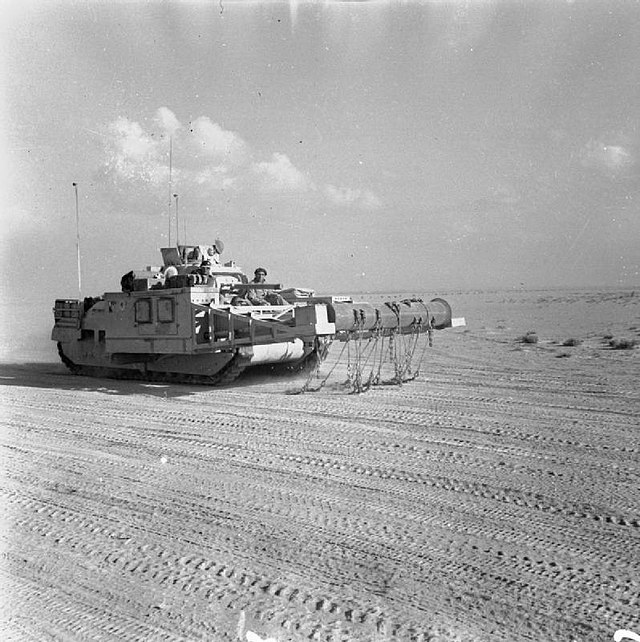 Photo: Sherman tanks of 'C' Squadron, 9th Queen's Royal Lancers, 2nd Armoured Brigade, 1st Armoured Division, 5 November 1942 Photo: Sherman tanks of 'C' Squadron, 9th Queen's Royal Lancers, 2nd Armoured Brigade, 1st Armoured Division, 5 November 1942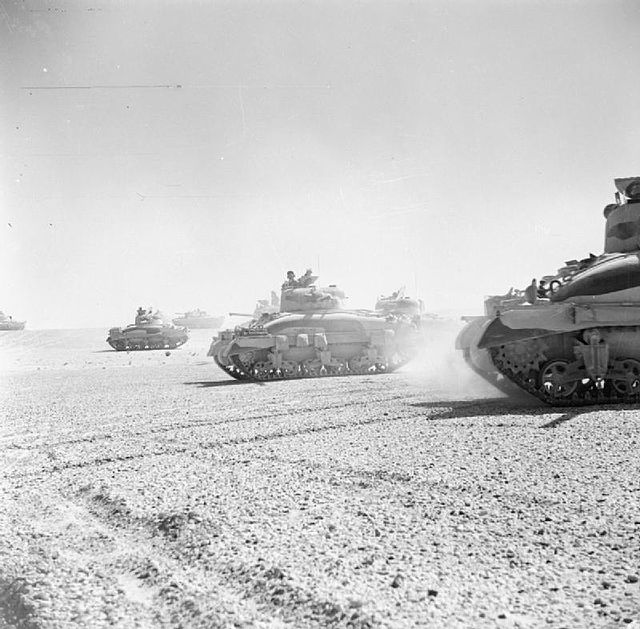 Photo: Churchill III tanks of 'Kingforce', 1st Armoured Division, 5 November 1942. The unit was named Kingforce after its commander, Major Norris King MC Photo: Churchill III tanks of 'Kingforce', 1st Armoured Division, 5 November 1942. The unit was named Kingforce after its commander, Major Norris King MC Photo: Infantrymen examine the remains of a knocked-out German PzKpfw IV tank, blown up by sappers to prevent it being recovered by the enemy, 5 November 1942 Photo: Infantrymen examine the remains of a knocked-out German PzKpfw IV tank, blown up by sappers to prevent it being recovered by the enemy, 5 November 1942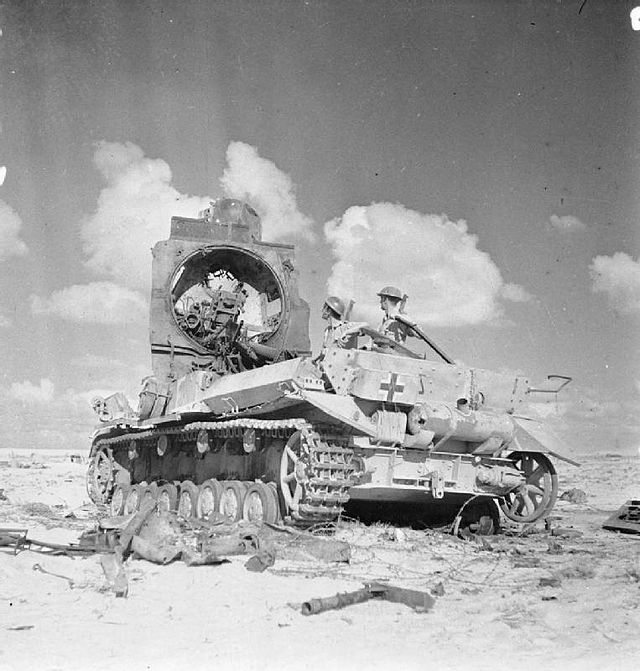 US Army, Middle East Air Force P-40s bomb targets on the Fuka road and patrol the Sidi Hanaish area while B-25 Mitchells also bomb motor transport. United States Photo: The U.S. Navy destroyer USS Champlin (DD-601) in Boston Harbor, Massacchusetts (USA), on 5 November 1942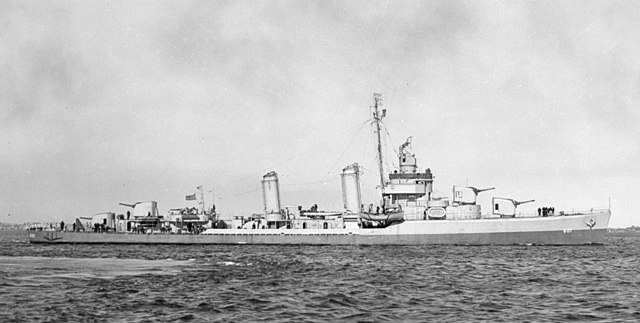 Pacific War INDIAN OCEAN THEATRE - BATTLE OF MADAGASCAR (OPERATION STREAM LINE JANE) Troops of the British East African Command complete their occupation of the French colony island of Madagascar. Fearing that Vichy might hand over the island to the Japanese in case Ceylon fell, British Prime Minister Winston Churchill ordered Operation IRONCLAD to proceed on 5 May when the naval base at Diego Suarez was secured. Hostilities against French Vichy forces on the island ceased at 1400 hours. NEW GUINEA CAMPAIGN General Douglas MacArthur, Supreme Commander of the Allied Forces in the Southwest Pacific, arrives in Point Moresby, Papua New Guinea, where the Advanced Echelon of General Headquarters opens to direct operations. The Australian 2/2nd and 2/3rd Battalions, 16th Brigade, 7th Division, continue heavy fighting against the Japanese at Oivi in Papua New Guinea. PACIFIC OCEAN A single USAAF Fifth Air Force B-25 attacks a Japanese destroyer off the southern tip of New Ireland Island, Bismarck Archipelago; no hits are scored. SOLOMON CAMPAIGN On Guadalcanal, the 7th Marine Regiment establishes a bridgehead on the east bank of the Nalimbiu River. The Army's 164th Infantry Regiment (less 1st Battalion) continues toward Koli Point, the 3d Battalion reaching it after nightfall. Aola Force transports complete unloading operations and withdraw. The run of the Tokyo Express tonight is commanded by Captain Sato Torajiro. The Cactus Air Force strikes for some damage, but not enough to stop the run. INDIA AIR TASK FORCE In India, the 25th Fighter Squadron, 51st Fighter Group, based at Karachi, sends a detachment to operate from Sadiya with P-40s.
|
|
lordroel
Administrator
Posts: 68,117 
Likes: 49,506
|
Post by lordroel on Nov 6, 2021 14:59:49 GMT
Day 1153 of World War II, November 6th 1942YouTube (The Allies Break Through)Eastern Front Halted before Ordshonikidse in the Caucasus, 13.Panzerdivision was fighting to prevent being cut off by superior Soviet forces attacking its flanks and rear. In a speech to the Congress of Soviet Deputies, Premier Joseph Stalin warns the U.K. and U.S. that the absence of a second front against Fascist Germany may end badly for all freedom-loving countries, including the Allies themselves. He declares that the aim of the coalition is to save mankind from reversion to savagery and mediaeval brutality. Fighting continues in Stalingrad area but on a diminishing scale. Air War over Europe During the day, RAF Bomber Command dispatches 14 Wellingtons and five Lancasters on cloud-cover raids: four each bomb Osnabruck and Wilhelmshaven and one each hits Emden and Norden. During the day, ten RAF Bomber Command (PV-1) Venturas in fours and twos carry out low-level raids including hitting a steel mill at Ijmuiden and the port area at Rotterdam; three aircraft are lost. 21 Sqdn. RAF dispatches four Venturas in an attack against shipping at Maasluis. The weather was misty and they made landfall in the wrong area. The leader, Wg. Cdr. Werfield, chose to bomb a ship in Rotterdam while another bombed barges in Maasluis, one abandoned the mission and Ventura YH-X disappeared. During the day, 12 (A-20) Bostons bomb Carpiquet Airfield, 3.5 miles (5,6 kilometers) west of Caen. During the night of 6/7 November, RAF Bomber Command sends bombers to mine areas off three seaports: 11 mine the Gironde Estuary, ten lay mines off La Pallice and five lay mines off Lorient. Two Stirlings are lost. During the night of 6/7 November, ten RAF Bomber Command lay mines in the Frisian Islands. One Stirling is lost. Photo: A Supermarine Spitfire Mark IX of No 64 Squadron, Royal Air Force undergoing an engine overhaul just outside a blister hangar on the north side of Fairlop airfield in Essex. The aircraft had been pushed outside the hangar for the photograph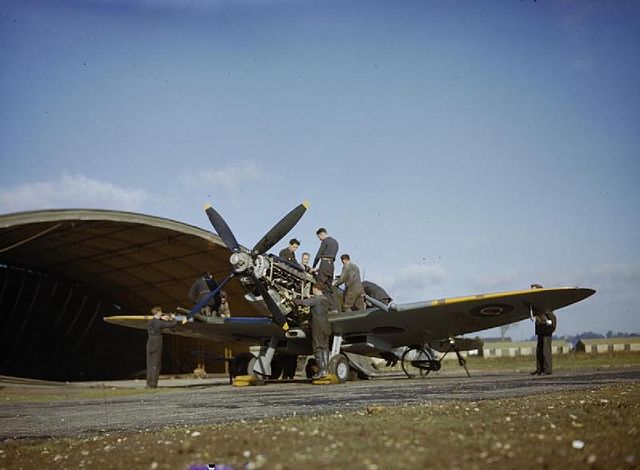 Battle of the Atlantic Battle of the Atlantic German submarine U-68 Commander Karl-Friedrich Merten torpedoes and sinks the 8.034 ton British passenger ship SS 'City of Cairo' about 453 nautical miles (840 kilometers) south of the British island of St. Helena in the South Atlantic Ocean or 1,401 nautical miles (2 595 kilometers) west-northwest of Cape Town, South Africa. About 100 of the 300 passengers and crew survive. Merten believed the ship was a cargo vessel and after the sinking, the U-boat commander helps rescue survivors still in the water and has them placed in the lifeboats. He then departs the scene with an apology for the sinking but not before he provides the survivors with precise details of how to reach St. Helena. However, one lifeboat drifts for 51 days before reaching the coast of Brazil; only two of its original 18 occupants survive. Battle of the MediterraneanDuring the night of 6/7 November, RAF Bomber Command dispatches 72 Lancasters to bomb Genoa; 67 bomb the target with the loss of two Lancasters. The attack is concentrated but most bombs fall in residential areas. North African campaign B-24s hit the harbours of Tobruk and Benghazi, scoring hits on 2 vessels. Heavy rains delayed the British pursuit of the retreating Germans in the Matruh area although further progress was made by the British Eighth Army with 20,000 further Axis prisoners being claimed. The confusion around El Alamein continued to delay fuel supplies to the British front-line units. What was left of German 21.Panzerdivision was out of fuel and thus stranded. It was caught by the British 7th Armoured Division and destroyed. The Eighth Army's X Corps, continues close pursuit of the Axis forces, advance elements approaching Matruh bottleneck as heavy rains begin. Photo: A damaged German SdKfz 6/3 (7,62 cm Russian anti-tank gun 296 (PaK 36) mounted on a SdKfz 6 half track) of the 605th Panzerjäger-Abteilung near El Alamein, Egypt, in November 1942
 Lt. Col. McGoldrick of the newly arrived 79th FG leads six P-40Fs against German convoys near Charing Cross, Eygpt. McGoldrick's second pass ended in disaster as he met intense ground fire, he kept control of the aircraft for a forced landing only to hit a land mine which exploded and took his life. Lead of 79th FG passed to Lt. Col. Earl E. Bates. Twenty six US Army, Middle East Air Force B-24 Liberators bomb the harbors of Tobruk and Bengasi scoring hits on two vessels. Pacific WarALEUTIAN ISLANDS CAMPAIGN Eleventh Air Force B-24s and two B-26's attack the submarine base in Japanese-held Kiska Island Harbor, slightly damaging float fighters and a seaplane beached by a storm; a B-17 flies reconnaissance over the airfield west of Holtz Bay on Japanese-held Attu Island, and bombs the submarine base and a previously-damaged freighter in Gertrude Cove on Kiska Island. BISMARCK ARCHIPELAGO USAAF Fifth Air Force B-25s attack shipping at Maklo Island off the south coast of New Britain Island. CHINA Lieutenant General Joseph Stilwell, Commander in Chief US CBI Theater of Operations, Chief of Staff to Chinese Generalissimo Chiang Kai-Shek and Commander in Chief Northern Area Combat Command (NCAC) in Burma, with the approval of Chinese Foreign Minister T. V. Soong, sends for Major General Raymond Wheeler, head of the Services of Supply, CBI Theater, to survey the Chinese supply situation in preparation for projected campaign in spring of 1943. NEW GUINEA CAMPAIGN USAAF Fifth Air Force A-20s bomb and strafe forces at Kakandeta in the Owen Stanley Range, Papua New Guinea while B-25's attack seaplanes at Lasonga Island. The 65th Bombardment Squadron, 43d BG (Heavy), moves from Iron Range to Mareeba with B-17s (first mission is 12 Nov). SOLOMON CAMPAIGN On Guadalcanal, the Army's 164th Infantry Regiment enveloping force completes their northward movement along the east bank of the Nalimbiu River to Koli Point and joins the 7th Marine Regiment. The combined force then moves east along coast without opposition to within a mile of the Metapona River. Seven Marine SBD Dauntlesses and three Navy TBF Avengers escorted by 21 Marine Wildcats and nine USAAF Airacobras from Henderson Field, Guadalcanal, attack a Japanese convoy, damaging destroyers Naganami and Takanami. The 12 transports in the convoy are carrying 12,000 Japanese troops of the 38th Division for Japan's fourth attempt to take Henderson Field, Guadalcanal.
|
|
























































































